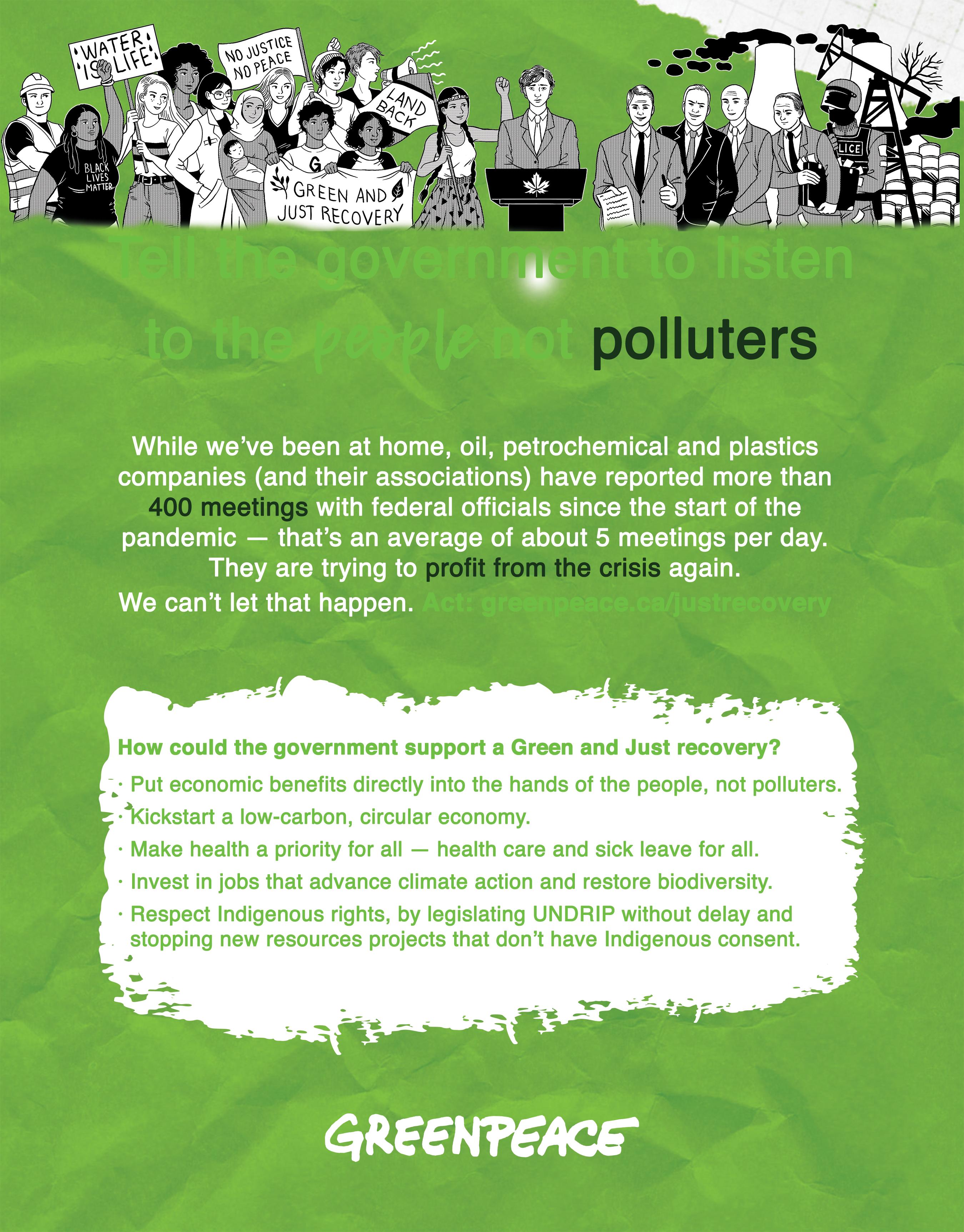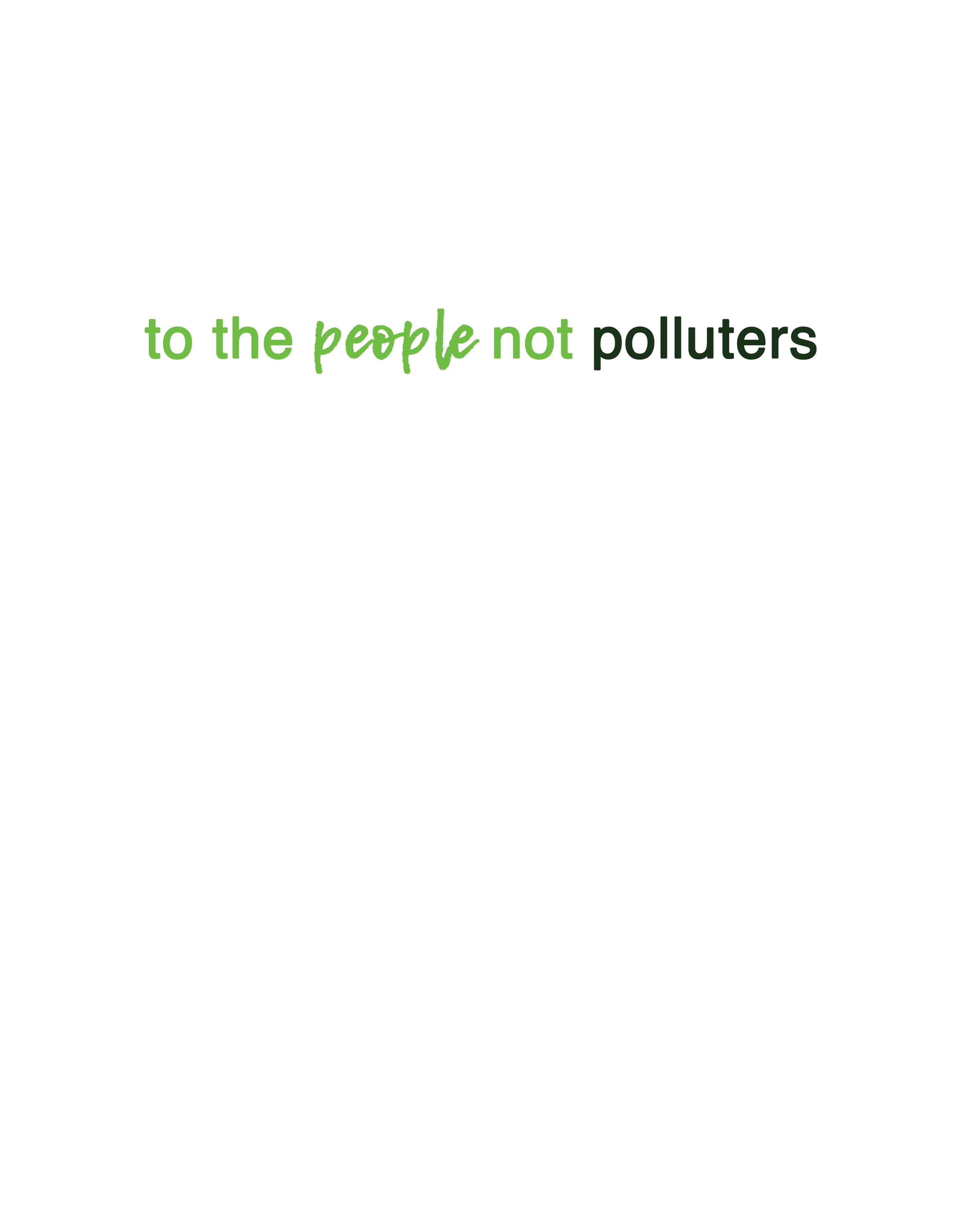








WHEN I WAS A CHILD there was a single fir tree in our front yard and across the street, where my grandparents lived, was a magnificent weeping willow. These two trees, almost forgotten until now, were the first of many that would make a difference in my life. As I sit here thinking about what trees mean to me, the memories flow. I don’t recall if I was five, six, or seven… or perhaps it was all of those years, but I vividly remember sitting at the top of the fir. I would climb right up until the branches became so small I couldn’t be sure they wouldn’t snap under my weight. I took my chances. I wanted to hide, camouflaged, or at least I imagined so. There I would sit like an owl, quietly watching the goings-on up and down the suburban street until my mother called, pretending to look for me. That tree was my place to be alone with my thoughts.
The weeping willow, on the other hand, was the tree where my young social life came alive. It was a beauty with long flowing branches. My sister, my cousin Jaime, and the neighbourhood kids would come to swing on its pendulous branchlets. We would laugh, swing, jump, and chase each other under its canopy.
As I grew, my relationship with trees changed, there were tree forts to build, furniture to refinish, things that needed building, and sticks that held marshmallows around campfires with my own kids. There were also the dozens and dozens of hikes through remote areas and national parks, and the time my kids wandered into the bush behind my house and got lost. Of course, I found them, huddled under a tree.
from the air, they improve water quality and reduce flooding and erosion. They are the keepers of biodiversity whether one single tree, or a forest of trees. With this edition of Saving Earth Magazine, we aim to emulate the Lorax and speak for trees.
In this issue we join with Sierra Club BC to help stop clear-cut logging of BC old growth. We look at the devastating wildfires that have recently occurred, and learn about replanting trees with One Tree Planted. We explore a nature-based economy with Greenpeace, and speak with Minto Roy from Social Print Paper about environmentally-friendly paper. We also look at Community Forestry Concessions and how they can prevent narco-deforestation in Guatemala, and include a special report from our journalist Sergio Izquierdo on palm oil plantation pollution. David Suzuki joins us on the topic of decolonization, and Jan Lee gives us an inside look at mangrove forests. We study tree trunks with FLAAR Mesoamerica and look at how parrots in Belize disperse seeds and help the forests grow. We look at the benefits of hemp with Hemp Save the World, talk gift wrap with Green Okanagan, and look at how trees create oxygen with educator Ingrith León in Teaching Science.

During those times I did not think about the science of trees. I just admired their beauty. Today I still admire their striking forms, but I am also aware of how fundamental they are. Nothing lives without the trees. They provide us with oxygen, they filter contaminants

Our next edition will be dedicated to climate change. We are inviting Climate Reality Leaders to join us in this special edition, helping to bring awareness to the climate crisis in order to invoke policy changes, and fight for this planet.
If you want to participate in Saving Earth, whether through content contributions, advertising, sponsorship or as a member please contact me at teena@savingearthmagazine.com.
Thank you for Saving Earth
, Teena Clipston, publisher of Saving Earth Magazine and Climate Reality LeaderPUBLISHED BY SAVING EARTH
EDITOR-IN-CHIEF
Teena Clipston
SENIOR EDITOR
Cassie Pearse
EDITORIAL ASSISTANT
Dean Unger
GRAPHIC DESIGN
Cassandra Redding
ADVERTISING
Anne-Marie Freeman
CONTRIBUTORS
Kayla Bruce, Roslyne Buchanan, Teena Clipston, Alex Fullerton, Nicholas Hellmuth, Sergio Izquierdo, Colette Kase, Olivier Kölmel, Jan Lee, Ingrith León, Shayne Meechan, Cassie Pearse, Tara Pilling, David Suzuki, Dean Unger, Meaghan Weeden
PRINTING
Royal Printers
DISTRIBUTION
Magazines Canada & Royal Printers
SPECIAL THANKS
to the Hitz Foundation for their generous donation.
COVER PHOTO
Benedek
Saving Earth Magazine has made every effort to make sure that its content is accurate on the date of publication. The opinions expressed in the articles are those of the author(s) and do not necessarily reflect the opinions of the publisher or editor. Information contained in the magazine has been obtained by the authors from sources believed to be reliable. You may email us at Saving Earth Magazine for source information. Saving Earth Magazine, its publisher, editor, and its authors are not responsible for any errors, omissions, or claims for damages, and accepts no liability for any loss or damage of any kind. The published material, advertising, advertorials, editorials, and all other content is published in good faith.
©Copyright 2020 Saving Earth. All rights reserved. Saving Earth Magazine is fully protected by copyright law and nothing herein can be reproduced wholly or in part without written consent.
PRINTED IN CANADA savingearthmagazine.com
info@savingearthmagazine.com
Phone: 250-754-1599
ISSN 2563-3139 (Print)
ISSN 2563-3147 (Online)
Library and Archives Canada, Government of Canada
Saving Earth Magazine focuses on environmental issues, green businesses, conservation, human rights, and climate science. It inspires readers to change how they interact with the planet and offers solutions to global environmental challenges that we face. Some of these solutions include directing readers to organizations and businesses that are making a difference, giving them the ability to support and follow the issues they care most deeply about.
Across the world, we see a groundswell of people engaging to protect their environment, from governments banning plastic bags to individuals inventing exciting new green technologies and Saving Earth Magazine is becoming a part of this step-change. There has never been a more crucial time for this magazine. We don’t just want to report the conversation, we plan on creating the conversation!
At Saving Earth Magazine, we strive to create and bring together ideas that have the power to transform the way we interact with the planet – to devise, communicate, educate, share and help implement strategies and new technologies, which reduce pollution, reduce greenhouse gases, nurture and protect flora and fauna, and protect the waterways.
With contributions from experts and fieldworkers from around the globe, we seek to inspire individuals and organizations to become motivated to protect the planet. We cover stories of success in pioneering fields of ecology and environmental sciences; stories from communities that have faced challenges and found equitable, sustainable solutions that the world should replicate; and inspirational human interest stories and biographies that serve to inspire our lives and help us reconnect to the Earth.
By sharing ideas about how we can make a better world, we will help to heal communities and support those who are at the forefront of ecological and environmental research. Saving Earth Magazine is a manual that can be referenced globally, and will provide an evolving canvas of themes, information and ideas, which will inspire a new era of human interaction with the planet. It is a public forum where ideas and dialogue help to shape our thinking in these emerging fields. It will help us rethink the way we interact with the planet as we seek to find solutions in the transition from fossil fuels, and into new vistas of renewable energy and resources.
FACEBOOK.COM/SAVINGEARTHMAG
INSTAGRAM: @SAVINGEARTHMAG
PRINTED ON
TWITTER: @SAVINGEARTHMAG
ISSUU.COM/SAVINGEARTHMAGAZINE
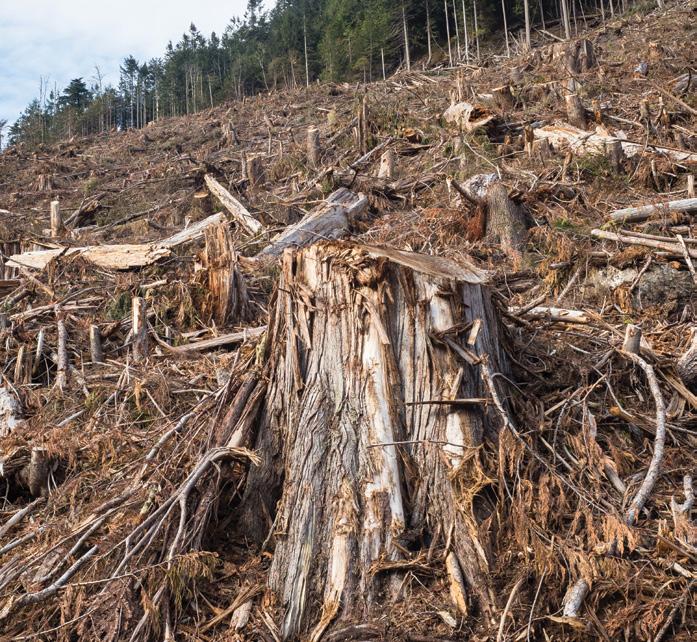

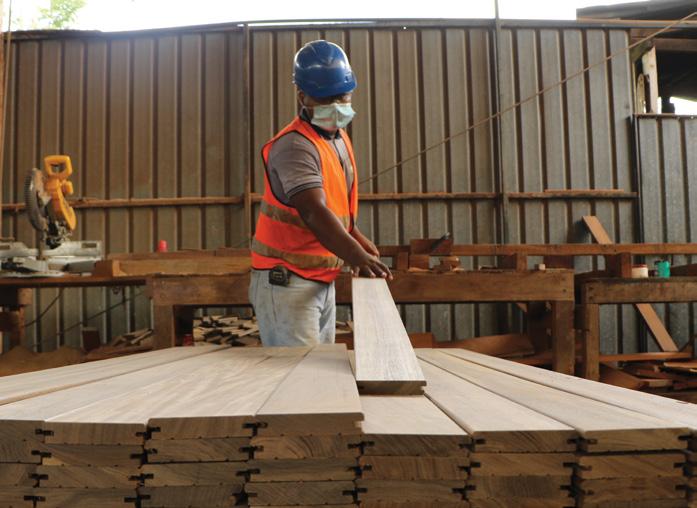
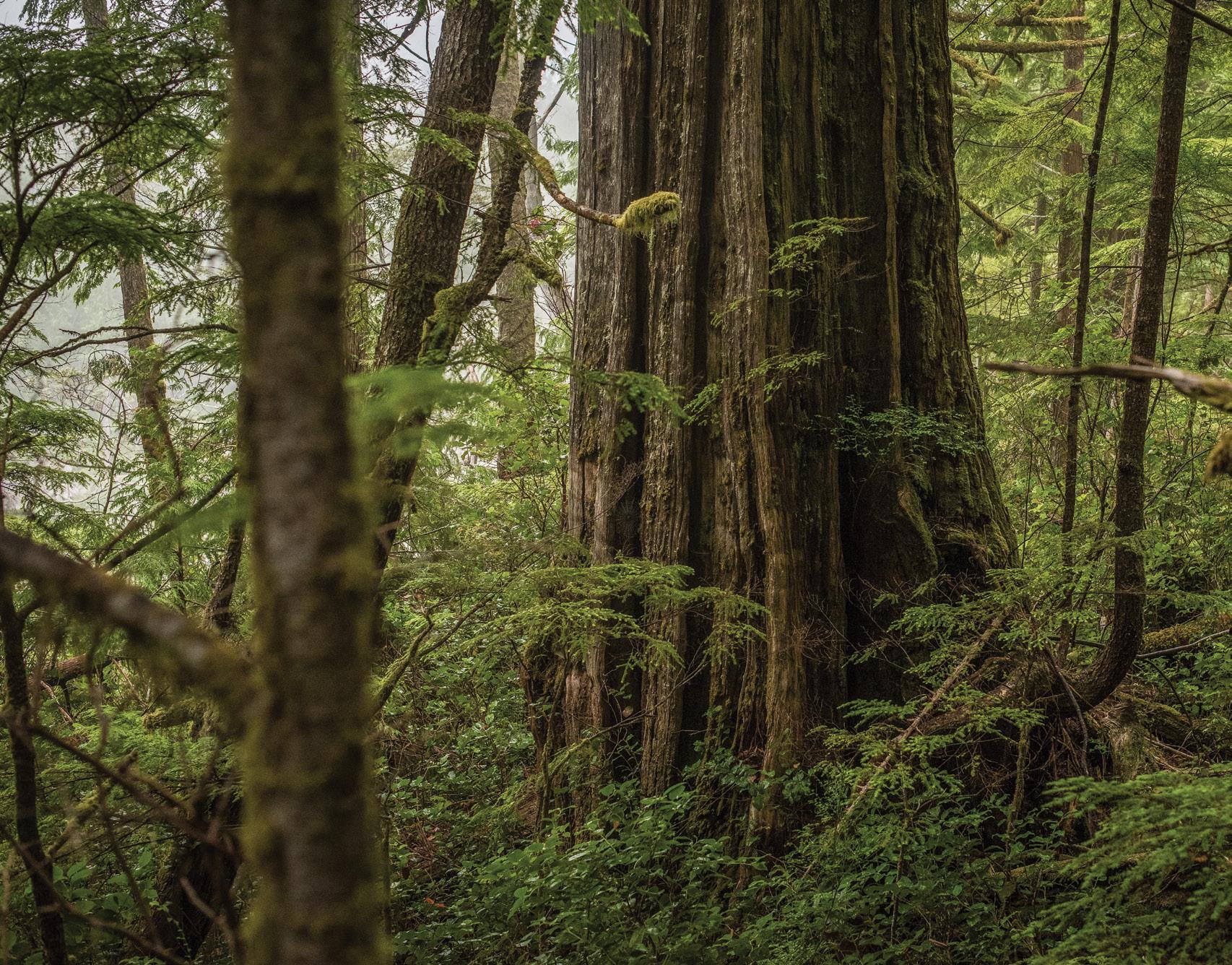
The issue of old-growth logging has reached critical mass in British Columbia. Seasoned environmentalists and scientists say we're out of time, and the provincial government has so far failed to act... again.
With BC old-growth apparently still on the menu despite decades of opposition and conflict, logging companies and the agency that is charged with oversight and licensing of a portion of the province's merchantable timber have their sights set on some of the last remaining old-growth forests of British Columbia — both in the interior, and on Vancouver Island. Recent reports among environmental agencies, from scientists, and in many community newspapers, have also surfaced, which indicate a long history of neglect and short-sightedness by the government agencies charged with managing the province's forests.
Both an independent scientific report, published in June 2020, and a new strategic review commissioned by the BC government and prepared by an independent panel of two foresters, support the view that BC’s most endangered old growth forests, defined as those forest areas with less than ten percent of their area covered in old growth, must be protected now, to avoid irreversible damage and biodiversity collapse in this unique ecosystem.
Conservation North’s, Michelle Connolly, said that BC has “failed to meet a basic and straightforward recommendation by scientists and their own appointed panel, which is to stop harvesting the rarest old growth forests immediately.” Connolly's frustration comes after decades of controversy about logging, preserving old-growth forests and sensitive habitat areas.
A story by Narwhal Magazine, published in October 2019, revealed the BC Timber Sales office was found to be violating old-growth logging rules. The BC Timber Sales (BCTS) office is a division of the Ministry of Forests, Lands, and National Resource Operations and Rural Development (FLNRORD). This agency plans, manages and issues logging permits for approximately 20 percent of the province’s merchantable timber, which is located on Crown lands and which fall outside of forestry tenures.
To combat mounting public opinion, in September 2020 the BC Government announced a new approach to old-growth logging. The Times Colonist carried the story, stating the protection of the province's old-growth forests requires a united effort of groups, industries and people who have often disagreed over land-use issues. Forests Minister, Doug Donaldson, claims the government wants to break



from the confrontational past, and now fully involve environmental groups, Indigenous leaders, forest companies, labour organizations and communities, while working together to protect forests and support jobs. However, many say it's likely another case of “talk-and-log”.
In an interview with Saving Earth Magazine, Senior Forest and Climate Science Advisor for Sierra Club BC, Jens Wieting, said British Columbians are not being forced to watch helplessly while the last old-growth forests are logged. “This is the time to keep the pressure up,” he insists. “Why? We are witnessing a number of tipping points simultaneously. Tipping points make it impossible to maintain the delusion that BC’s forests are well-managed, a point made very clear in the damning findings of the independent old-growth panel, which submitted its report to the BC government in the spring of 2020.”
Wieting points out that for decades successive BC governments, and the industry they support, have remained in denial about the inevitable impacts of harvesting the last old-growth forests. “Denial about the impacts for the web of life, the cultural values of Indigenous Peoples, gifts that the forests provide, and that we all depend uponlike clean water and a stable climate - and ultimately [the impacts] on forestry workers once the last big trees are gone. They [the industry]
stayed in denial about the growing support for social justice and what it really means to respect the rights of Indigenous Peoples and to work with their respective governments. The BC government brought into force legislation to implement the United Nations Declaration on the Rights of Indigenous Peoples (UNDRIP), but is still seeking to maintain business as usual for as long as possible, rejecting the reality that token consultation before clearcutting is no longer an option.
“They are in denial about the speed of ecosystem breakdown, resulting in an ever-increasing cost for logging the last intact forests, more loss of species and more loss of environmental services like clean air and clean water. Cutting the last ten percent of big, old trees has worse consequences than cutting the first ten percent,” Wieting warned.
He went on to point out that the industry players are in denial about the dangers of the climate crisis, and what continued logging of the last old-growth forests means for communities threatened by
droughts, flooding, landslides, heat waves and wildfires, all of which are made worse by continued clearcutting. “They are in denial about the anger of concerned citizens fully aware of the crisis and unwilling to see the last big trees cut down, rising up to defend the last stands,” Wieting stated, “like the two men who were on hunger strike this summer, and the ongoing blockades of logging roads near Fairy Creek, in Pacheedaht territory, on Southern Vancouver Island. All of these factors led to the fate of BC’s last old-growth forests becoming an election issue in the 2020 snap election. Both the Green Party and, with some delay, the NDP, promised to implement all of the 14 recommendations of the old-growth panel (while the Liberals stayed silent on increasing protection).
Back in 2002, following a concerted lobby effort by forest industry interests, Gordon Campbell's Liberal government (in power from 2001 – 2011) replaced the Forest Practices Code with the Forest and Range Practices Act and, as outlined in a story published in September 2020, in the Tyee, “Oversight was outsourced to “qualified professionals” working for timber companies — effectively privatizing public forests. From 2004 on, conservation could only happen “without unduly reducing the supply of timber.”
To counter the prospect of vast deregulation, several environmental groups rallied to take an eleventh-hour run at old-growth deforestation. Sierra Club BC, for one, was deeply concerned that the initiative was a continuance of prior methods, and would take forest policy in a direction that "tosses fundamental elements of forest management to the industry." Now, eighteen years later, it's evident they were right to be concerned.
An ENS Newswire story , in May 2002, detailed that Campbell, and then Forest Minister, Mike DeJong, used principles identical to those that underlie the environmental policies of the Bush administration south of the border, and that [logging] companies would “have lots of leeway” when it came to regulatory expectations and in deciding how to meet them.” Specifically, according to the ENS story, DeJong said that the new code will "avoid dictating" to timber companies how results are to be achieved. Instead, companies "will determine the most appropriate methods to use.”
Essentially, the historical record shows that the Liberal Party indeed deregulated the industry and put the final chapter on the elimination of smaller mom-and-pop logging outfits.
Now, environmental organizations, scientists and policy makers are voicing strong opposition as the present NDP party continues to break its own rules and is stripping the province of its last remaining old-growth.
In an October 2019 story on logging in the Nahmint Valley, in Narwhal Magazine, journalist, Judith Lavoie stated, that allowances by the BC Timber Sales office were indicative of a truly corrupt system. “Two investigations, released under Freedom of Information laws, showed the agency had ignored best practices and available data when auctioning cutblocks in the Nahmint Valley — home to some of Vancouver Island’s last remaining stands of un-logged ancient forest.”
The BCTS office, intended to be an independent agency charged with monitoring timber licenses and allotments, was found to be grossly negligent in its duties regarding logging in the Nahmint Valley. Since then, evidence of questionable conduct by the BCTS continues to surface. Conclusions from both of the reports referenced above, determined the agency was derelict in its duties and mismanaged the forests in its charge, in particular, old-growth forests.
Yet despite widespread opposition and challenges from environmental agencies such as Sierra Club BC, Greenpeace, and the Ancient Forest Alliance, who are calling the provincial government out on its failure to ensure sustainable forestry practices, the provincial agency continues to permit logging in contested and formerly restricted areas.
The problem has been clearly stated on numerous occasions, yet many are left wondering, where are the levers of democratic process? A cursory look over the last century reveals a battle between corporate logging interests, a consistently ineffectual government when it comes to old-growth policy, and acceptable public policy. It's clear previous provincial governments receive a failing grade when it comes to reflecting the needs of the environment, and the will of the people.
With respect to provincial government policy regarding BC's forests, the historical profile belies decades of questionable tactics, performance and result. The force of lobby and the questionable and obscure relationship between government and industry, when it comes to the policies that arise from such influence, has grown along-side overreaching deregulation and lax lobby laws and requirements. Add to this the government's historic propensity for creating large profits in raw industry and resource sectors at the expense of creating infrastructure in local economies, and within First Nations' communities. Essentially, this has worn away at the security of communities that depend upon such resources for livelihood, recreation and quality of life.
The bottom line is, profound environmental destruction often comes with such unregulated, unchecked industrial aspirations, where government seems complicit, and the sensibilities of the public are ignored.
On September 11, Forest Minister Donaldson said the province was going to cease logging in 350,000 hectares of old-growth in nine specific areas of the province. However, an independent study titled, “BC’s Old Growth Forest: A Last Stand for Biodiversity”, was released by a group of BC ecologists, who had previously worked for the provincial government.
According to the provincial government, 23 percent (approximately 13 million hectares) of the province's present forests are classified as old-growth. In fact, only three percent of BC forests should be classified as old growth, and within that, only 2.7 percent of the trees are actually old. “The old forests are now all but gone due to intense harvest,” said Rachel Holt, one of the study's authors. She points out that the forest ministries recently announced two-year shutdown of old growth logging is “mostly in areas that were already protected, had already been logged or were not slated for logging at all. I am baffled by that,” she said in an interview with Narwhal Magazine. She called the government’s framing of the data “very misleading.”
Donaldson’s announcement was issued alongside the province’s own report, titled, A New Future for Old Forests. Meanwhile, Holt, and her coauthors, Daust and Price, insist the province had misled the public for decades, by over-counting old-growth. They feel the report was generally accurate, but that the province’s first step in implementation was all wrong. A New Future for Old Forests confirms the province has not managed old-growth forests properly for many years, and had been working with an outdated approach. The report also states that ecosystem health and biodiversity must become a priority.
According to Narwhal, Price, Holt and Daust have called upon the province to implement an immediate moratorium on harvesting old and mature forest in ecosystems with less than ten percent of old forest

remaining, even if they fall within existing cutblock permits. They are also asking the government to increase old-growth retention targets and improve old-growth management areas.
Wieting says it's pretty clear that successive provincial governments have worked to create an illusion that forests are well managed, that we have strong laws and sustainable forestry, but the reality on the ground brings the house of cards down. “The evidence in the form of data and mapping is overwhelming,“ he said. “Few people remain in denial about the facts when only three percent of old-growth forests with very big trees remain standing.”
A November 2019 poll commissioned by the Sierra Club showed there is widespread support for the protection of old-growth forests across British Columbia and that 92 percent of British Columbians want old growth forests protected.
Over the last two decades, governments in North America seem to have shifted from oversight of public good and community interest, into mechanisms of industry, to be plied and coerced, via donation, to look out primarily for industry interests. This is true in the province of British Columbia, and within Canada in general, where the weight of force has also transitioned largely to commerce and industry, over equitable policy.
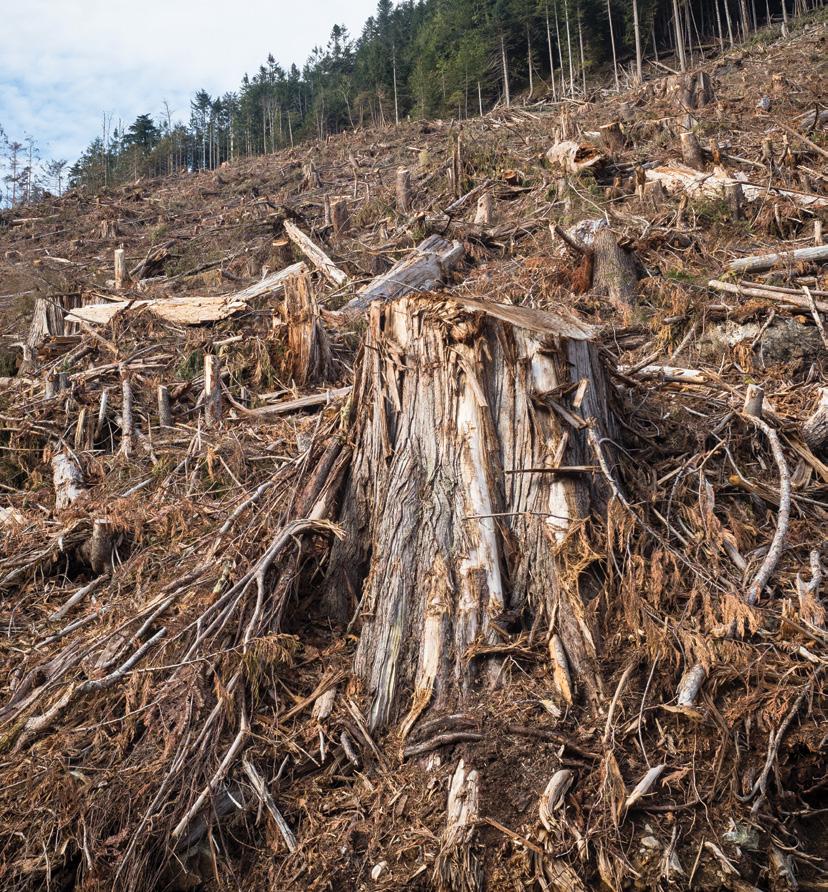
In 2018, Attorney General, David Eby, (NDP) told the people of BC that the province would take adequate measures to ensure greater transparency. Andrew Weaver, BC Green Party leader, agreed, saying, “These changes will improve accountability in government decision making. [These] rules will strengthen the integrity of the decisions made in Victoria, while ensuring that the lobbying industry adheres to high ethical standards."
“Big money and political insiders have had too much influence for too long,” Eby said. “These changes are long overdue and build on our continuing work to strengthen BC’s democracy for all British Columbians.”
The changes he is referencing regard efforts to air out decades of dirty government laundry when it comes to logging, and to stem the unbridled influence of big business. Bill 54 was part of this initiative. It's a somewhat subversive history that extends back to the 1950s, and was described in painful detail, in Joe Garner's 1991 book, Never Under the Table. It details decades of corruption, extortion, and bribery in the logging industry on Vancouver Island from the 1950s onward, much of it landing at the feet of the various provincial governments over the years.
The question is, why do so many loopholes persist? The Narwhal story points out that Duff Conacher, coordinator of Democracy Watch, an Ottawa not-for-profit focused on making Canadian governments and corporations more accountable, “has a disturbing explanation for why the NDP has talked tough on cleaning up lobbying yet
failed to go the full distance. There’s no other reason to leave the loopholes open, except that government wants secret, unethical lobbying, so they can do secret deals behind closed doors with interests they favour. There is now a publicly accessible, searchable database that provides a window into how government works, including the thousands of lobbying records of former BC politicians-turned-advocates.”
A 2017 Corporate Mapping Project concludes that “BC stands out in Canada in terms of its weak regulations against corporations influencing public policy. The report also found 'substantial overlap' between the top corporate political donors and the most frequent lobbyists — suggesting the two practices “work in tandem” to ensure companies with ample resources can leverage those resources to gain the ear of politicians.” To date, no major changes to lobby and gerrymandering laws have been exacted.
Couverdon, the real estate arm of TimberWest, was created to maximize revenue as land values outweigh the value of timber. As actual forestry has shrunk dramatically, with mill closures, raw log exports and with the prospect of declining forestry jobs, the company has morphed into real estate development. How will this affect long-term sustainability of land and company? For many, it has raised further concerns about a sustainable future, log supplies and jobs for forestry workers. “Combined, these two forestry companies (Timber West and Western Forest Products) own approximately 1,439,200 acres of Vancouver Island land,” wrote Ceritanne, in the Watershed Sentinel (March 2014), “and both are transforming themselves into real estate development companies and selling off their land.” Despite much misgiving about the way these logging companies came into possession of almost the entire of Vancouver Island, nothing has been done to address the issue.
Many of our scientists, and the public at large, appear to be in agreement with the conclusions of the old-growth review panel, when it declares the need for an immediate moratorium for old-growth sites while effective strategies are found. It is widely agreed that there must be provincial government control over BC Timber Sales’ planning and operations, to accelerate conservation of endangered old-growth forests. An effective Old-Growth Forest Protection Act should be put into force, and a science-based legislated plan that includes targets and timelines for protecting old-growth in all forest types and based on the best available science-based criteria.
Further, a sustainable, value-added second-growth forest industry must be supported by implementing regulations or tax incentives to retool old-growth mills and to process second-growth logs. The report recommends forgoing the provincial sales tax on new mill equipment, reducing stumpage fees or property taxes for companies which invest in second-growth mills. Using stumpage fees to expand markets for sustainable, value-added, eco-certified, second-growth forest products would go a long way to stopping the marketing of old-growth and raw logs. Raw log exports would be curtailed by actually banning oldgrowth log exports and increasing the fee-in-lieu (i.e. log exports tax) on second-growth log exports. Increased First Nations' input is also strongly advocated.
“For the first time in decades, we have a coherent path towards protecting the last old-growth forests across the province, with a timeline for implementation within three years, “Wieting said. “Working with indigenous decision-makers, the next BC government has to demonstrate accountability to deliver on this promise from day one. It will depend on all British Columbians to keep the pressure up, to make the old-growth panel plan a reality. Forests are giving us immeasurable benefits. It’s time to give back to the forests that sustain us.”


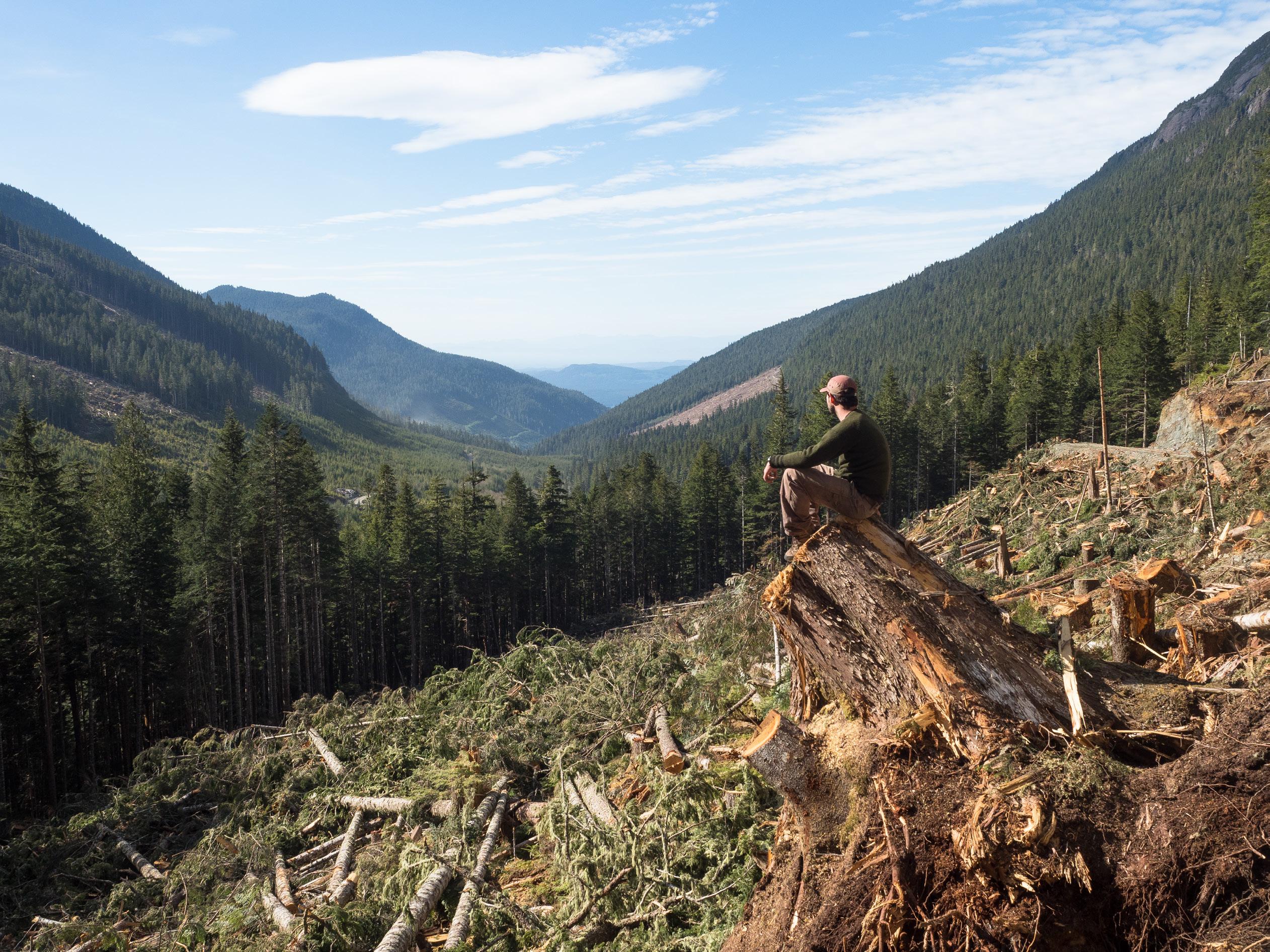
It’s not too late. You can help protect the last remaining ancient forests. Take action today at sierraclub.bc.ca/OldGrowth
 Photos by Sierra Club BC and Louis Bockner
Photos by Sierra Club BC and Louis Bockner
Amesmerizing spectacle of vivid oranges and reds, a cacophony of crackling and roaring, fire has commanded our attention from the beginning. One moment fire offers warmth to our weary bones and energy to heat our food, while the next it challenges our existence.
Trees are complicit in this dichotomy. Trees are a key component in the “fire triangle” as fuel, one of the three elements required for a fire to burn in collaboration with heat and oxygen. How the wildfire develops depends on the interaction of fuel (needles, leaves, twigs, trees and deadfall), weather and the topography.
While that is the science of it, devastating headlines blaze across our news and social media sources in 2020 as wildfires burn forests in record-breaking proportions in California, Colorado, the Pacific Northwest and in the Amazon rainforest. Meanwhile the toll of last season’s wildfires in Australia are still being tallied.
In the United States and Canada, peak fire season tends to run from mid-May to August. It can run from April to October, although it’s unusual to witness such volatility so late in the season. Those of us living in British Columbia were lulled into complacency given wildfire activity here didn’t really heat up until well into August 2020. About
ten kilometres north of my home, the Christie Mountain fire was discovered on August 18. It is thought that lightning caused this interface fire (a fire that can spread to human structures whilst still burning in forests) that burned down a home and some 2,122.5 hectares in difficult terrain before being held September 9. Among those evacuated and others on evacuation alert were friends of mine. It was a stern reminder to remain vigilant. Here, in Western Canada, the 2020 fire season was less severe.
South of the border, in the USA, things are far bleaker. As I write this, wildfires still rage while some headway in containment is finally being made in cooler fall temperatures.
On October 6, CNN and other news sources reported that the “California fire is now a 'gigafire', a rare designation for a blaze that burns at least a million acres. The August Complex is now the largest fire in California's history.” Sadly, this isn’t the only gigafire the USA has suffered. The most recent one, in 2004, burned some 1.3 million acres in Alaska’s Taylor Complex. In Australia, earlier this year, we witnessed a gigafire burn roughly 1.5 million acres when two fires merged.

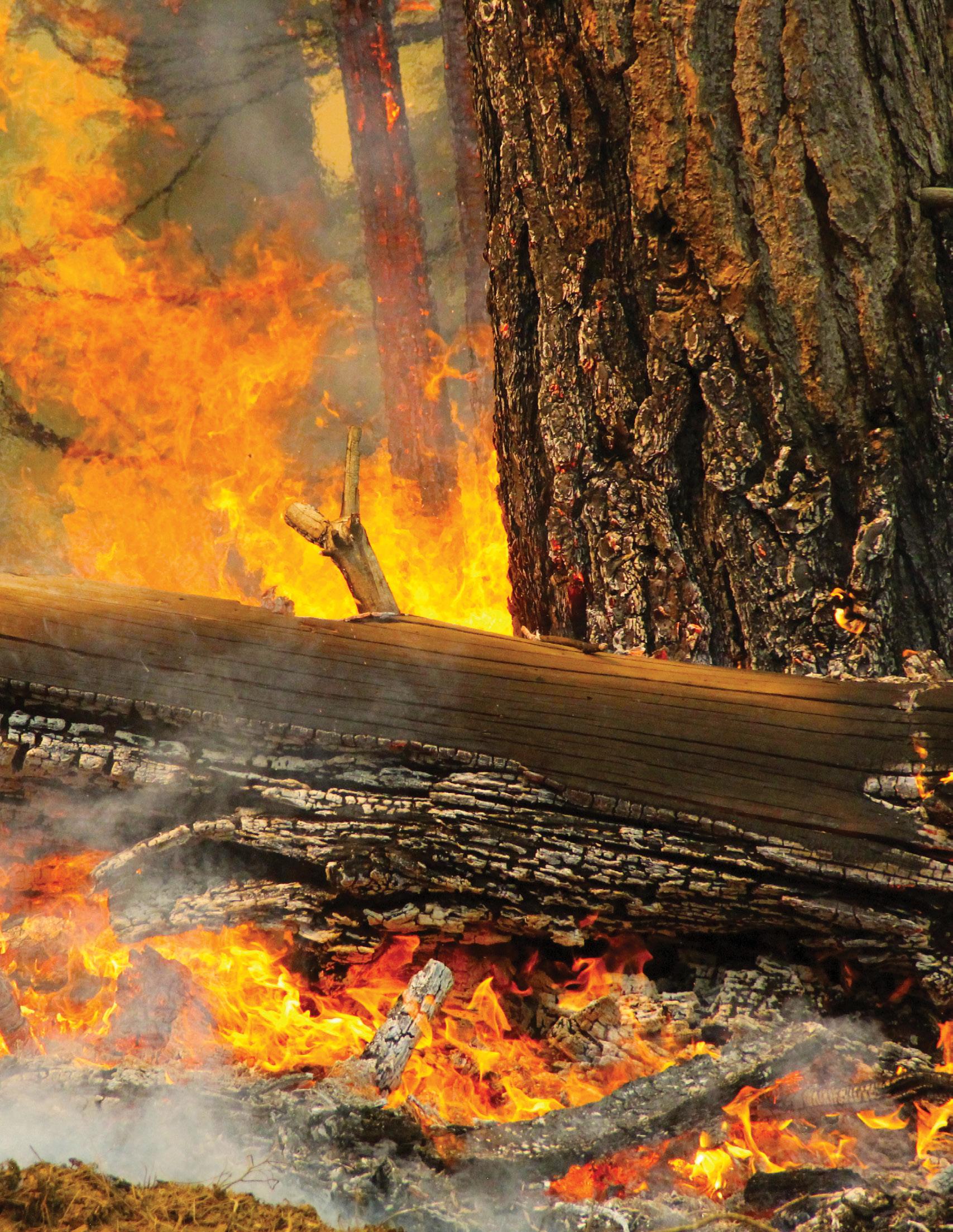 Photography: J Bartlett, Team Rubicon/BLM for USFS
Photography: J Bartlett, Team Rubicon/BLM for USFS
For California, the gigafire designation is in addition to a number of records already set. The more than four million acres burned so far in 2020 is over double the previous record set in 2018. Statistics researched by CNN meteorologist Robert Shackelford indicate, “California wildfires have increased in size eightfold since the 1970s, and the annual area burned by fires has increased by nearly 500 percent.”
Signs point to global warming as a huge contributor to the factors causing these record blazes. “Humancaused climate change was creating higher temperature extremes and drier vegetation, conditions conducive to deadlier and more destructive wildfires,” explained Daniel Swain, climate scientist at UCLA and the National Center for Atmospheric Research to CNN.
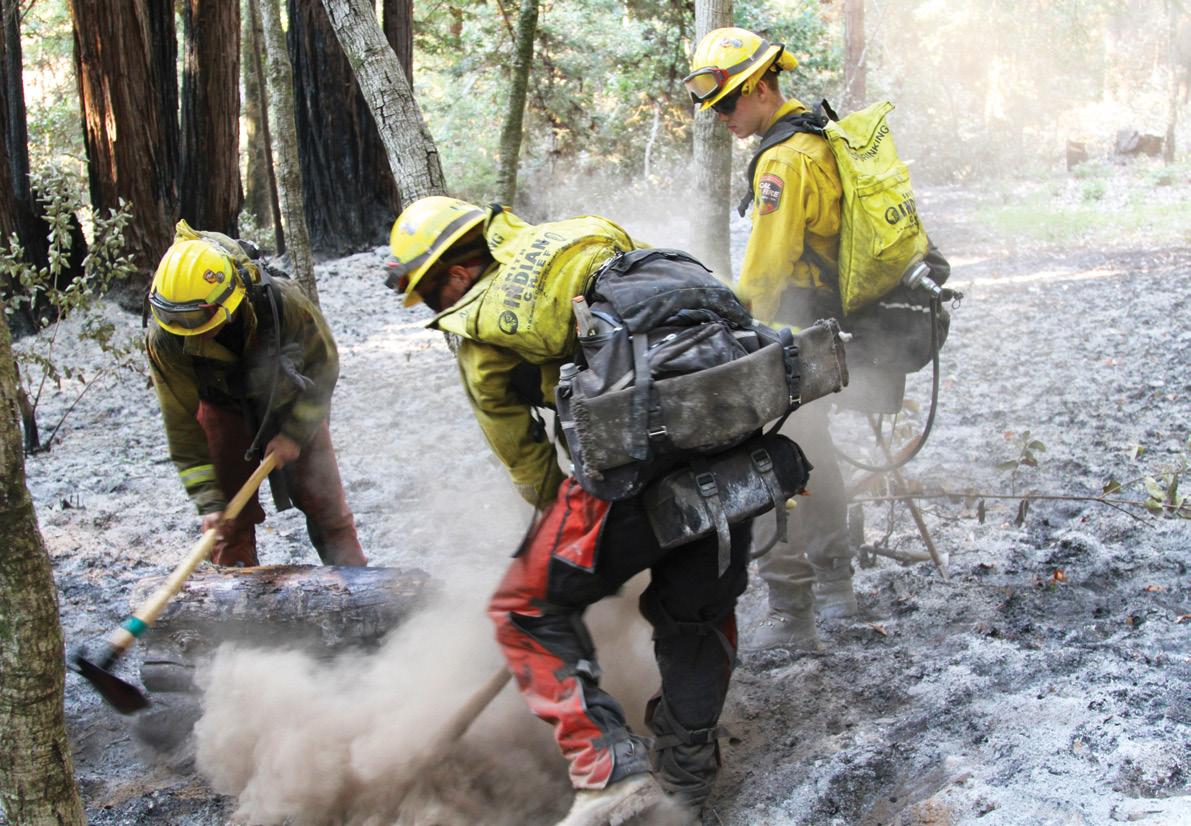
Climate change as a factor in the increasing severity of wildfires becomes even more compelling looking at new patterns in precipitation, both snow and rain, ocean temperatures, greenhouse gases, vegetation shifts across the planet, and other fluctuations from historic norms.
Heartbreaking 2020 impacts tallied to date in California include loss of life of 31 people, more than 8,400 buildings burned, among them homes and businesses such as world-renowned Napa and Sonoma wineries, and with so much habitat destroyed, countless wildlife displaced or killed. Plus, there have been record lows in air quality as dense smoke drifted into major cities from San Francisco and into Canada, blocking the sun and creating effects yet to be fully assessed.
The Glass Fire burning in California’s wine country remains a top priority and at time of writing, it is only 50 percent contained. Cal Fire, on October 6 said that 290 Napa County houses and 321 commercial structures were destroyed. Residential destruction was greater in Sonoma County where 310 single-family houses were lost, but only 12 commercial structures were destroyed.
In some areas, mandatory evacuations have been lifted and residents have returned home. Through my friend, Inga Aksamit, a California-based author, who lives in Kenwood, I’ve watched the saga unfold via our Facebook connection.
While we can peruse the numbers and try to imagine the toll it has taken on individuals and businesses, hearing your friend’s firsthand account rips into your soul why we must take measures to mitigate these fires.
With her permission I share her Facebook post upon returning home from mandatory evacuation:
“What's it like to be home? Good and not good. Good to come back and have the house standing. Wonderful to see neighbors and share stories. But sobering to see charred hillsides once again, some blackened and some eerily white from intense heat. A huge sign in Hwy 12 directs trucks to a PG &E "Base Camp". It's an enormous field with large rolls of cable and
piles of equipment needed to erect new poles and string new electrical wire. Houses and ranches are missing — just blank spaces. I wanted to come home yet I didn't want to see what I had to see. I know it will be tempting for some of you to talk about recovery and spring wildflowers and the longterm health of the forest. Yes, we know. We just did this three years ago and neighboring areas did it two years ago and last year. We're resilient and we'll get through it but it's hard to see. Part of this feels too familiar but I don't think any of us feel the same as last time. It's not new anymore. Last time every day was uncharted territory. Now we know too much. There are many questions about how to live in this new version of the world and I have no answers. I'm so sorry for all of our neighbors and beyond who lost their homes. I wish I could hug everyone I see like we did last time but we can't even do that.”
She also said she witnessed:
“more talk among my friends wondering about how much more we can take and perhaps considering a move, but where? We run down various lists and know that fire can be everywhere in the west where we want to be — California, Washington, Oregon, BC and even Alaska and the Yukon. And the worsening hurricanes and tornadoes, floods, sea rise, etcetera. Climate change is here.”
Aksamit is right. It is not an isolated incident. In the United States in early October according to the Insurance Information Institute, 65 large fires are burning in California, Idaho, Montana, Oregon, Washington and five other states. Oregon fires also resulted in at least 11 deaths, thousands evacuated from their homes, 3,000-plus buildings burned and whole towns decimated.
To review the complete lists of all active wildfires across the United States, visit the National Interagency Fire Center website (FIFChttps://www.nifc.gov/). For lists of Canada’s fires, visit the National Wildland Fire Situation Report (https://cwfis.cfs.nrcan.gc.ca/report).
We are not alone. Worldwide, the news is also devastating.
Statistics published by the Parliament of Australia speaks to the devastation:
• 33 people died including nine firefighters
• 3,094 houses were lost across New South Wales (NSW), Victoria, Queensland, Australian Capital Territory (ACT), Western Australia and South Australia.
• Over 17 million hectares were burned.
• Park lands and reserves were devastated, impacting natural flora and fauna. In NSW, World Heritage property including more than 80 percent in Greater Blue Mountains and 54 per cent in Gondwana Rainforests of Australia had been affected by fire.
• In its Annual Climate Statement 2019, the Bureau of Meteorology noted ‘The extensive and long-lived fires appear to be the largest in scale in the modern record in New South Wales, while the total area burnt appears to be the largest in a single recorded fire season for eastern Australia’.
• Conservative estimates of how many animals died using numbers just from NSW and Victoria projected losses of over one billion mammals, birds and reptiles combined. Loss of insects were reported in the hundreds of billions.
• While the impact on many rare or threatened animals, plants and insects is yet to be fully determined, various modelling projects some losses of species could be permanent. From this analysis, a provisional list of 113 animal species were identified as highest priorities for urgent management intervention.
• Lightning was deemed the predominant natural source of the bushfires – about half the ignitions. The remaining ignitions are attributed to accidental or deliberate human origin.
As reported by Al Jazeera, “The Brazilian Amazon is experiencing its worst rash of fires in nearly 10 years, data from space research agency INPE shows. Last month, INPE satellites recorded 32,017 hotspots in the world’s largest rainforest, a 61 percent increase compared with the same month in 2019.”
Often called “lungs of the Earth”, the Amazon is experiencing some “28,892 active fires in the Amazon basin alone” as reported by thenewdaily.com.au. Of these, 27 percent of fires in September were burning primeval forests – old-growth forests that had previously been almost completely undisturbed by human activity. Rômulo Batista, Amazon campaigner at Greenpeace Brazil notes, “The fires are not only a threat to climate and biodiversity, the smoke from the fires adds another threat to the health of people living in a country already strained by the COVID-19 crisis.”
Contributing to the increase in fires is deforestation that is linked to President Jair Bolsonaro dismantling environmental laws to allow more commercial operations in formerly protected areas. Farmland and other recently deforested areas are also ablaze as a dry season more severe than last year points to climate change. One factor causing this is moisture being diverted from South America due in part to warming in the tropical North Atlantic Ocean.
CBC News reported in September that Brazil’s Pantanal is on fire despite the fact that “world’s largest tropical wetland is not supposed to burn.” We learned that “A UNESCO heritage site and one of the world's most diverse ecosystems — home to dozens of endangered
species and the densest concentration of jaguars anywhere — is in jeopardy. Charred jaguar carcasses now litter the ground, along with burned alligator-like caimans and fallen birds.”
The Arctic Circle, too, is suffering the effects of climate change with wildfires raging in northeastern Russia. In the Yakutia region record amounts of greenhouse gases released by these fires are contributing to global warming. Remote and vast, Siberia presents additional challenges in battling these blazes fueled by abnormally high temperatures. It’s not just the treetops that are burning, the fires are reaching deep into the ground and thawing permafrost. Coupled with higher temperatures warming the permafrost, these ground fires burn hot for sustained periods thereby contributing to more warming that adds to the climate change crisis.
The grim numbers tallied all across the planet are yet another effective reminder from Mother Nature that what happens in one location has global consequences. Incremental temperature variations in the atmosphere and ocean impact climate. Even the smoke that drifts from fires far away can affect the quality of the air we breathe and sunshine units for vital crops.
While reviewing the trends for wildfires across the planet can be overwhelming, there are absolutely small steps all of us can take to both protect our homes, our societies and our collective future.
In a CBC News interview with Lori Daniels, University of British Columbia forestry professor and wildfire expert said that as we witness the fire seasons extending and fires growing larger “there has been a slow but steady acceptance that more needs to be done to protect homes and property... from wildfire.”
• Responsible forest management can play a role in which deadfall is cleared, trees are thinned and fire breaks are created, especially in potential interface regions.
• Controlled burns have a long history and if managed appropriately have an important role in reforestation and fire mitigation.
• Attention needs to be paid to building and retrofitting homes with more fire-resistant materials.
• Landscaping can be designed to be esthetically pleasing while fire resistant. Xeriscaping strives for that goal and reduces the need for watering, thereby preserving that critical resource.
• Learn your climate science through reputable journalism sites such as:
• The Intergovernmental Panel on Climate Change (ipcc.ch) the United Nations body for assessing the science related to climate change.
• Clinton Foundation (https://www.clintonfoundation.org/ourwork/clinton-climate-initiative)
• The Conversation (theconversation.com) that presents wellresearched articles.
• NASA Global Climate Change (https://climate.nasa.gov/ evidence/)
• Protect Our Winters Alliance (https://protectourwinters.ca/ science-alliance/)
• David Suzuki Foundation (https://davidsuzuki.org/what-youcan-do/what-is-climate-change/)
• Climate Watch (https://www.climatewatchdata.org/)
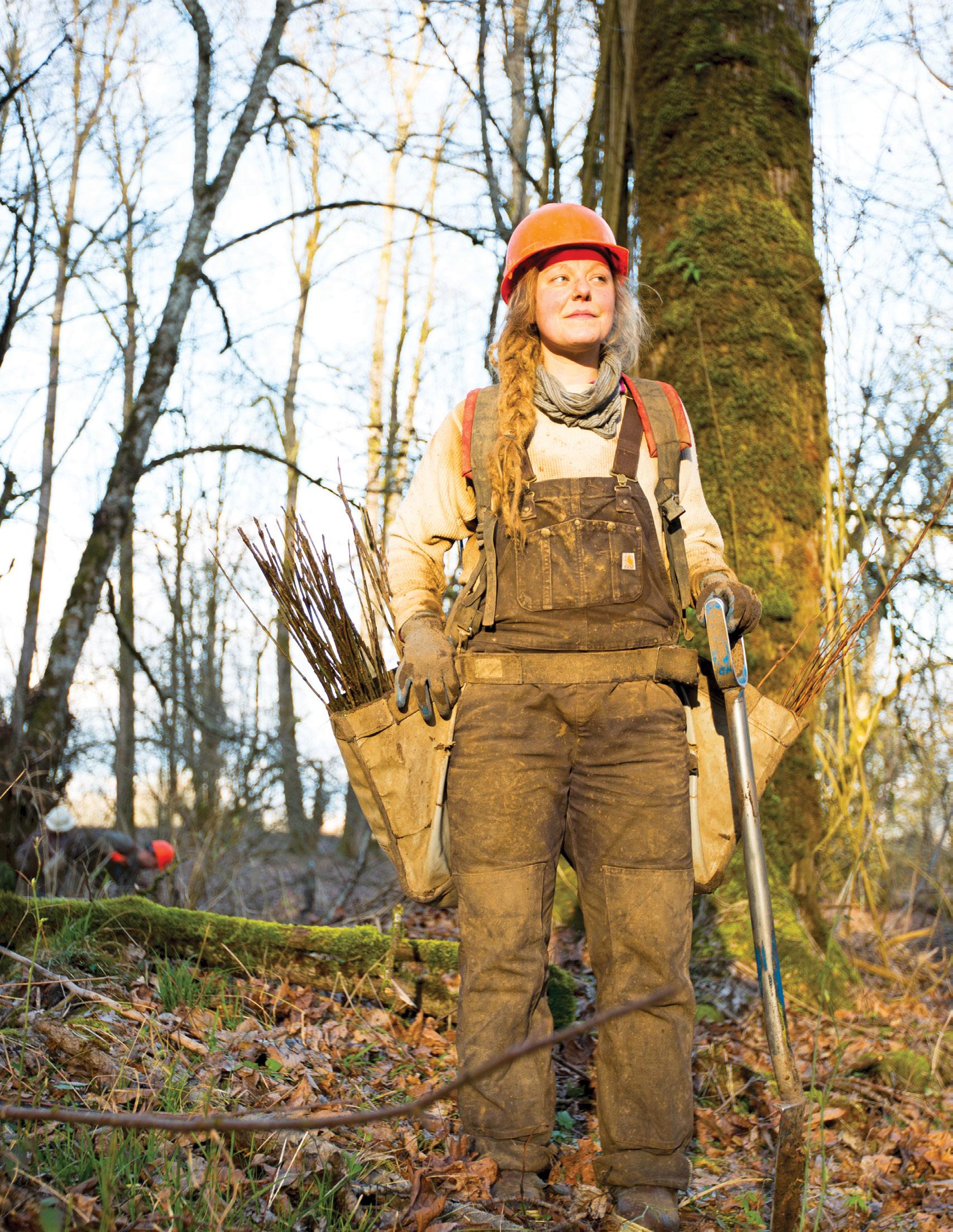 Meichen, a habitat restoration specialist, surveys the planting site in Oregon. Photography: One Tree Planted
By Meaghan Weeden, One Tree Planted
Meichen, a habitat restoration specialist, surveys the planting site in Oregon. Photography: One Tree Planted
By Meaghan Weeden, One Tree Planted
Look up “forest fires,” and the headlines will quickly demonstrate that fires have increased in frequency, severity, and size everywhere from California and Australia to British Columbia, the Amazon Rainforest, and even the Arctic Circle. The causes vary — from decades of fire suppression combined with climate change in California to unregulated slash and burn agriculture in the Amazon and Asia — but the effects are the same. And as the planet’s temperature continues to rise, so too does the risk for future fires.
In many ecosystems, fire plays an important role; in higherlatitude forests, it releases important nutrients into the soil and activates seeds. In tropical forests, local and indigenous communities have used controlled fires for centuries to clear land for agriculture. And from serotinous cones to fire-retardant bark and self-pruning responses, trees have come up with some pretty amazing adaptations in order to thrive in fire prone areas. But what we’re seeing today is at a scale of intensity that nature can’t keep up with. And according to the Food and Agriculture Organization, "each year wildfires destroy 6 to 14 million hectares of fire-sensitive forests worldwide, a rate of loss and degradation comparable to that of destructive logging and agricultural conversion."
When forest fires are relatively small, nature doesn't require intervention because seeds in the soil and natural regeneration from surrounding healthy trees will restock the ecosystem with new seedlings. But when burn scars are severe, or when the closest healthy trees are too far away to spread seeds, planting trees can help to catalyze the natural process so that forests grow once again. That’s where One Tree Planted, a reforestation nonprofit, steps in. During British Columbia’s rank six Hanceville Fire in 2017, the fire burned so hot that it destroyed the native seed stock and created its own weather system. As a result, around 30 percent of the forest wouldn’t have returned without help. Through a partnership with local First Nations communities, One Tree Planted, local contractors, and the British Columbia government’s Forest Carbon Initiative, over one million trees are being restored in this region.
So how do we know when to help and when to simply let nature take its course? For that we turn to fire ecology, or the study of the role of fire in ecosystems. Fire ecologists study the origins of fire, what influences its spread and intensity, best restoration practices, and what happens in nature after fires.
Once fires have stopped burning, environmental professionals will assess the scope of damage, asking questions like these:
• How many trees were killed?
• Was the seed stock destroyed?
• Is the land completely degraded?
• How is the local climate affected?
• Will the ecosystem be able to regenerate on its own?
Based on this and other criteria, they will determine if the forest can regenerate on its own, or if reforestation is necessary. But before tree planting can take place, a few things usually need to happen, such as:
• Removing extra debris like snags (dead trees) and brush that will provide fuel for future fires, while leaving some to provide wind protection and improve water retention for newly planted trees. Some wildlife species, like the black-backed woodpecker, also rely on snags to nest and forage the insects that are drawn to these recently killed trees.
• Assessing the health of the soil, the erosion risk, and remediating as needed. Fires can improve the nutrient profile of the soil by
breaking organic matter down into a usable form. But they also remove the most effective anchor (trees) holding everything together while also exposing the top layer of soil, which increases the risk of everything washing away and causing further damage downstream.
• Selecting the most beneficial tree species — for example, after the Hanceville fire in British Columbia, we included Trembling Aspen, which has a high water content and fewer flammable organic compounds, which can help slow the spread of future fires by creating a natural protective barrier.
It's important to know that in some ecosystems, fire has historically played an important role in shaping and maintaining the landscape. As a result, many native plant and animal species have developed incredible strategies to withstand blazes.
California’s giant sequoias depend on fire to reproduce: their serotinous cones, glued shut with pine resin, need fire to release the seeds inside. And their thick, fire retardant bark protects sensitive inner tissue, allowing it to withstand low-intensity surface fires. Other species with fire-aided dispersal strategies include jack pine, table mountain pine, and lodgepole pine (one of the first to grow after a fire). And many chaparral plants like coffeeberry, long sepal globemallow, and snow brush have coated seeds that require direct or indirect contact with intense heat and smoke to germinate.
Underneath the soil, there is a rich seed bank just waiting for the right opportunity. Species like Indian paintbrush, scarlet gilia, Oregon sunshine, and Washington lily are just a few examples of beautiful fireactivated wildflowers. Even fungi can benefit — and the experienced mushroom hunter knows that recent burn sites are the best place to find morels and boletes!
When gaps are opened in the canopy, some species, like pine grass, gain access to more sunlight. And when brush is cleared from the understory, creating gaps of bare soil, plants such as fireweed quickly colonize them with their lightweight, wind disseminated seeds. Sometimes, fire even changes the composition of the soil itself. When this happens, adaptive plants like Lupines multiply quickly. They typically grow in nitrogen-deficient soils where other plants cannot, but are able to “fix” or add nitrogen back into the soil over time.
Animals have some pretty amazing adaptations, too. In Australia, fire-foraging birds actively start fires to smoke out mammal and insect prey. These so-called fire hawks — black kites, whistling kites, and brown falcons — swipe burning sticks or grasses from fire areas (and sometimes even human cooking fires) and drop them into unburned areas to set them alight. When their prey emerges from the fire seeking safety, the fire hawks benefit.
They are, of course, a notable exception: most wildlife species will instead use intimate knowledge of their home range to outrun or fly away from fires. Those that aren’t able to flee quickly enough, like ground squirrels, frogs, and ants, will burrow deep underground or shelter under rocks and downed logs. Others will wait within nearby bodies of water, returning to consume newly released nutrients and rebuild their homes if possible once the fires have passed.”
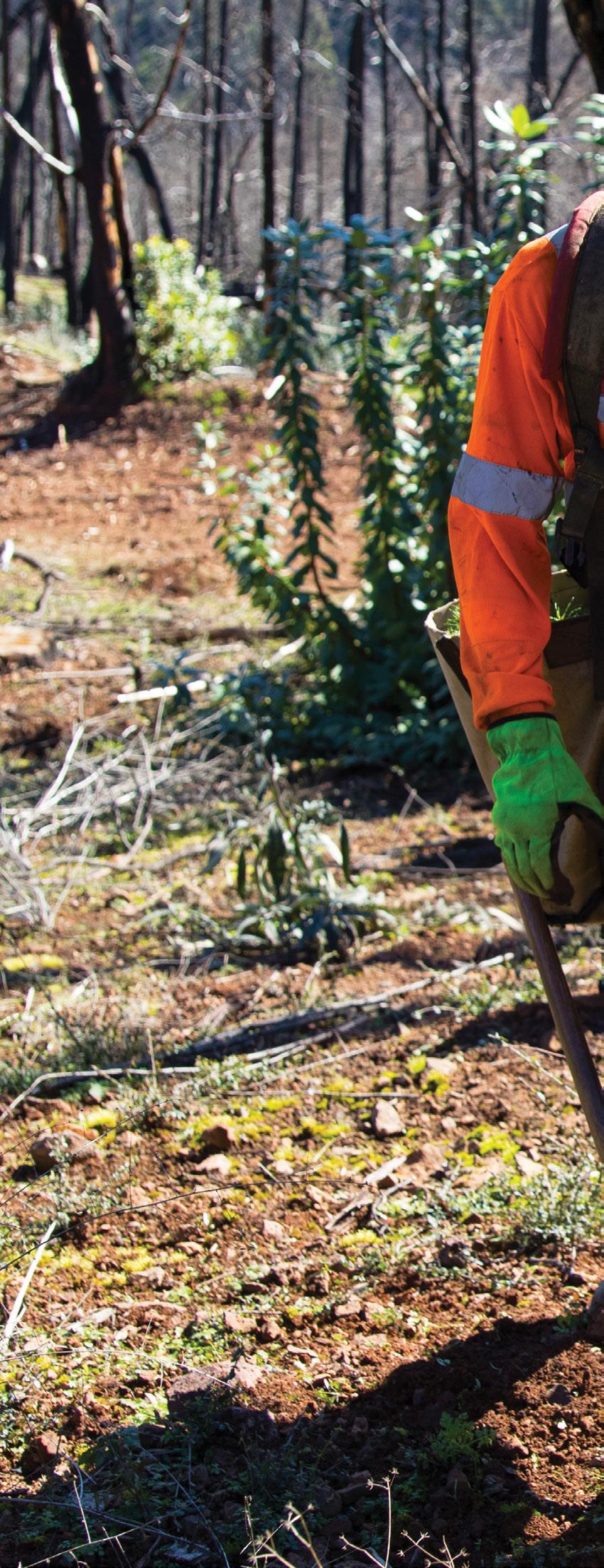
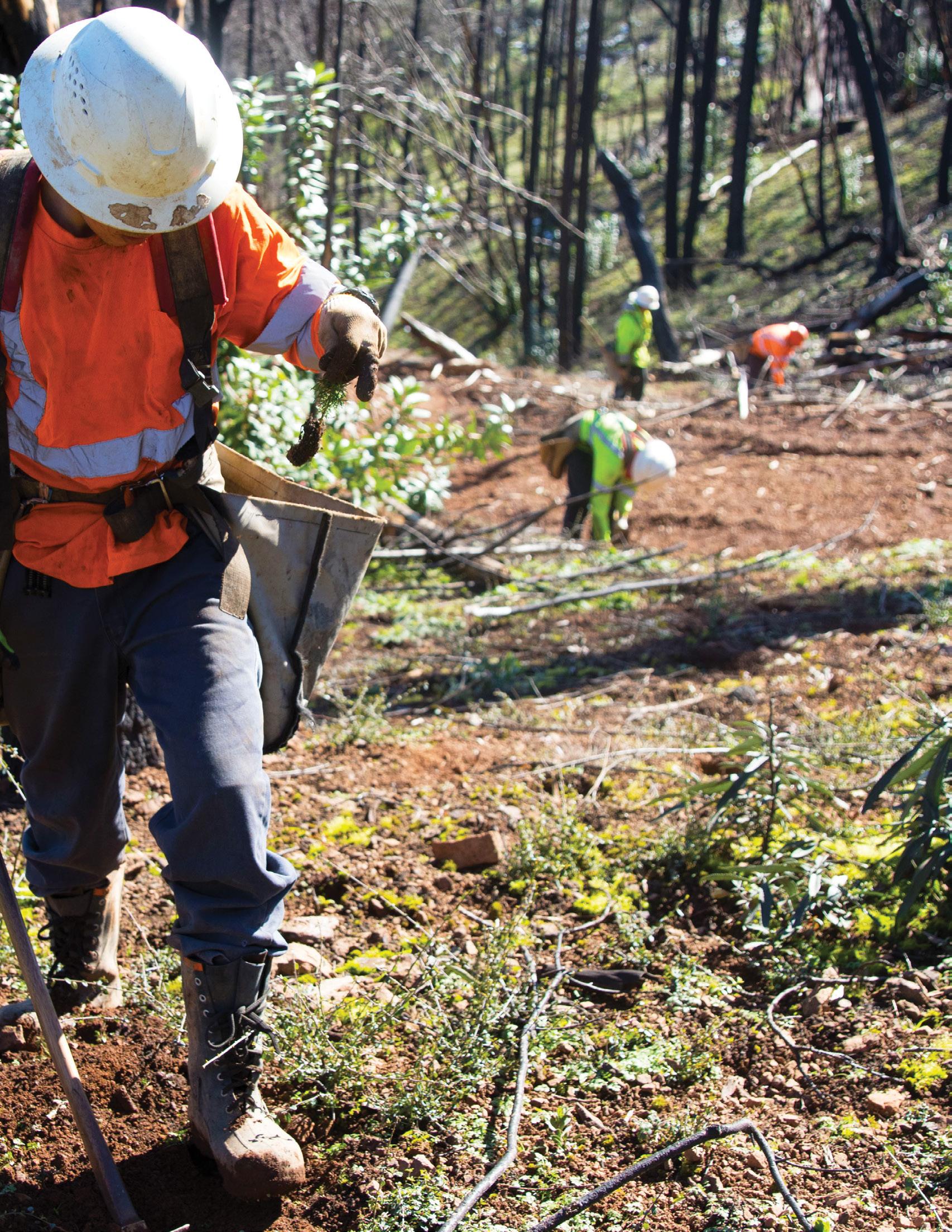
No species is able to live in fire, but many have found ways to rise, phoenix-like, from the ashes. They’ve adapted over thousands of years to the fire regime — or, fire frequency, intensity, and fuel consumption patterns — unique to their home region.
But human activities like fire suppression, land degradation, and settlement are shifting the balance from normal, low-mid range fires that help to keep ecosystems in balance to high-intensity blazes that destroy everything in their path.
Fire prevention is the logical first step, but it can be tricky to get funding and public support for things like urban re-planning and prescribed burns. Still, progress is being made: foresters, planners, conservationists, and legislators are working hard to address the factors that make wildfires more frequent and widespread. And in light of this interdisciplinary approach, some feel cautiously optimistic about the future. They’re learning how to fix some of the mistakes from the past, and how to prepare for the future by improving forest management to ensure that the forests are healthier and more resilient.
The unfortunate reality is that fire seasons have been lengthening for years, skewing resources towards firefighting and making prevention difficult to implement. As Lenya Quinn-Davidson, Director of the Northern California Prescribed Fire Council said, “we’ve been in a 100 year gap in fire in the landscape and the result of that is what we see today.” For example, California is now practically at risk yearround with little time to recover before the next one occurs. Because of this, restoration is often necessary.
There are a few different approaches to land restoration when it comes to trees. Reforestation is very helpful soon after a forest fire because invasive species can take over the land before native species have the opportunity to grow back. The result may not be a forest but a brush land of ecologically lower value, and one that's likely to burn again. This not only puts wildlife at risk, but also nearby communities because food and water supplies can be negatively affected. In this situation, planting ecologically appropriate seedlings gives nature the natural resources and time to heal itself.
And where reforestation occurs, it is conducted wisely in everything from the tree species chosen, to the distance between trees to the exact location where trees are being planted so that they don’t create the potential for future harm if another fire comes along in the area. Often, pioneer species that can tolerate poor conditions are introduced to help enrich the soil so that more sensitive native species can return naturally and gradually over time. By assisting in the regeneration process, we give native ecosystems a helping hand in restoring healthy, beautiful, and biodiverse forests.
One Tree Planted is a 501(c)(3) nonprofit on a mission to make it simple for anyone to help the environment by planting trees. Their projects span the globe and are done in partnership with local communities and knowledgeable experts to create an impact for nature, people, and wildlife. Reforestation helps to rebuild forests after fires and floods, provide jobs for social impact, and restore biodiversity. Many projects have overlapping objectives, creating a combination of benefits that contribute to the UN's Sustainable Development Goals. Learn more at onetreeplanted.org.
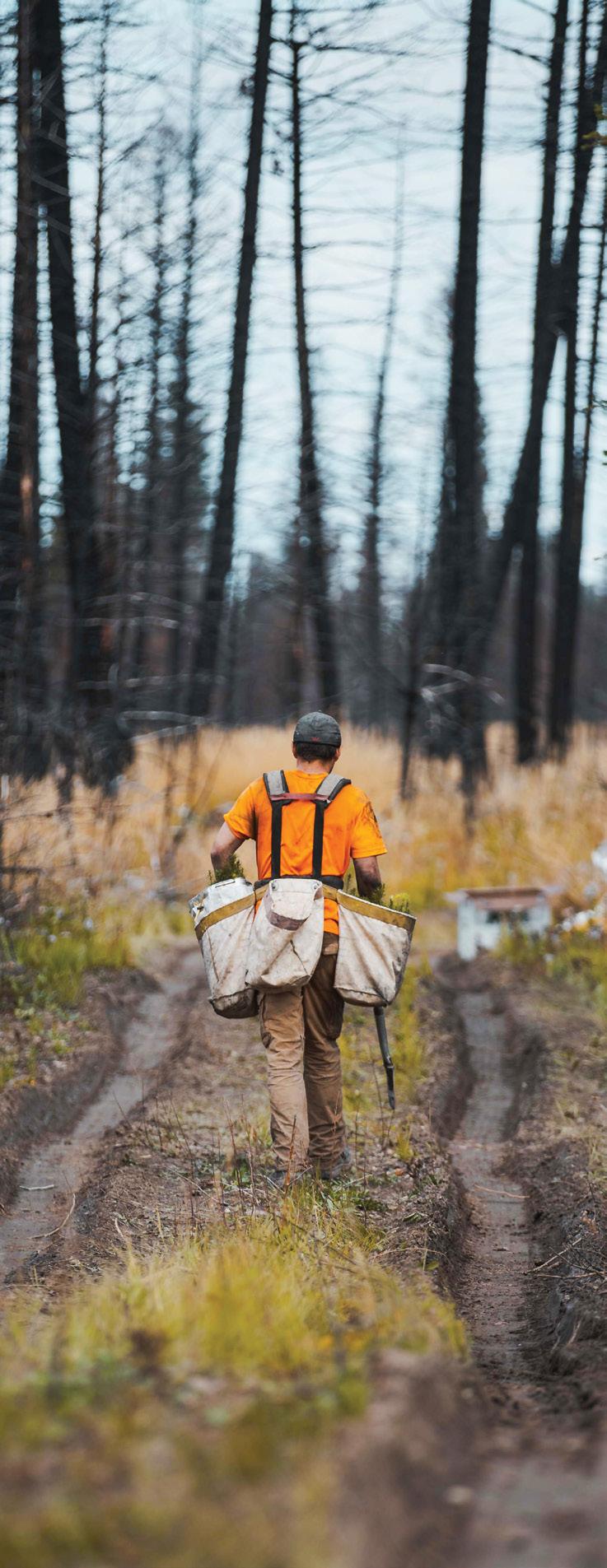
PLANT A TREE TODAY TO CLEAN THE AIR WE BREATHE AND THE WATER WE DRINK, PROVIDE HABITAT FOR BIODIVERSITY, SUPPORT LOCAL COMMUNITIES, AND IMPROVE THE HEALTH OF OUR FORESTS.
VISIT ONETREEPLANTED.ORG
ONE DOLLAR. ONE TREE. ONE PLANET.



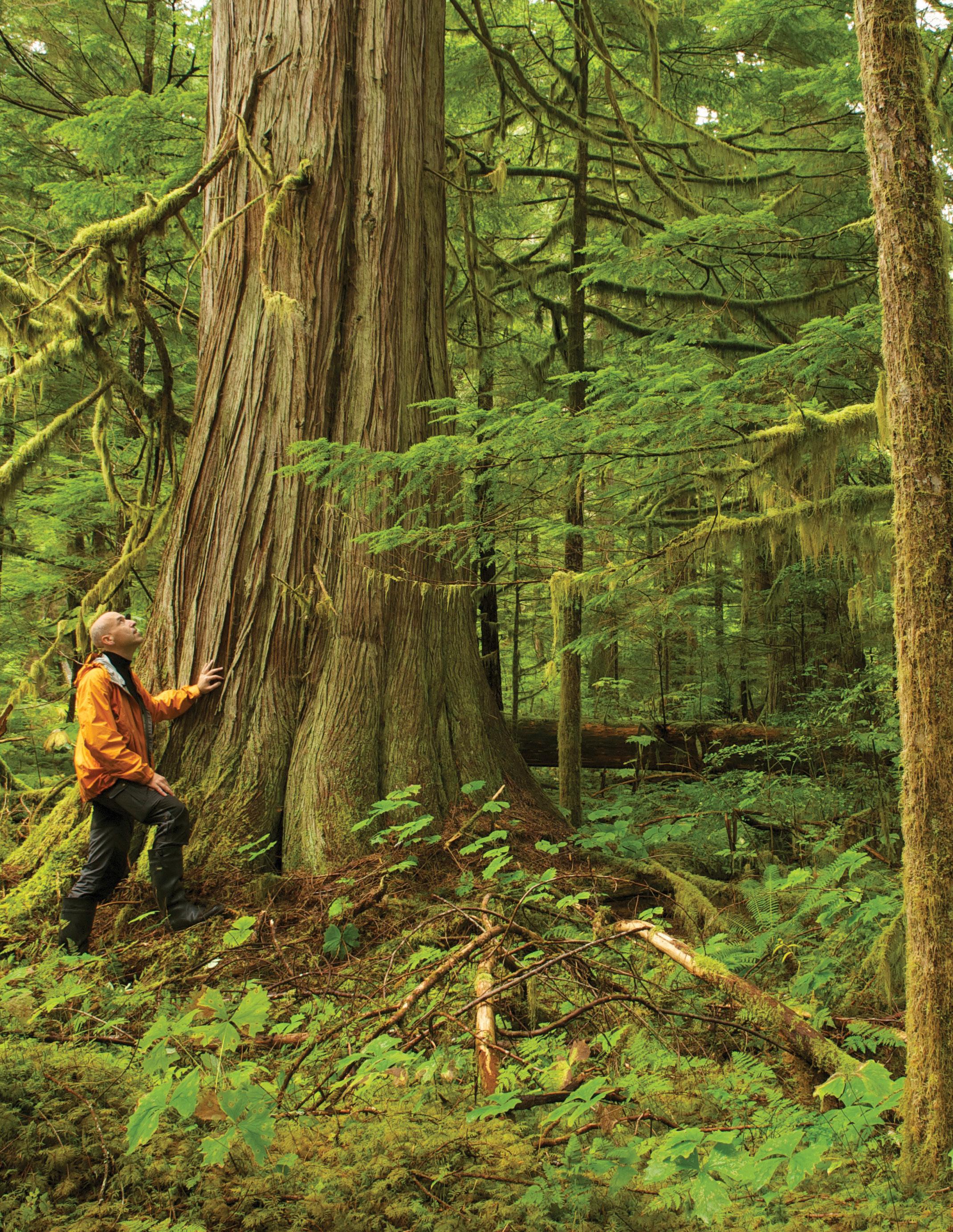 BY OLIVIER KÖLMEL, GREENPEACE CANADA
BY OLIVIER KÖLMEL, GREENPEACE CANADA
Growing up, the imagination that guided my paintbrush was inspired by the majestic landscapes of Europe and Canada. As a child, I loved hunting down the most delectable mushrooms, running in the mud of the undergrowth with my brothers, climbing trees in search of the canopy, or coming face-to-face with a deer or an anthill. My fondest memories are intimately linked to nature, to the forest. The great moments of adventure, the sense of discovery, the sense of freedom — all bring me back to these fortresses of nature.
Yet these places of healing and inspiration we call forests, are also places subject to harm, injustices, and atrocities. The destruction of nature is at the root of many disease outbreaks, wildlife decline, and is a driver of weather extremes such as forest fires. What we call development should more often than not be called conquest, as the companies behind mining, energy, forestry, and infrastructure projects push aside communities and wildlife in their quest for resources. Habitat loss is not only felt by woodland creatures. Human cultural heritage, identities, and traditional knowledge tied to these lands are also being eroded. Today’s economic model has become a threat to all life, a threat to our own species. Business as usual needs to change.
The restoration revolution is a vision for a new relationship between society, the land, and ourselves. It is an invitation to move our focus away from heavy resource extraction and toward a nature-based economy. To do that, we’ll need to shift our mindset, values, and activities.
Forests are home to an estimated 80 percent of all life on land, and are said to be capable of providing at least one-third of climatechange mitigation measures. The natural world provides the life-support systems we all depend on to survive. These “ecosystem services” (natural processes that benefit humans), include water purification, air pollutant filtration, climate regulation, flood control, pest management, pollination, and food security, to name a few. A restoration economy is an investment in these systems. However, it first starts with the protection of existing ecosystems.
While the Canadian government committed to protecting 30 percent of its lands, oceans, and freshwaters by 2030, it missed its 2020 target. Creating new green jobs at an ambitious scale can help achieve this urgent goal. If the Amazon forest is the lungs of the Earth, then Canada’s Boreal forest is our climate shield. The Boreal holds more carbon than all tropical forests combined. Protecting forests so they can grow to their full age is also a cost-effective approach to climate mitigation and reversing biodiversity decline. Scientists can also use these living laboratories to better understand how nature is adapting over time.
Protection, it should be noted, is not about excluding people from low-impact, sustainable use of forests. Protection must be centred on local communities and Indigenous rights, access, and knowledge. Considering that some of the richest and most biodiverse lands left in the world are on Indigenous territories, Indigenous-led conservation and stewardship is critical in meeting protection targets; including expanding Guardians programs, Indigenous land and marine plans, and Indigenous Protected and Conserved Areas (IPCAs) across Canada.
Restoration can take on many forms: reforestation and reclamation of degraded soils, land decontamination, restoration of peatlands, seagrass beds, and riverbanks. However, it should be noted that restoration is not an effort to recreate a past state, but to re-establish the evolutionary trajectories of disrupted ecosystems. In essence, it is moving past the simple act of planting trees, but ensuring we are rebuilding a self-sufficient and life giving forest ecosystem.
In addition to protection measures that protect forests as they are, restoring deforested, degraded and contaminated lands offers the most cost-effective opportunity to mitigate climate change and boost biodiversity. Connecting fragmented forests through ‘green corridors’ is another way restoration can help expand ecosystems. While restoring nature currently receives one percent of global climate financing, a recent study in the journal Nature indicates its potential can ‘prevent about 70 percent of predicted species extinctions’.
Think about it in everyday banking terms: while protection and conservation measures result in predictable yet immediate benefits, like a savings account, ecosystem restoration is more like a long-term investment. Canadian National Parks, for example, bring in six dollars for every dollar spent, while restoring natural ecosystems can bring in nine dollars in benefits for every dollar spent. Together, they provide greater insurance, prosperity and well-being.
Cities also need to rethink their landscapes to create healthier, greener environments that are accessible to people from all walks of life. By investing in jobs restoring urban canopies, creating parks, community gardens, and food forests - with a focus on the communities most in need - cities can improve air quality, the physical and mental health of their populations, and address food security issues. In some areas of the country, for example, cities will need to review their bylaws to allow citizens to grow food in their front yards and allow native plant species to take over ‘immaculate’ lawns. This, in turn, will attract birds, butterflies and other pollinators. It can also help reduce the use of lawn fertilizers, pesticides and irrigation, while cutting back on municipal costs for stormwater management, and treatment.
Recent reports and studies have emphasized that investing in “naturebased solutions” is a key fiscal policy option that offers high economic benefits and positive climate impacts. Some researchers estimate the global value of a restoration economy at $25 billion per year. The World Economic Forum puts the overall global value of nature-positive solutions at $10 trillion.
Governments can support economic recovery from COVID-19, and long term resilience by directly employing and funding naturebased jobs — jobs rebuilding shorelines, replanting native tree species, removing invasive species, restoring fish habitat, recovering abandoned or polluting fishing gear, upgrading existing conservation sites, stewarding lands, and carrying out data collection and monitoring. Other opportunities include jobs in regenerative agriculture, seed banks, integrating trees among crops (agroforestry), and restoring wetlands around existing farmlands. Adapting infrastructure to allow a continuous path for wildlife to roam freely also opens the door to engineering and construction jobs around restoration. The opportunities are endless.

A green and just recovery means leaving no one behind, and transitioning to a restoration economy holds up the same principle. This means empowering communities to make an equitable shift to more diversified, sustainable, and job-generating opportunities (instead of focusing on mining, forestry, or fossil fuels). This can take the form of training in Indigenous and single-industry communities, investing in the research and development of non-timber forest products (e.g.,mushrooms, berries, herbal teas, tree nut flour), exploring new uses for abandoned mills, ecosystem management, and overall help for diversifying local economies.
A study of strict ecological restoration work in the United States suggests this emerging sector employs “more than the coal, mining, logging and steel industries altogether.” Looking at the province of Alberta, the thousands of orphaned oil and gas wells are increasingly becoming a concern, and desperately calling for restoration jobs. These abandoned mines and wells are full of pollutants, and must be decontaminated in order to restore a healthy ecosystem.
Developing Indigenous-led conservation area planning and stewardship programs is a great model for public funding and job creation. But this only works if we holistically integrate Indigenous rights, laws, knowledge, and treaties with adequate funding and nation-to-nation relationships to guide land planning decision-making. This is an essential part of our collective journey towards reconciliation. The restoration revolution is not all about the economy, it is also about restoring respectful relationships.
The pandemic may have brought the world to a halt, but in many ways it brought us closer together. For many, it has also restored an appreciation for the outdoors. In Michel Le Van Quyen’s book, Cerveau et Silence, he points to different studies that highlight how contact with nature can bring about multiple health benefits. For example, patients in hospital rooms facing a natural landscape have shown to recover faster
from surgery, require fewer painkillers, and go home, on average, a day earlier. A short walk in nature has shown to significantly reduce depression levels in 71 percent of hikers sampled. Further studies show the benefits of longer walks or ‘forest bathing’ on heart rate, blood pressure, and the immune system. What is even more striking is that after only two days of walking in nature, the biological benefits persist for about a month. In ensuring we all have access to nature, by definition this could help relieve pressure on our health care systems. The impacts of preventative medicine related to 'forest bathing' is something governments and businesses should factor into their budgets and programs.
Another important reason to nurture nature is that our forests are also our pharmacies. The World Economic Forum states that “25 percent of drugs used in modern medicine are derived from rainforest plants while 70 percent of cancer drugs are natural or synthetic products inspired by nature.” Aspirin, for example, is extracted from the wonderful willow tree. What other treasures are hiding in our forests? Preserving biodiversity is key to finding out.
The COVID-19 pandemic is an unforgettable reminder that our health, livelihoods, and well-being are intrinsically linked to the health of nature. Investing in nature is an investment in our resilience and future.
As governments around the world plan and budget for a long-term economic recovery from the pandemic-triggered recession, Greenpeace is urging Prime Minister Trudeau to make unprecedented investments in ‘nature jobs’ that will protect Canada’s carbon stores and restore degraded natural infrastructure.
Take action now and join the restoration revolution by asking our leaders to invest $10 billion to create at least 100,000 nature-based jobs in the upcoming budget.
Let’s put building a restoration economy at the heart of the recovery plans and build a new kind of economy. Let’s protect what protects us!
LEFT & BELOW: Boreal ForestS - Montagnes Blanches, Quebec.
PHOTOGRAPHY: Markus Mauthe/GREENPEACE.

 By Cassie Pearse
By Cassie Pearse
Sometimes one comes across an idea that is so simple that we have to wonder why it hasn’t been clear to everyone forever. It should be so obvious to see that using paper made from trees is a waste of valuable resources. We are the ones who are responsible for our planet and our future and we know, without a shadow of a doubt, the role that trees play in keeping our planet healthy yet we continue to treat them as if they are an expendable, low-value, resource.
I knew all this yet I’d never seriously considered the alternatives until I began working with Saving Earth Magazine. Sure, I buy recycled paper for my personal printing, I have banned gift wrapping in my home and I try to stop my own family from wasting paper, but a serious, industrial alternative? Shamefully, simply not in my mind.
Enter Social Print Paper, a Canadian company, that offers businesses and individuals an agripaper alternative that is not only sustain-
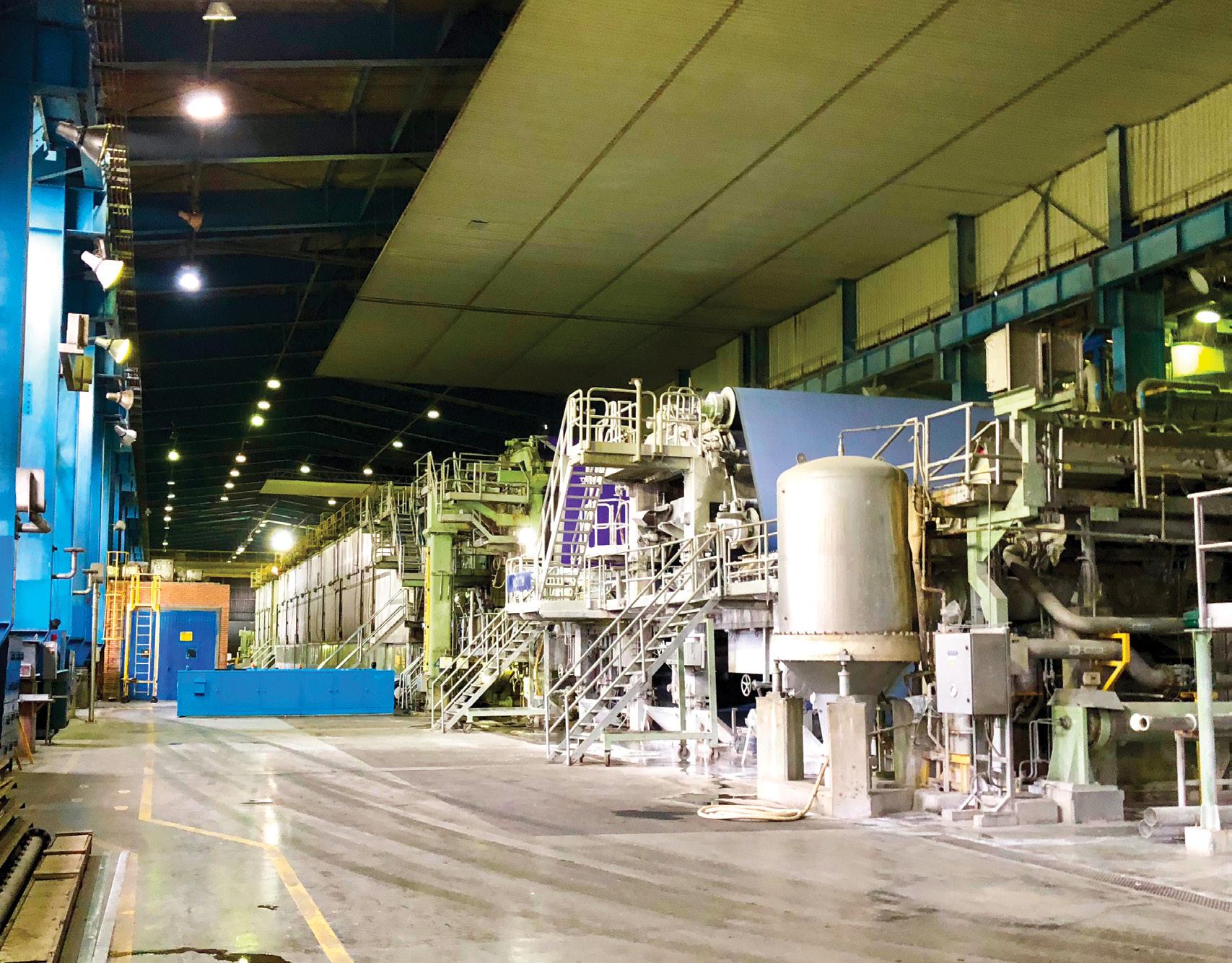
able but also affordable and of high quality. The company’s tagline is, “the best alternative to not printing” and that’s exactly it. I spoke with Minto Roy, Managing Partner of Social Print Paper, to learn more about their product and why he believes it is a smart environmental choice for protecting our planet’s trees.
Our most observant readers may have noticed that Saving Earth Magazine is printed on sugar sheet paper. That is, paper made from bagasse, the residue waste of sugar cane, rather than the traditional treepulp paper. The only reason a reader holding this magazine in her/his hands would ever know that this isn’t traditional paper is that the publisher chooses to share this information. By touch or sight alone there is really no way to tell. And that is the first point Roy makes when we speak: that he saw the challenge as creating an alternative paper product without sacrificing either product quality or cost to the consumer. He told me he wanted to create an environmentally-friendly product that was at least equal to traditional paper in price and quality.
Roy, as a social entrepreneur (someone who uses business ideas to solve community or environmental issues), understands that people aren’t just one thing: he highlights that shrewd business leaders could well have strong desires to protect our planet’s resources and so set
about creating a product that answers both business and ethical needs. He firmly believes that most consumers want to spend in line with their values and that they will do so as long as a product isn’t expensive.
Agripaper provides an opportunity for all to reduce their carbon footprint and minimize deforestation without sacrificing paper quality, performance or price. Roy and his team are not the first to think of using other materials for paper. Indeed, there have been many different materials used in the past, in fact, wood-fibre paper is a relatively new development in the long history of paper.
Social Print Paper didn’t actually begin with sugar cane waste. Their first efforts were with wheat but after early experiments, they realized that sugar cane provides a better quality final product.
The Valle de Cauca in Colombia is home to 80 percent of all the country’s sugar cane industry and it’s where this sugar sheet paper is made. Sugar cane is a major part of the local economy and this valley provides the perfect climate to grow sugar cane all year round, allowing the production of more tons per hectare than elsewhere in the world. One crop can grow to maturity in under two years compared
to trees, which vary greatly depending on species, but on average take around 40 years .
The bagasse, or sugar cane waste, when not diverted into making sugar-sheet paper, sits in landfills unless it can be sent to commercial composting plants where it can decompose in 45-60 days. If burned, as so often can be the way with traditional landfill waste, it releases carcinogens into the atmosphere, further polluting the air that we breathe. Instead, thanks to innovative thinking, the waste is converted into a useful product that also helps to prevent deforestation.
I asked, like the good environmentalist that I am, about the impact of the paper having to travel from Cali to Vancouver, where Social Print Paper is based. Roy was quick to point out that the paper is made where the sugar cane waste is found and that it travels to Canada by sea, the lowest travel impact available. If the paper were made in Quebec and then transported by rail or air to Vancouver, while appearing to be more environmentally sound, the carbon footprint would actually be higher. And, of course, not forgetting Roy’s competitive urgency, the paper wouldn’t be as cheap if it were produced in Canada.
cost them more and doesn’t sacrifice quality or performance, would rather not use trees.”
Roy believes that we need a new language around sustainability. His message is that, “not only is it the right thing to [use environmentally friendly alternatives] but it’s the competitive thing to do, too”.
Roy tells me that in his experience when leaders learn about sugar sheet paper and the possibilities it offers for corporate tax levies they are all-in because, honestly, who is going to turn down the opportunity to do something good if it also saves money? He is all about reading the situation and that is his competitive urgency: he is a businessman who wants his product to be part of the environmental solution and he knows businesses are more likely to join him if it is in their best interests. “Businesses value sustainability” but as they pragmatically note on their website, “businesses shouldn’t have to jeopardize their bottom lines to collectively save forests and benefit climate change.”

When Roy was just starting out on his paper journey there was no chance of a supply chain within North America as the paper mills simply aren’t made to deal with sugar cane. In the future, when demand has grown as he hopes it will, there will be the opportunity to retrofit machines across North America at the behest of big business and government.
Roy is clear that he isn’t against the lumber industry. He acknowledges that we need trees to make long-life items such as furniture or housing but paper, a short-term product, simply doesn’t need to be made from such a valuable resource.
The paper can be used for personal printing at home as well as by industries. Social Print Paper works closely with big name printer companies such as Xerox, Canon, HP, and Ricoh to ensure the paper meets the highest of standards and requirements.
As an entrepreneur, Roy thinks not only outside the box but also about the box itself. The eco-friendly sugar sheet paper isn’t what he considers to be his innovation, the innovation is that he has an ecofriendly paper that is equal in quality to wood-fibre paper.
For many people, and for many years, the path to sustainability has fed on guilt and obligation but it doesn’t need to be this way. We need to do more to create not only interest but a strong financial incentive among business leaders to make a switch to more sustainable business practices. Roy told me he knows this needs to be a “values based decision for consumers.” He believes “that most consumers in the world, if they have a choice to use paper made from trees or paper made from agricultural fibre waste, if it doesn’t
Social Print offers eco savings reports to clients, detailing how much carbon dioxide they did not produce by swapping to sugar sheet paper. This can then be incorporated into their carbon reporting (in Canada), effectively reducing their carbon tax requirements. Using two boxes of sugar sheet paper rather than tree-fibre ‘regular’ paper, saves one tree from being felled for paper.
We discussed another surprising innovation that still wasn’t the material from which this paper is made: supply chain disruption. Generally, Roy explained, the traditional incumbents control the supply chains, whether we are talking oil and gas or paper, it’s all the same. The big boys control the supply chain and this means controlling consumer choice. Consumers see what they want them to see, there is the illusion of choice rather than true choice. But this can be challenged with smart advocacy and knowledge sharing.
Roy explained it thus: if a distributor talks to a CEO, she may well agree that switching her company from traditional paper to an environmentally ethical choice that also offers tax breaks is a smart move but if this decision doesn’t get transmitted throughout the company then there is a good chance it will never actually happen. “If you want change, you have to take the ideology and put in accountability and reporting”.
“Big businesses and governments got us into this [climate change]”, says Roy, “they have a responsibility to get us out of it, they need to make the change”.
Roy’s aim is to create a future where people say, “can you believe we used to make paper from trees?” Saving Earth Magazine stands proudly with this aim.
If you have a green business you’d like to see featured in Saving Earth Magazine email us at info@savingearthmagazine.com for more information.

Connect your students, faculty, and staff to a technology experience that drives innovation, communication and collaboration while doing good for the environment. Ricoh can help.
 SERGIO IZQUIERDO
SERGIO IZQUIERDO
"Nothing was more shocking than the dark black fluids taking over the entire wetland of Manchón Guamuchal."

After two canceled flights due to bad weather, I was finally able to accomplish my assignment to fly over and document Manchón Guamuchal, Guatemala’s biggest wetland. Located on the south coast of Guatemala, this wetland was declared a RAMSAR site in 1995. This floodable area covers a total of 25 thousand hectares, of which 7,650 are covered with mangrove. It was the beginning of June when I found myself flying, doorless, in a small Cessna aircraft, with my pilot and friend, Clemente. We flew over the city of Guatemala, Lake Atitlán, passing by a few volcanoes, as well as over an important river called Ocosito. As we zigzagged the river we found big extensions of sugar cane farms, banana crops and huge African Palm plantations.
Suddenly these widespread fields ended, and we started to see a series of natural and artificial lagoons located in the Tamashan estate. This is an enormous property and in it is the Manchón Guamuchal wetland. I’ve known this place for a few years already, it being the most important stopping point for migrating birds to feed and rest, including birds that come from the Arctic and fly all the way to the austral region of South America. This turns out to be one of the most fascinating places to photograph different species of birds.
These natural and artificial lagoons I mention are used for shrimp farming, managed in a profitable and productive model that benefits, not only the owner of the farm – Guillermo Aguirre, a friend of mine – but also many people in the local fishing communities, such as Tres Cruces, Tilapa and El Chico.
As we approached this area, we noticed something wasn't right. We realized the lagoons, the mangrove and other water canals were dyed a disturbing black color. This abundant black fluid flowed all the way to the ocean. We were also able to notice other problems in the area, for instance, how there have been fires destroying different parts of the mangroves, and in several places, illegal invasions into the mangrove. Nevertheless, nothing was more shocking than the dark black fluids taking over the entire wetland. I couldn’t find any fishermen around, they were unable to fish of course, because of the water’s condition.
As soon as we landed I called my friend, Guillermo Aguirre, to ask him what was going on, and he said, “Man… You have no idea the amount of fish floating around, it looks as though they were tree leaves floating around the canals. They dumped their waste all over us (referring to their neighbours, the African Palm farmers)”. Three days after my flight, Guillermo and I organized a trip to his farm. We had to get special permits to be able to document the damage caused in the area. After a ten hour drive, we arrived at the shrimp lagoons and the first thing I noticed as I got out the car was a foul odor coming from the water. I saw a crab swimming backwards towards the surface, really struggling to get some oxygen along with other dead fish floating around the water.
I introduced myself to Victor Hernández, a community member, to see what he could tell me about what happened. Victor told me that a few days earlier, just after the first strong rain of the season, Finca Maravillas (the Palm industry next door to them) released all of this black substance into the water, killing all the fish in it. Luckily, the townspeople were able to save three out of the five lakes, by blocking the water entrances. Many extensive crop estates such as this one have created huge water deviations along the Ocosito River to benefit their plantations, affecting communities and the ecosystem as a consequence. Not only that, they dump their waste into that same river creating yet more massive contamination. Finca Maravillas is one of these estates.
Victor then mentioned that this same problem repeats itself every year, always after the first strong rain of the season, and it has been going on for decades. He said that before, Finca Maravillas (Agroaceites Industry, a subsidiary company of Agroamerica), used to dump their waste directly into the river, therefore killing all the fish in the river. Their waste would rapidly end up in the ocean. This water contamination would only last around two days and would not affect them as much (which is also not good at all, but there was no one to control this), but he said that lately they have deviated their waste directly into the lagoons, the same lagoons that connect with the mangrove. Guillermo Aguirre confirmed that the contamination on the lagoons has been an issue since his deceased father managed the farm. I later interviewed locals from different places and they said the same thing. They’re all dealing with the same problem and confirm all the facts.
Horrified by all of this, we took a boat ride for hours along the canals. The texture of the water was greasy, the colour was absolutely black and the smell was disturbing. We arrived at Tres Cruces, where we met up with Joel Archila, the community's “Cocode” (the chief of the community). He and his father shared exactly the same information as Victor, and they also told us how they are helpless and have no income because of this. They not only cannot fish, but they’re also left without a water source, since their water well has been contaminated as well.
This also becomes a health problem for the population in the area as they rely on this water source that is being contaminated, for their subsistence. Their food resources are being poisoned by the toxic waste in the water, and in the end, it all comes back to humans and the food chain. Add financial problems to the list of problems, since the villagers are fishermen, and no longer have any product to sell. This just aggravates economic difficulties caused by the current pandemic of COVID-19.
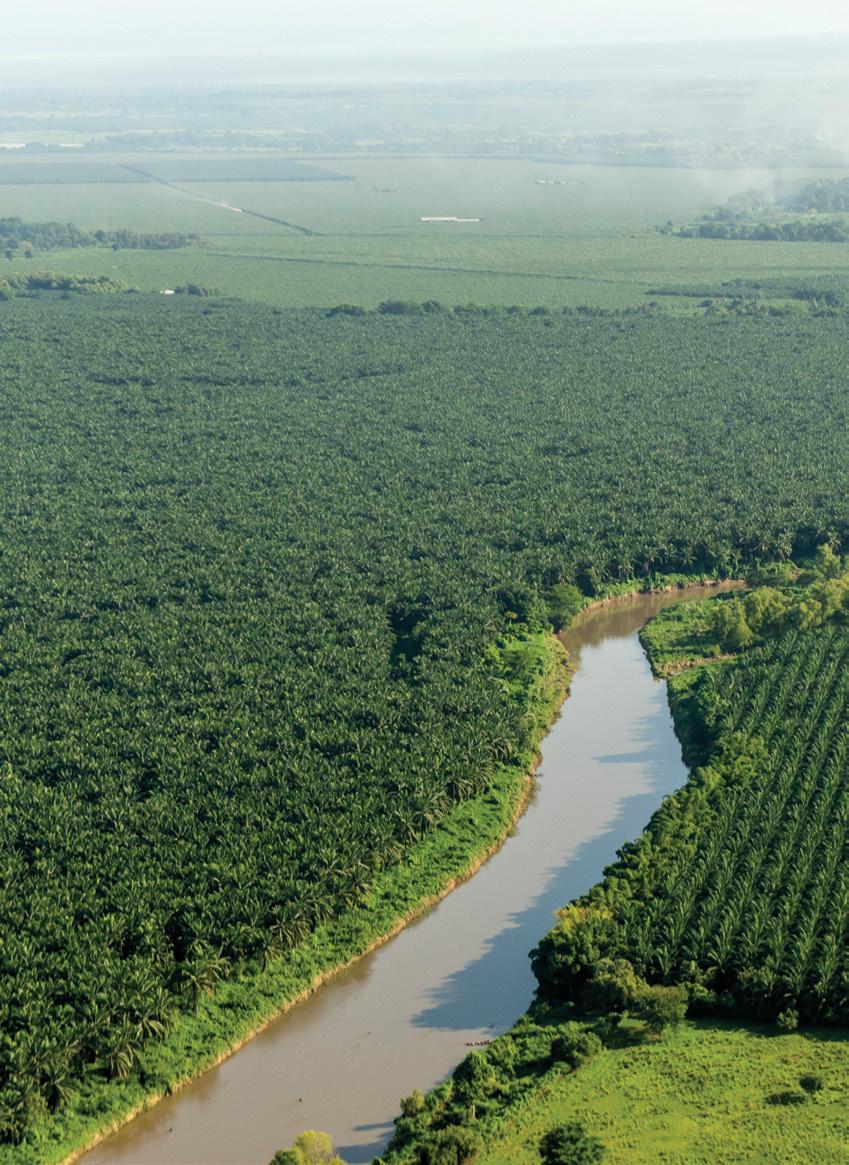
but also every bit of mangrove at every stage of growth.
Everyone I talked to pointed at the same farm causing the problem, but I wanted to see it with my own eyes, so I could be 100 percent sure about all of this. We continued our boat ride, looking for the place of origin, and with the help of a drone, we were able to locate it. First we saw images showing how there was brown looking water coming in from Ocosito River on one side, and black contaminated water coming in from the other side. So the contaminating black water was not coming in from the river, it appeared as though it came from the Tamashan farm. We then followed all of Tamashan’s canals until we finally reached the place where we saw the dark waste originating: Finca Maravillas’ sewage system. The saddest part was that during the whole boat ride along the mangroves, which lasted hours, we didn’t see any wildlife, no birds, nothing, only dead fish. We were witnessing a complete ecocide. There is no other crop that can pollute the area but the African palm from Agroaceites –I documented this ecocide by air and by land, and saw it with my own eyes, the dark waste coming out of their property.
African palm is one of the most destructive monocultures on our planet. It’s known as the “Invisible Assassin.” Palm oil is the world’s strongest product, as it’s needed in multiple daily use products. However, various studies show that it has harmful effects on human health.
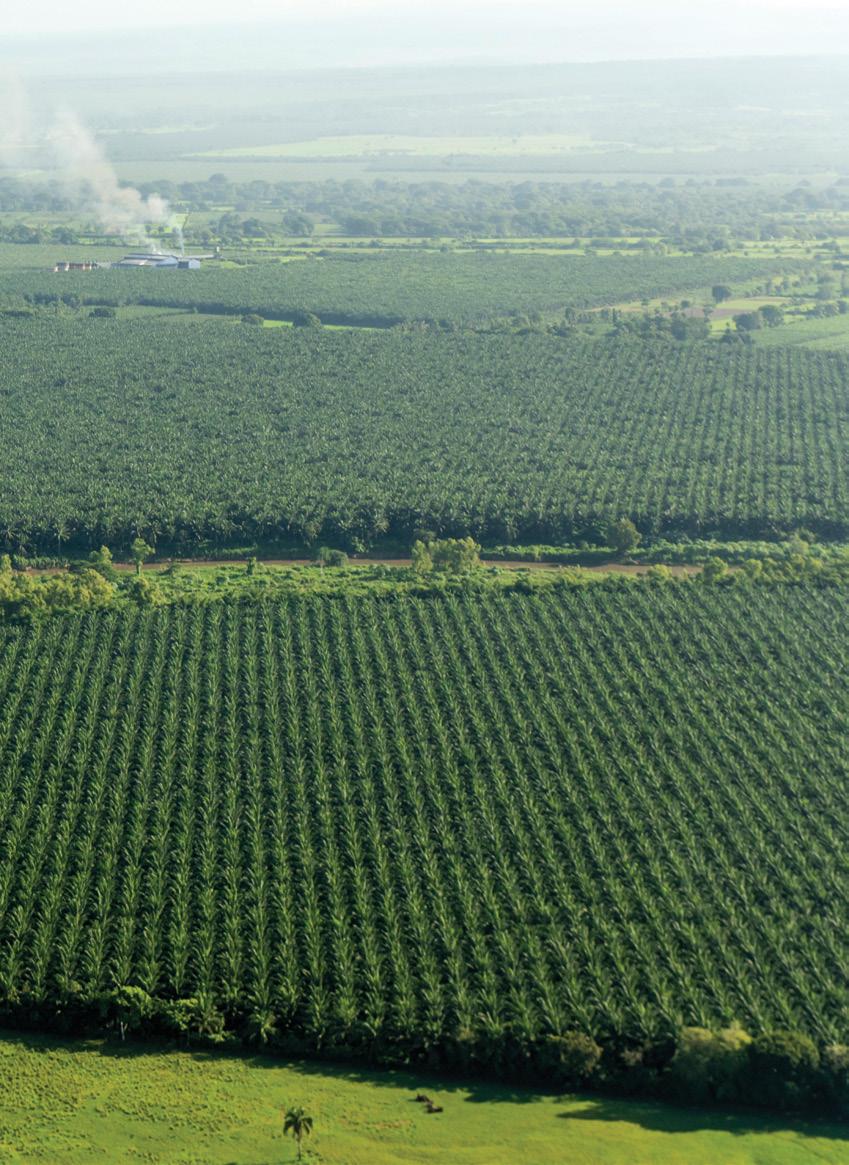
The industrial cultivation of African palm is not only replacing tropical forests and cultivation pastures, but it also generates devastating consequences on the ground as it transforms swaths of land into infertile wasteland, in some cases, unusable, according to different studies.
Based on a recent study by the “Institut de Ciència i Tecnologia Ambientals de la Universitat Autònoma de Barcelona” (ICTA-UAB) it has been established that in countries such as Guatemala, the expansion of the palm oil industry has increased 600 percent in the last decade destroying huge areas of tropical rainforest. The palm oil industry in Guatemala is dominated by seven major companies, most of them “family-owned.” These families are some of the richest and most powerful people in the country. These industries avoid paying taxes, since somehow the government has established that they promote the economy of the country.
A different ecocide happened about five years ago (also in June with the first strong rain of the season) in Petén, the north of Guatemala. REPSA (Reforestadora de Palmas del Petén, S.A.) was responsible for a massive fish kill along a 100-mile stretch of the La Pasión River. Due to the massive overflows of organic matter from the palmoil mills’ effluent ponds, the river was deeply contaminated, like with the Manchón Guamuchal ecocide, causing the asphyxiation of fish and other aquatic life. This affected all community people from the villages down the river, and like the people of Tres Cruces, they were left without their fishing and water source. Exactly the same pattern.

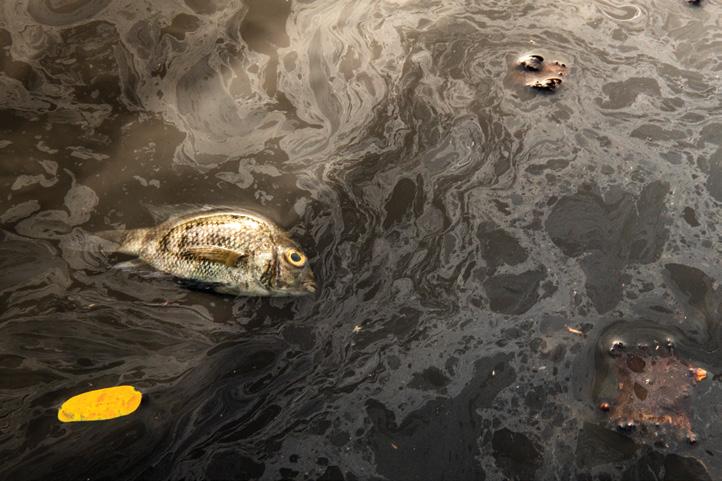

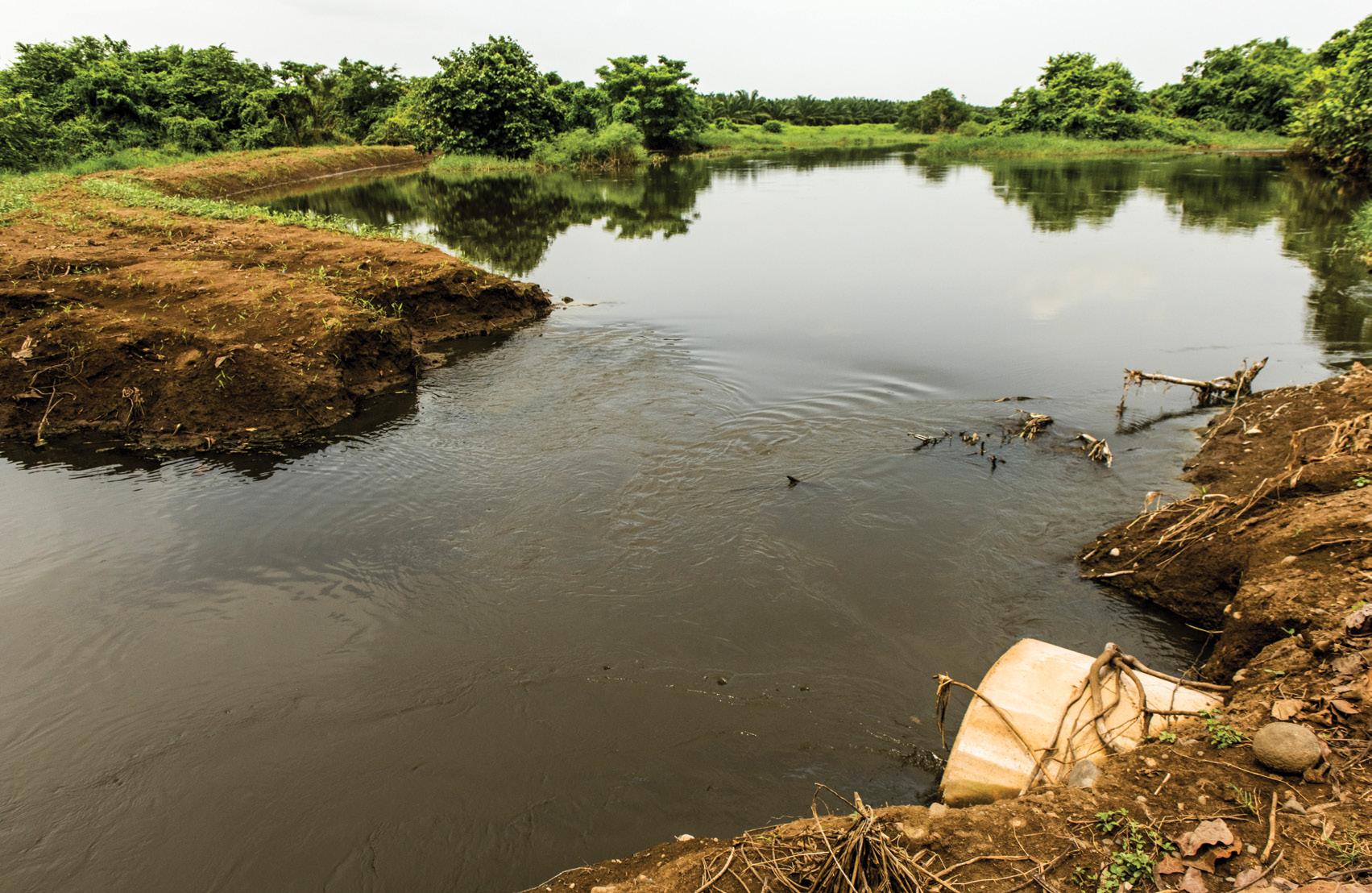
Rigoberto Lima Choc, a teacher and an environmentalist denounced REPSA at that time and was killed on September 18 after a judge cancelled REPSA operations.
We returned from our trip and shared a video and photographic material, which went viral. There was a great response from the public in Guatemala. However, this just triggered a process of inefficiency, bureaucracy and corruption. One week later, CONAP (Protected Area’s National Board) made an urgent complaint, but it wasn’t until three weeks later that the Ministry of Environment (MARN) and the Public Prosecutor’s office arrived to take samples and investigate the case. By then, due to their tardiness and the rainy season, the problem had already diluted in the water. A reliable source informed us that when the investigation committee was there, the locals could hear motors that were pumping fresh water into the palm farm canals, so basically, Agroaceites had enough time to clear their mess. According to official documents, the investigator from the Public Prosecutor’s Office in charge of this case refused to take water samples in the most contaminated places of the African palm farm, regardless of complaints and requests being made by the people working at MARN. These documents also confirm that the water samples taken in Manchón’s contaminated lagoons and canals had the same characteristics regarding odor and color than the samples taken inside Finca Maravillas’ canals.
Not only did they not take samples in different places, but when the results from those samples came back, they appeared to be altered, since they show to be almost without contamination and with enough oxygen for life in the mangrove. A private study however, made two
weeks after the official samples were taken proved that the water showed very low levels of oxygen, which according to standards in the laws of superficial waters in Costa Rica (since they have none in Guatemala), were insufficient for life in the mangrove.
Voces del Planeta, a movement that gathers environmental organizations (including Rescue The Planet, an NGO that I founded), academic institutions and the business sector (no greenwashers), started a new petition, https://www.change.org/ SalvemosManchonGuamuchal, inviting people to sign to request not only the specific entities of the government do their job, but also that certification authorities such as Rainforest Alliance and RSPO reconsider their certification of Agroaceites for the ecocide they have caused. Thirty-five thousand signatures were delivered, a new record for environmental topics in Guatemala. Numbers are currently nearing forty thousand signatories. In spite of that, Rainforest Alliance has yet to investigate the ecocide. We hope that by the time this article is published changes will be made so that the public can continue to have faith in the Rainforest Alliance certification. RSPO is still in its investigation process, although, let’s not forget, this is an organization made by palm oilers for palm oilers.
Corruption is so huge and has such a high level of impunity, regarding environmental crimes in Guatemala. President Alejandro Giammattei has not responded to the petition, in fact, a few weeks after the ecocide took place, he publicly reinforced his support for palm oilers all over his social networks in a clear example of how the industry controls the government.
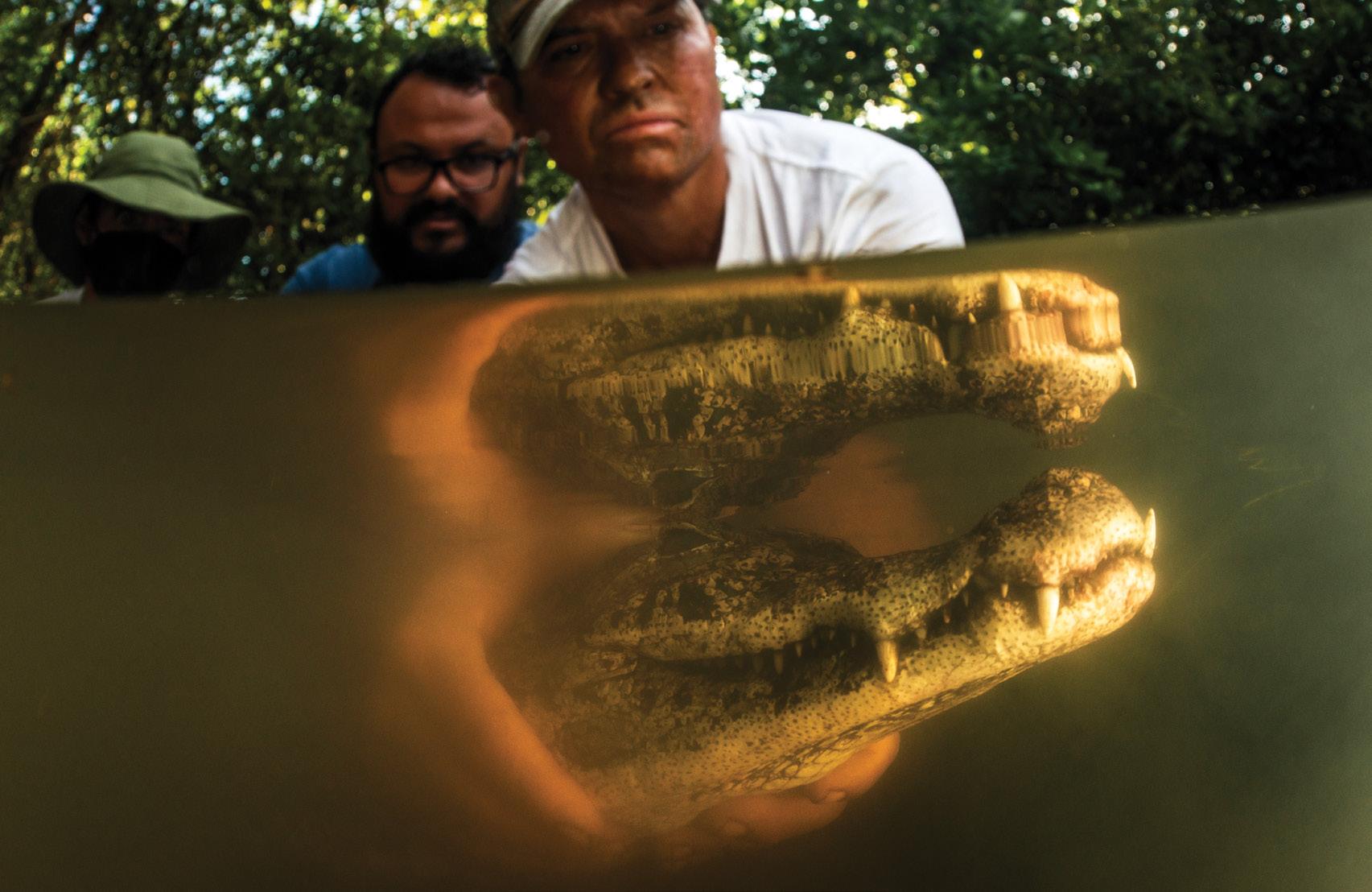
On the day Voces del Planeta delivered the petition, we were told that the environmental commissioner, Deputy José Arnulfo García Barrios, was not in his office. We later found out that he was hiding in some other office to avoid giving out statements on to reporters.
Additionally, the traditional media is also co-opted since despite the material they were provided, they did not publish anything about the ecocide due to conflicts of interest. Many of the palm companies produce different products such as cooking oils, margarine, cookies, snacks, etc. All their products are advertised by the media, and due to financial problems that the media is now facing, they can’t afford to risk their businesses by publishing negative stories about palm industries. We were informed about these facts by reporters who talked to our PR team.
In the end, we were able to deliver the signatures to Deputy Samantha Figueroa, director of the Parliamentary Environmental Front (an alternative front to the parliamentary environmental commission). Figueroa, in the face of government reticence due to the influence of the palm industry, named the involved governmental entities, compelling them to speak, under oath, about the issue.
I realized that many “environmental” NGOs respond to their funders’ needs. With several large environmental NGOs (other than those belonging to Voces del Planeta), none raised their voice or spoke about the problem. This is due to the fact that many NGOs receive funds from the African palm industries and other related companies (the same happens when it comes to ban or reject single-use plastic, since most NGOs in Guatemala receive funds from soft drink companies and promote recycling as the first option and not total rejection).
Finally, it is important to note that in early October, Antigua Exotic, the oldest animal rescue centre in Guatemala, broke the country’s record of the number of animals released in one day. They released 304 animals (caimans, turtles and snakes) in Manchón Guamuchal with the hope that they can survive the palm oil threat. Caimans have been reintroduced into the ecosystem after their population disappeared some years ago. Their reintroduction should pressure authorities, certification NGOs and palm oil farms to make real changes in order to preserve this fragile reserve and ensure the survival of these animals.
We must consume environmentally-friendly products, without palm oil and generate a change in our lifestyle to counteract our impact on nature. We have to take into account that "certified" products do not necessarily mean that they come from entities that put environmental interests before their financial interests.
Personally, I’ve felt that this denouncing act has been like a rollercoaster, with emotional ups and downs each day. I’ve been surprised at how corruption is taking over companies, the government and even environmental organizations. Everyone talks about what should be done but no one does anything. We can’t just stand there and watch how amazing places like Manchón Guamuchal are slowly dying before our eyes. But all this frustration, shared by many conservationists with their different struggles around the world, must become an engine to move forward.
We are providing information and exposing the truth, hoping that people might be moved to take vital action to save the planet by fighting against human selfishness. We need less “ME” and more “WE” to save our planet.
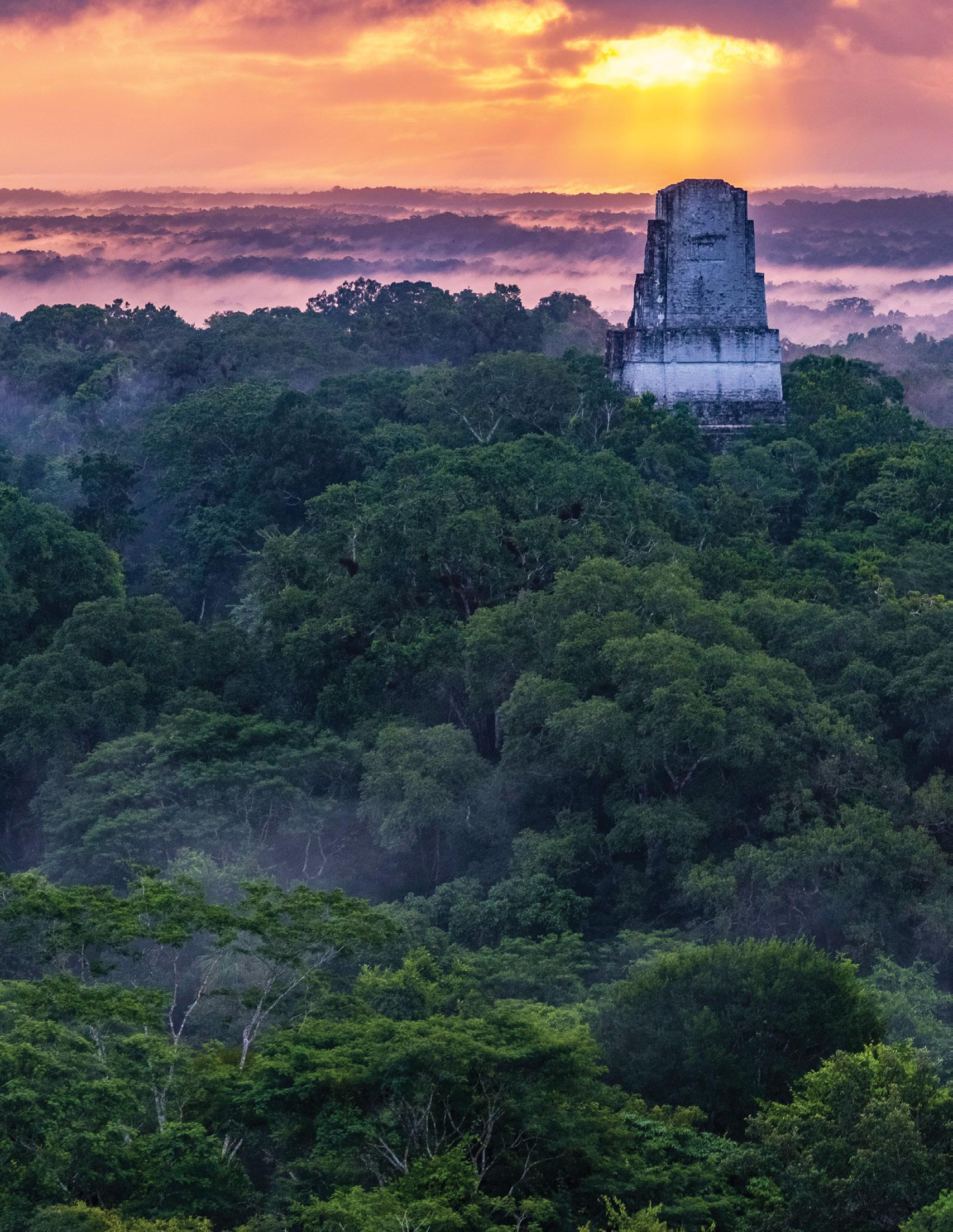
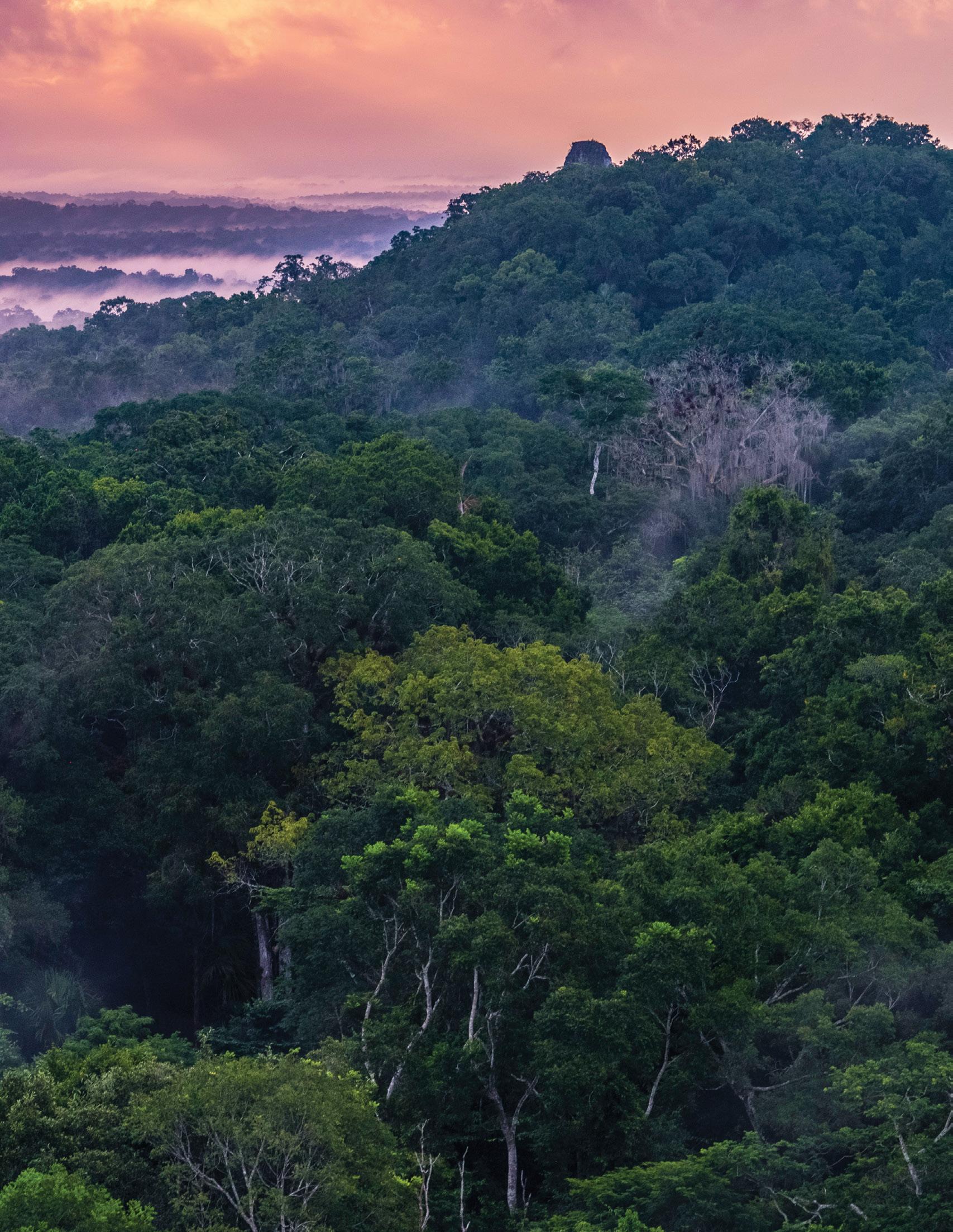
Ihave a personal relationship with the jungles of Guatemala, with the Maya Biosphere Reserve (MBR) in particular. It is one of those places that if you're lucky enough to find, you'll be drawn back again and again. Lured by my love for archaeology, I found peace within its embrace and a connection to nature that must be experienced to be appreciated. In my travels to the MBR I was fortunate enough to visit the archaeological parks of Tikal, Yaxha, Holmul, and El Mirador. These parks are all in generally safe areas of the MBR, and are protected, in part, by Community Forestry Concession members.
The MBR is massive. Bordering Mexico and Belize, it is home to approximately 2800 species of vascular plants, 513 species of birds, 62 species of amphibians, 122 species of mammals, and 95 species of reptiles. It is also uniquely home to a vast concentration of ancient Maya cities, some of which are still under excavation. The city of Tikal is one of the most famous archaeological sites in the MBR, attracting more than 200,000 visitors annually.
Sadly, the MBR also includes dangerous areas, which have turned into drug smuggling and laundering terrain, where narcodeforestation is common and where very few tourists dare to travel.
In January of 2020, the Policía Nacional Civil and the Guatemalan military engaged in an armed confrontation with drug traffickers in the area of Laguna del Tigre. They recovered five vehicles, a jet containing 1,700 kilos of cocaine, and a large arsenal of weapons. The drug traffickers fled the site and no arrests were made. The cocaine, worth roughly $160 million in the United States, is only a small sampling of the cocaine being trafficked through Guatemala. This is an ongoing situation that has accelerated since the US Coast Guard tightened ocean routes to US shores. Last year alone, some fifty abandoned drug trafficking jets were found in Guatemala. It is also known that many more have used jungle landing strips to drop off their cargo for Mexican Cartel members. The Washington Post reports, that ninety percent of the cocaine consumed in the United States transits through Guatemala.
I could not help but ask myself why certain areas of the MBR were failing while others were thriving? The more I researched, the clearer it became that to understand both the problems and any potential solutions, we must specifically consider external influence by organizations looking to land grab or to take advantage of public unfamiliarity of the setting. Let me explain.
The MBR covers an area of 21,602 km2. It is divided into three different zones, a Core Zone, which includes five national parks and two protected biotopes, a Multiple Use Zone, and a Buffer Zone. The Core Zones are protected from the extraction of natural resources, while the Multiple Use Zone can be used by Community Forestry Concessions. The Buffer Zone is largely private land where agricultural activities are permitted. See map.
Its management is led by Guatemala's National Council of Protected Areas (CONAP), and co-managed by other institutions such as the Centro de Estudios Para la Conservacion (CECON), Defensores de la Naturaleza, and Guatemala's Ministry of Culture. These organizations then partner with others to protect the forest.
One of the most successful CONAP partnerships that have proven itself again and again over the years is that of Community Forestry Concessions. It is because of these concessions that certain areas of the MBR thrive, while others are left at the mercy of criminal organizations.
There are 19 community forestry concessionaire organizations that belong to the Association of Forest Communities of Petén (ACOFOP). These organizations are granted 25-year government contracts to harvest timber and other forestry products, all of which must be done sustainably and certified internationally by the Forest Stewardship Council (FSC). These organizations also partner with many environmental organizations such as USAID, Rainforest Alliance and the Wilderness Conservation Society (WCS). For example, in 1996 WCS began working with the community of Uaxactún and helped them obtain formal rights to manage their 83,558-hectare forest concession, which was finally granted in 2000. They also support the Asociación Forestal Integral de San Andrés Petén (AFISAP), the Carmelita Cooperative, Árbol Verde, and the Asociación Forestal Integral de Cruce a la Colorada (AFICC) to name a few.
USAID, created by President John F. Kennedy by executive order in 1961, assists foreign countries in an effort to save lives, reduce poverty, and strengthen democratic governance, while creating trade partners for the United States. They understand how important it is to conserve Guatemala's iconic biodiversity and how crucial it is to support economic development in its rural communities. Partnering with Rainforest Alliance, USAID's Climate, Nature and Communities in Guatemala Project has supported forestry and carpenter training for underemployed youth and has helped generate sales through supply chains. The program's goals are "to reduce emissions from deforestation and forest degradation, to support sustainable forestry management, promoting a low emission development strategy, reducing vulnerability to climate change while building local institutional capacity."
Together, these organizations and many others not only protect flora and fauna, but they also support Community Forestry Concessions in the prevention of illegal logging, fires, poaching, and dangerous drug smuggling in the areas in which they work.
To gain a better understanding of the problem and to understand the potential solutions, I interviewed human geographer, political ecologist and assistant professor at Texas State University, Jennifer A. Devine, Ph.D. Devine specializes in human-environmental relations in US – Central American politics. She also specializes in community resource management, grassroots social movements, global drug policy, and tourism and heritage management.
Devine is the author of a recent report in the international journal Land Use Policy, entitled Drug trafficking, cattle ranching and land use and land cover change in Guatemala's Maya Biosphere Reserve. The report focuses on the three areas with the highest rates of deforestation in the MBR. These are Laguna del Tigre National Park, Sierra del Lacandón National Park, and a defined area in the multiple-use zone in the reserve's eastern half.
Devine explains, "In this situation, where the state does not have the resources and support that it needs to properly govern certain areas of the Maya Biosphere Reserve, other actors have come in and filled that void. When we look at what's happening in the national parks in the west of the reserve it's very clear that drug trafficking organizations have taken advantage of the lack of state presence, that and the fact that CONAP is inadequately funded and supported."
The two national parks affected are part of the Core Zone of the MBR, which means that Community Forestry Concessions are not permitted to operate in that area and no human settlement, logging, or extraction of resources are allowed. However, because of failures in the system, narcotic organizations have found a way to infiltrate these remote areas. Laguna del Tigre is positioned close enough
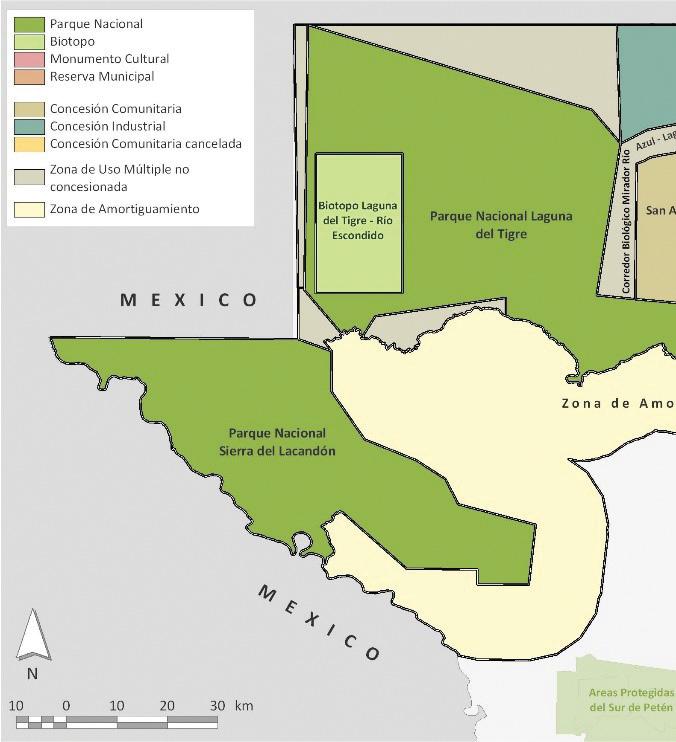
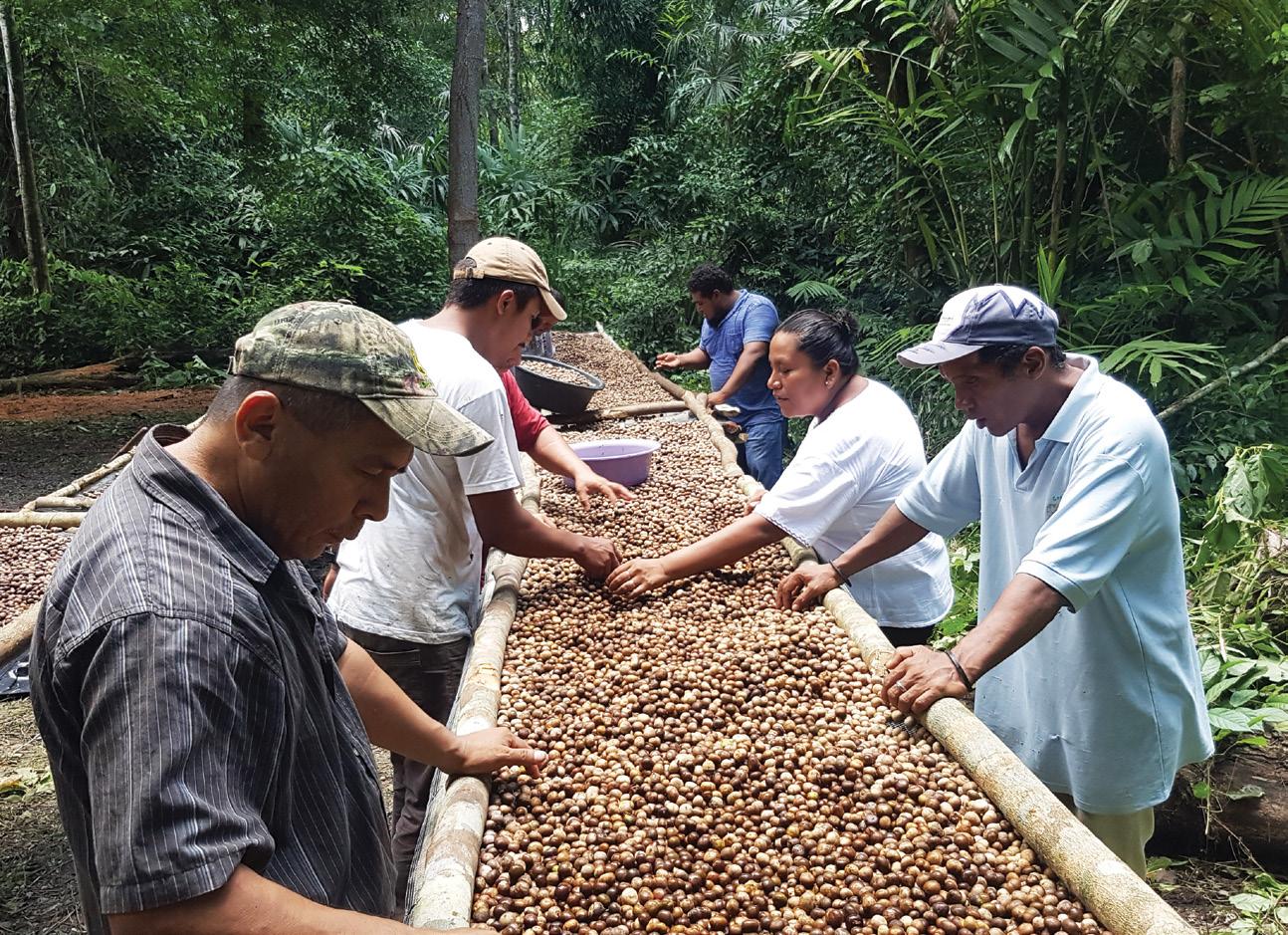

to the Mexican border for smugglers to get their merchandise across, and close enough to Colombia and Venezuela for narcotic organizations to fly their jets and land. This setting also gives the narcotic organizations an opportunity to launder money via illegal cattle ranching in these protected areas. Deforestation for pasture and airstrips by these criminal organizations is causing severe environmental impacts in not only Guatemala but also in Honduras and Nicaragua. These criminal organizations generally clear the forest using fire, destroying everything in its path.
"What we're looking at is not a situation of a lack of governance in Laguna del Tigre, it is actually a particular type of governance in which organized crime has taken over many of the responsibilities of the state for control of territory, resources, labour, etc.
"Now what's happened in the area of the forest concessions is that in the context of CONAP and the Guatemalan state not having the proper resources to fulfill their mission, that ACOFOP has become part of the government structure. So, they are really fulfilling many of the needs that the state was unable to do on its own. What I mean by that is that forest concessions successfully deter narco land grabs and narco-deforestation because community foresters must form committees of vigilance and control for their individual concessions and by law are required to denounce any illegal activities. So, they form these committees and oftentimes work alone or work alongside other state agencies and forces to monitor and to protect their concession lands from invasion."
Community Forestry Concessions include residents of more than twenty rural communities in and adjacent to the MBR. They consist of a mix of Indigenous and Guatemalan people.
Roan McNab, program director of the Wildlife Conservation Society in Guatemala explains, "Many concession leaders are now second-generation forest managers following in the footsteps of
Map: Maya biosphere reserve zones. Community forestry concessions in light brown. Industrial concessions in blue. Multiple use zone in grey. National parks in green. courtesy of acofop. photo: forestry concession workers drying ramón seeds. Photography: la Red de Comunicación Comunitaria / ACOFOP.
“The US-led war on drugs is, in my opinion, the root cause, the root cancer to these landscape changes and the violence that makes them possible. The United States’ war on drugs contributes to narcodeforestation in several ways, it pushes drug traffickers into remote and more isolated territories as they play the cat and mouse game of interdiction...” - Jennifer A. Devine Ph.D.,
their parents, who blazed new paths to obtain the first community forest concessions in the history of Guatemala and of Mesoamerica. Initial community-run companies were extremely experienced in forest skills, yet highly dependent on external technical support for non-forest tasks. Today's community forest concessions have become technically proficient, and the technical aspects are increasingly managed by the children of the original concession pioneers."
When some people hear "forestry concessions" they might think clear-cut logging is taking place. However, what Community Forestry Concessions are doing is harvesting only what is needed while nurturing future growth. No clear-cutting exists, timber extraction is done with highly selective logging with a low harvest of one or two trees per hectare. In fact, community forest concessions in the MBR have a nearzero deforestation rate and have won national awards and international prizes from the United Nations Development Program and the United Nations Environmental Program, providing a management model for other countries. Besides timber, they generate income from harvesting xate, allspice, breadnut, and other renewable forest products. Before the pandemic they also generated an income from tourism. It is in their vested interest to preserve the Multiple Use Zone for their own longterm economic security.
It is also more than just the local communities being able to live off the land as their ancestors did, these communal organizations also protect the biodiversity and cultural heritage of the MBR. And their initiatives not only generate economic benefits but also social benefits as the money stays invested in their communities, providing for housing, education, health care, and job training. They conduct their activities using a community forest model that prioritizes conservation actions.
As well, they are CONAP's principal and most reliable partners. When they see a threat they notify CONAP and their NGO partners or legal authorities. Without the Association of Forest Communities of Petén (ACOFOP), CONAP would need to spend millions of dollars annually to patrol and protect these areas.
“ACOFOP is not just an environmental organization, they have taken on many of the responsibilities of governing the reserve and are performing many social and environmental services that the state should be providing, and have legally entered into governance agreements and have become part of the Guatemalan state in this regard. So in the absence of having ACOFOP and community forestry in Laguna La Tigre and Sierra Lacandón we see that drug trafficking organizations have come in and taken advantage of the lack of presence,” Devine states.

By setting up their own community based sorting and processing 'bodega' for xate, the community of Uxactún has converted a very low value resource to a more value-added one, but more importantly, has created an oportunity for a majority of the families in the community to earn a better basic base income. Uaxactún, Guatemala.
Photography: Jason Houston / USAID.Let us understand why community forestry concessions began and why it is important to continue to support them. First and foremost, the management system works. Secondly, the local communities deserve to have land usage rights. Guatemala has a brutal history of genocide when it comes to Indigenous and rural people, and as restitution, after the last civil war, they were granted land usage rights.
Between 1960 and 1996 an estimated 200,000 people, mostly Indigenous Maya were killed by the Guatemalan military in one of the bloodiest conflicts in Latin American history. During this time Guatemala was run by brutal military dictators, the result of a US-led coup d'état in 1954, code-named Operation PBSuccess carried out by the US Central Intelligence Agency. In 1944, a Guatemalan Revolution toppled the military dictatorship of Jorge Ubico. Democratically elected presidents followed. They implemented minimum wage and land reforms that granted property to Indigenous communities. The United Fruit Company (UFC), who exploited labor practices prior to 1944, then lobbied the United States federal government to overthrow the Guatemalan government. US President, Harry Truman authorized the first overthrow. For more information on The United Fruit Company and alleged violence they incited in several countries, watch the documentary, Banana Land: Blood, Bullets & Poison or The Century of the Self, a BBC documentary that details how Eddie Bernays helped The United Fruit Company and the CIA overthrow a democratically elected leader of Guatemala. Both documentaries are available on YouTube.
Leftist guerrilla group, Unidad Revolucionaria Nacional Guatemalteca (URNG), staged an uprising in the 1960s. Many Maya and other Indigenous people were accused of belonging to these guerrilla forces, even though most had no connection to them. The conflict left not only many dead and missing, but also approximately 1.5 million people were displaced. The genocide, or civil war, as it was called, against the Indigenous and rural people ended in 1996 with a peace accord brokered by the United Nations.
The peace accord gave rights to the Indigenous people, including the right to live off the land. The accord includes the guarantee that rural peasants would be given at least 100,000 hectares of the MBR. This would become the foundation of the community forest concessions. By 1997 the Association of Forest Communities of Petén (ACOFOP) would be created, which now covers over 500,000 hectares of protected land in the MBR.
The cocaine that the narcotic organizations are moving is destined for the biggest drug consumers in the Americas, the US market. This is nothing new. However, circumstances have intensified since the year 2000, with the war on drugs being the main reason why narcotic organizations have moved into these remote locations. The war on drugs has chased criminal organizations into the jungles, making it harder for them to move their products, which in the end makes their products even more expensive and profitable.
Devine states, "The US-led war on drugs is, in my opinion, the root cause, the root cancer to these landscape changes and the violence that makes them possible. The United States' war on drugs contributes to narco-deforestation in several ways, it pushes drug traffickers into remote and more isolated territories as they play the
cat and mouse game of interdiction, it increases the cost and risk of transporting their product which means increased cost of the product along the commodity chain, and ultimately the deep-seated root of narco-deforestation in the Maya biosphere needs to be tackled at its source, which is in Washington DC."
Unfortunately, we cannot go back in time. Territorial control has already been established in these two parks, and we cannot expect the Indigenous communities established in the areas to fight these criminal organizations. To be clear, the Guatemalan military is doing what it can with its limited resources, but without a change in the US policy on the war on drugs, the crisis will not go away for any country in Central America.
"Under President Obama's administration there was some progress in terms of demilitarizing approaches to address organized crime, but President Trump's administration has increased military intervention aid to combat drug trafficking. One of my goals as a researcher is to convey to policymakers in Washington that funding community forestry is a security initiative. Funding community forestry and communitybased resource management is the alternative to prioritizing weaponry and funding and military aid to state governments," Devine explains.
"It's not just security in terms of keeping drug traffickers out it's also about letting people stay in place and giving people the right to 'not' migrate to the United States. It's very clear to me that the drug war and the war on migration are inseparable, they come together in really important ways, not only are drug trafficking organizations controlling human smuggling and trafficking networks they are also engaging in extortion by taxing coyotes. The US policy that has been dismantling the asylum system and the immigration system, combines with the war on drugs to produce the disastrous situation that faces Central America and Mexico today, it's a two-prong related problem."
Even though the success of Community Forestry Concessions is undeniable, there are certain individuals who say they are against any type of logging and have their own agenda in play. Led by Mormon archaeologist and Idaho resident, Dr. Richard D. Hansen (who was granted a permit to carry out archaeological research in the area of El Mirador), the Foundation for Anthropological Research and Environmental Studies (FARES) has been involved in trying to remove Community Forestry Concessions from an area he has tried to control since 2002. In fact, he did succeed for a short time through Guatemalan Presidential Decree 129-2002, which declared an area of 3000 km² as The Mirador Basin Special Archaeological Zone. This decree was superimposed upon pre-existing management units including forestry concessions. But after a three-year battle and protest from the local residents and concessions workers, The Mirador Basin Special Archaeological Zone was rescinded in 2005, and the forest concession model was reinforced. Today, the battle for the parcel of land continues, but instead of approaching the Guatemalan government for support, Hansen and partners have instead turned to Washington, without the consent of the local people it would affect, including the Guatemalan government, stating that US intervention is needed.
The proposed U.S. legislation (S.3131), "The Mirador-Calakmul Basin Maya Security & Conservation Partnership Act" was made public in December 2019 in a press release by Maya Conservation Partnership (West Palm Beach, Florida), in support of Hansen's ongoing initiative for the El Mirador archaeological site or Mirador Basin as he calls it.
Now to be clear, the area that this legislation is seeking to protect, which they are calling the MiradorCalakmul Basin, is already protected by community forestry concessions members and does not face the same problems as Laguna del Tigre and Sierra Lacandon National Parks.
The proposal seeks 60 million dollars in funding from the US Government, suggesting that the land is not protected and needs protection "to establish a formal joint program for the security and conservation" and to "fund field-based tropical and archeological research, law enforcement, and sustainable tourism activities" in the El Mirador region. An additional 60 million dollars is also being sought as a loan from The Central American Development Bank (BCIE) for infrastructure, for a total of 120 million dollars.
"This bill requires the Department of the Interior to establish the Maya Security and Conservation Partnership program. The goal of this program shall be to foster collaborative research efforts between the United States and local entities to create a sustainable tourism model that provides low-impact, controlled access to the archaeological sites of the Mirador-Calakmul Basin in Central America with an emphasis on providing economic opportunity for the communities in and around the basin." – Summary of Bill https://www. congress.gov/bill/116th-congress/senate-bill/3131/.

While preventing drug trafficking isn't specifically defined in the preliminary introduction to the bill, it is detailed in the Saving the Mirador Basin executive summary (FARES). Hansen also uses it in his funding and publicity campaigns as one of the main dangers to the El Mirador archaeological zone. I have first-hand knowledge of this, hearing it from Hansen himself in an August 2019 interview. Hansen includes a slash and burn image in almost all of his presentations claiming that El Mirador is in danger of deforestation because of narcotic trafficking. However, the image is misleading since it is actually a MODIS hot points map of accumulated fires over a 12-year period that ended in 2014. In 2015, Rainforest Alliance published a report that showed extremely low deforestation rates in the area of El Mirador stating that "Mirador-Río Azul National Park is probably the least threatened section of the whole tri-national Selva Maya complex." And in 2017, a report by CONAP entitled Monitoreo de la Gobernabilidad en la Reserva de la Biosfera Maya showed a net gain in forest between 2016 and 2017. The growth is associated with the success of the Community Forestry Concessions program.
I asked Devine what she thought of the bill. Without hesitation, she replied, "It undermines the very goals that it purports to achieve, while it's being pitched as a security and anti-immigration bill rather than a conservation bill - that is how it is being sold to this administration. What is very clear is that this bill would have the direct opposite effect, it would increase immigration to the United States because the 30,000 people who benefit from community forestry are now going to be paid minimal wages in the service sector working for somebody else rather than working for themselves."
Furthermore, the money, which is being solicited for security, would mostly be used as an investment to open a private tourism park that will boast a miniature train, tourist attractions, and hotels.
No environmental studies have been done to support this initiative. However, Hansen proposes that this would be the ideal way to protect the forest while increasing jobs for "poor" locals. More on this can be heard on a Vice News segment, Mayan Ruins in Guatemala Could Become a U.S.-Funded Tourist Attraction, available on YouTube.
This is an example of how the problem areas of Laguna del Tigre and Sierra Lacandón can be used to skew public perception, especially of those in Washington. A closer look at the individuals involved in the movement of this bill also raises questions. For instance, FARES paid $90,000 USD to New World Group, owned by former Congressman Jerry (Gerald) Weller, R-Illinois, to lobby Washington for funding. Supporting the bill in Congress are Senators Jim Inhofe (ROklahoma), Tom Udall (D-New Mexico), and Jim Risch(R-Idaho).
Weller, a strong believer in military intervention in the war on drugs, has a controversial connection to Guatemala with family ties to former Guatemalan dictator, Efraín Ríos Montt, who was convicted of genocide against the Maya people before his death in 2018. His career as a congressman was full of scandals and not only because of his connection to Guatemala. His land deals in Nicaragua put an end to his re-election as congressman in 2007.
Senator Jim Inhofe, a military man whose interests are in oil and gas, is the main supporter of Bill S.3131. He introduced it into Congress on December 19 of 2019. Inhofe is known for calling climate change a hoax, for his support of drilling in the Arctic National Wildlife Refuge, and for his lifetime record of antienvironmental votes — it makes one wonder why Inhofe is taking a special interest in conservation in Guatemala http://scorecard.lcv. org/moc/james-m-inhofe.
Opposition to Bill S.3131 is staggeringly vast. An online petition at Change.org has produced over 200,000 signatures, and organizations
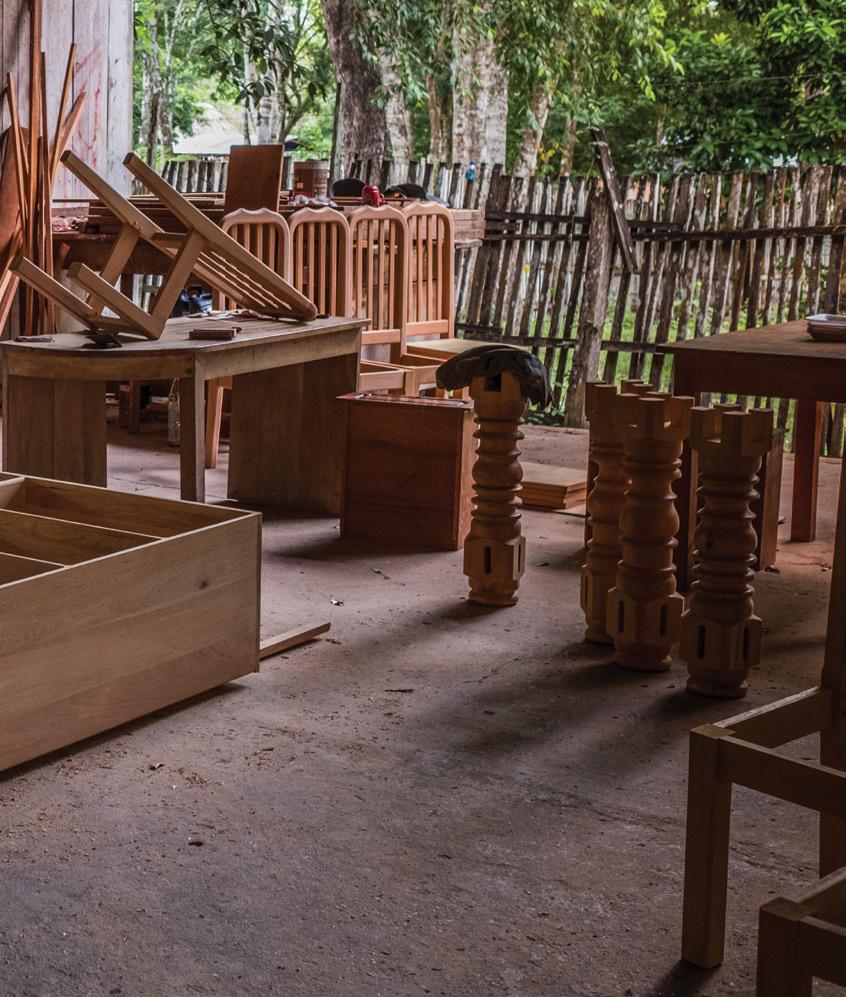
against the bill have come out to state their disapproval. These include an official letter from the Guatemalan Government (June 28, 2020), The Society for American Archaeology (July 13, 2020), The University de San Carlos de Guatemala (July 5, 2020) and several Indigenous groups that include El Consejo de Pueblos K'iche's, Alcaldia Indígena y Asociación Maya Ukux B'e (June 29, 2020). These letters and more can be found on Maya Biosphere Watch website https://mayabiospherewatch.com/#Letters.
It is also important to note that Mexico, mentioned in the bill as a partner (like Guatemala), has stated that they have not received any information on such a proposal. A statement issued by Adriana Velázquez Morlet, Director of National Institute of Anthropology and History (INAH) in Campeche, Mexico, on December 28, 2019, stated, "INAH has no knowledge of any initiative presented by the team of Dr. Hansen that involves any archaeological sites in southern Campeche, Mexico."
Community Forestry Concessions have been successful. Expanding and financing these programs and future programs is the ideal solution for protecting the forests of Guatemala. It may also be the answer for other Central American and South American countries.
"Guatemala's innovative system of community-based forest management holds interesting potential to be replicated across the developing world, and potentially in countries that are well advanced along the development curve. One of the key lessons
from Guatemala, is that strong social support for standing forests is extremely effective at reducing threats. One of the best ways to galvanize that support consists of linking local incomes to standing forests and their ability to generate perpetual streams of income. The decentralization inherent in community-led forestry and sustainable management also provides considerable savings to the State by reducing the need for State-led protection, while also obviating the potential for the "tragedy of the commons", consisting of the misconception that land held by the State and uniquely by the State, essentially belongs to no one in particular, and is thus open and available to all," McNab, clarifies.
Firstly, militarized interdiction activities against drug trafficking organizations that lead to deforestation and narco-capitalized ranchers must end. Policy changes with the aim to reduce the illegal drug trade in the United States must be re-examined. Prohibition, military aid, and military intervention do not work. The focus must be on reducing the demand for cocaine in the United States and treating drug addiction as a health issue. Removing the prohibition and demand is the only way to stop the violence and destruction that the war on drugs causes. This is no small feat. The failure of the US-led war on drugs has been known for many years, and little has been done to change it. In 2012, then Guatemalan President Otto Pérez Molina said, "We have seen that the strategy that has been pursued in the fight against drug trafficking over the last 40 years has failed. We have to look for new alternatives. We must end the myths, the taboos, and tell people you have to discuss it [decriminalization]."
Eight years later we are finally seeing some small changes made, with Oregon being the first state in the US to decriminalize small amounts of hard drugs that include cocaine and heroin. This initiative will, instead of jail time, provide addiction recovery programs to users.
The second thing that needs to be expanded is the investment in Community Forestry Concessions. According to Devine's report, it is a proven policy alternative to combatting drug trafficking. Studies have proved that communally managed lands are more resistant to narco land grabs and counter-narcotic funding should be directed to strengthening environmental governance at the local level through community-based resource and land management.
Finally, currently listed as national parks, both Laguna del Tigre and Sierra Lacandón have a legal status that states that forest management cannot be carried out. As part of the Core Zone of the reserve, the use of natural resources is prohibited in national parks (these regulations have not stopped illegal activities). These regulations are the reason why there is no plan aimed at replicating the concession system in problematic areas. In order to bring in community-based resource management such as Community Forestry Concessions, it would be necessary to modify the parks' category or modify its limits, which would only be possible through the Congress of the Republic of Guatemala. Although this may seem like a complicated process, with the right support behind Community Forestry Concessions it could be accomplished.
What can you do from home? Vote against the war on drugs and tell your senators that you stand with Community Forestry Concessions in Guatemala and encourage Guatemalan officials to expand forestry concessions in problematic areas.
 photography: bruce warrington
BY DAVID SUZUKI
photography: bruce warrington
BY DAVID SUZUKI
Throughout the COVID-19 pandemic, most of us have been living in a landscape defined by unknowns. This lack of certainty about how the world around us can change at any moment shows no sign of abating in the foreseeable future.
Dealing with the unknown is not something our modern society is used to or comfortable with. Over the centuries, we’ve whittled away at the things that once surprised us. We can now check the weather multiple times before we go out so we don’t get caught in the rain, vet movies before watching them, research which hotel to stay in or restaurant to dine at, learn which potential mate likes what we do, and so on.
This can be seen as a continuum of the world view held by Western European settlers who colonized what we now call Canada. When they arrived, the enveloping wilderness frightened them. In response, their main ways of knowing it were mowing it down, shooting it if it moved, taming it and simplifying it in their minds.

Settlers who came here hundreds of years ago colonized nature by clearing forests, creating agricultural lands, rerouting rivers, introducing new species and, ultimately, building settlements. We still, in the main, uphold the dominion-over-nature story that they (and many of our religions) passed on to us.
The settlers also colonized Indigenous Peoples. Among other means, they parcelled land into packages to be owned and gave it to fellow settlers. They created laws prohibiting Indigenous cultural and governance practices. They forcibly moved migratory nations to everdiminishing land reserves. They removed children from their families and placed them in residential schools and foster homes where, to assimilate them into settler culture, they were forbidden to speak their languages and were often abused.
Nature and people weren’t the only ones to be colonized; relationships between people and nature were colonized, too. As Anishinaabe scholar Deborah McGregor notes, “Water, in the dominant Western Euro-Canadian context, is conceptualized as a resource, a commodity to be bought and sold. Federal and provincial governments therefore make decisions about water based on a worldview, philosophy and set of values which stands in direct contrast to the views of First Nations people.”
There’s no question that the significant gains realized by settler society have been built on Indigenous Peoples’ losses under colonization over the past several hundred years and continuing to this day.
These injustices are now widely acknowledged, with a growing desire by many to redress them, advanced as reconciliation. In the words of scholar Lorenzo Veracini, “Colonization was a false promise then; it is an exploded promise now.” Veracini, a professor of settler colonialism, says the challenge now is how to become “a better human being and a worse settler.”
This is a challenge many of us share.
One step we can take is to stop perpetuating the settler story of nature as property or resource. We can create and share stories rooted in relationships that honour nature’s complexity rather than diminish it. We can learn from Indigenous stories about seeing nature as kin, rather than object, and meaningfully include Indigenous Peoples in land-use decisionmaking processes.
Thinking about decolonization is new for many of us. But thinking about it is not the end game. Scholars Eve Tuck and K. Wayne Yang, authors of the article “Decolonization is not a metaphor,” worry that “decolonizing the mind, or the cultivation of critical consciousness, as if it were the sole activity of decolonization” could undermine “the more uncomfortable task of relinquishing stolen land.”
Land repatriation, in its various potential forms, lies at the heart of decolonization. In Canada, we have a number of avenues to “unsettle” the land: work to advance Indigenous sovereignty, support Indigenous land-use practices, shift land governance and change policies that, in the words of scholar Kyle Whyte, “undermine trust, diplomacy, and consent.” We must also create new tools.
Our world isn’t static; it’s ever-changing. We must not just learn to live with its new iterations; we must invest energy into shaping them in ways that right past wrongs. Exploring and implementing different forms of land distribution and governance are key to the task at hand.
David Suzuki is a scientist, broadcaster, author and co-founder of the David Suzuki Foundation. Written with contributions from David Suzuki Foundation Boreal Project Manager Rachel Plotkin. Learn more at davidsuzuki.org.
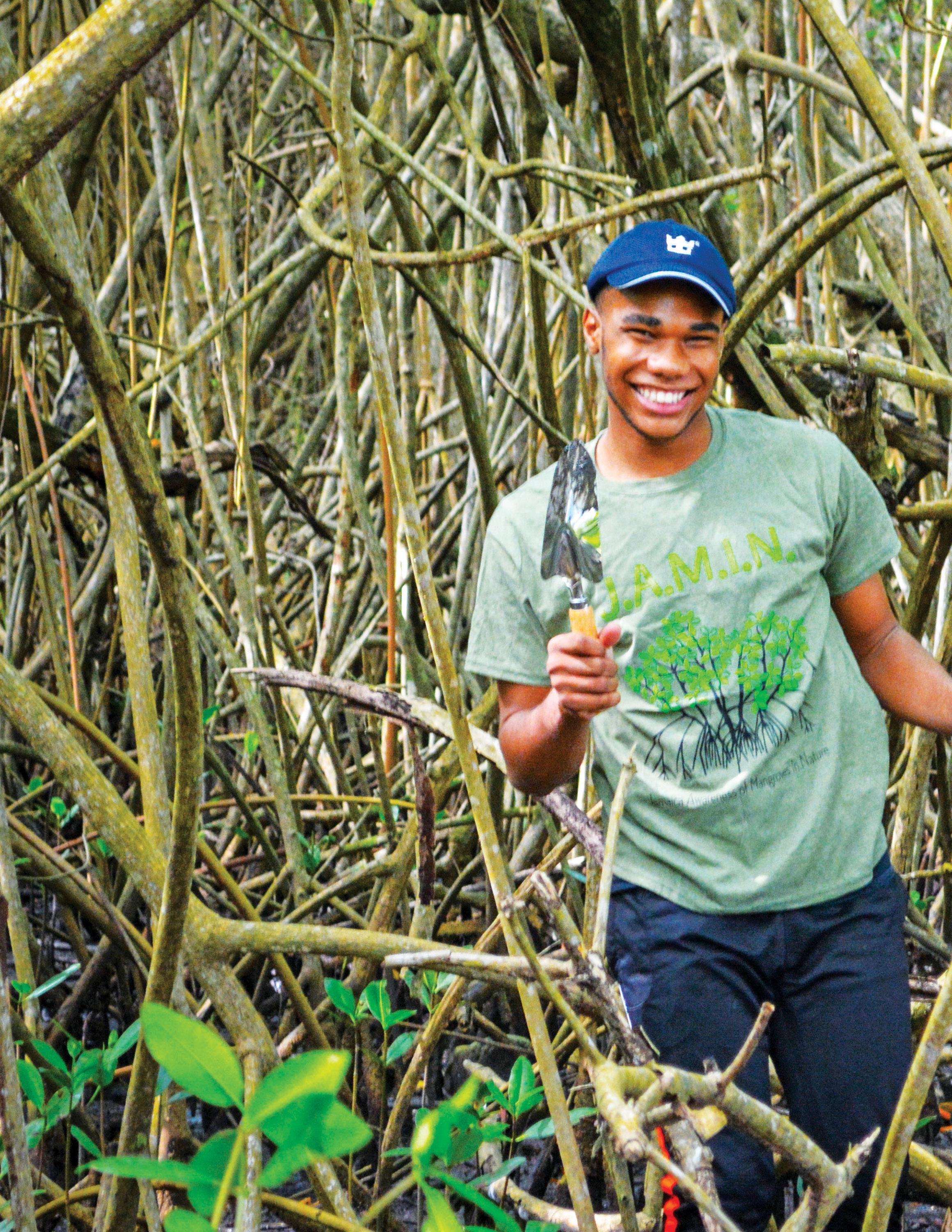 photography: Khaled bin Sultan Living Oceans Foundation
photography: Khaled bin Sultan Living Oceans Foundation
 BY JAN LEE
BY JAN LEE
THE WORLD’S PROTECTOR AGAINST CLIMATE CHANGE
From the tropical bays of Indonesia to the embattled intertidal shorelines of the disappearing Amazon, mangroves were once emblematic of an ecosystem that could adapt its survival to just about any crisis. Their broad, leafy trunks and complex root systems gave them the ability to survive in conditions that most terrestrial plant systems cannot endure: the brackish waters and muddy coastlines that frame the world’s densest tropical regions. Their adaptability also made them one of the most prolific ecosystems in the world. Mangroves can still be found on almost every continent on earth.
Today however, the mangroves are in decline. Half of the world’s mangrove forests have disappeared in the last half-century, driven chiefly by human expansion and commercial development. Just as concerning, tropical and subtropical regions have seen a staggering loss of the wildlife that depend upon mangroves for survival. The Bengal tiger, pygmy three-toed sloth, mangrove finch and roughnose stingray are all examples of endangered species that rely upon this ecosystem.
Mangroves however, don’t just act as nurturing environments for other life systems. They act as huge carbon sinks that prevent greenhouse gases from entering the ocean. They do so by laying down large amounts of carbon-rich soil called peat. The peat and the saline in the water help sequester the carbon and prevent it from being released back into the air.
The mangrove also possesses a unique root system that helps guard against erosion – another potential impact of climate change. The aboveground web of roots helps slow down wave action from storms and the constant ebb and flow of the ocean, while the roots below the soil act as a ballast for the plant. Most mangrove species employ pneumatophores, or breathing roots, that sit above the waterline and help the plant “inhale” oxygen from the air. The carbon that is drawn in is then sequestered in the soil beneath the plant.
It is these unique qualities, says Dr. Ian Hendy, that makes the mangrove an essential partner in the fight against climate change.
“[Mangroves] deliver a whole suite of what we call ecosystem services. For example, mangroves will store up to about five times the amount of stored carbon of a terrestrial tropical rainforest,” said Hendy, a coastal marine ecologist who studies biodiversity in tropical and temperate regions and is based in the UK.
“The problem is, we’ve lost about 50 percent of mangroves in as many years, so what we’re doing is releasing all of that carbon back into the ecosystem.” That’s a problem for marine ecosystems such as coral reefs, which often thrive in areas adjacent to mangrove forests. Hendy said that release of carbon actually has the potential to increase the acidification of seawater, contributing to the die-off of delicate organisms that are unable to survive in that environment.
While some marine organisms can adapt to minor changes in saltwater PH levels, many, like the delicate single-celled organism, foraminifera, which live adjacent to these tidal forests in Australia, can’t survive in an acidified environment. Neither can many of the fish that make their homes near Australia’s Great Barrier Reef.
Above the water, mangroves fulfill essential roles as well, by blocking harmful runoff from agricultural areas. In areas prone to hurricanes, mangroves serve as an important buffer to inland estuaries and help decrease land erosion. Their branches and above-ground root system serve as a haven for animals and birds. That’s why, scientists
say, the ongoing decimation of the world’s mangrove forests can’t be framed solely as a quantitative issue. It’s an economic one as well. According to Hendy, the current level of decline of mangrove ecosystems – which is about two percent per year globally –- equates to a loss of about USD $48 billion dollars to the global economy.
“They have a huge monetary value in terms of fish production, storm defenses, protection for other ecosystems [and] food provisioning for local communities,” he explained. And as some countries are finding, they draw tourism to their shores. “So it’s really kind of a no-brainer that with a relatively small investment, if you compare it to the $48 billion loss a year, we could actually return this investment back into local communities so it generates ecosystem health, resilience and longevity.”
In Jamaica, the Bahamas and numerous other countries, that plan is already underway. Scientists, educators and citizen activists have been working together to redesign the way we think about the mangrove forests. Organizations such as Mangrove Watch in Australia and Mangrove Alliance, a world consortium of environmental organizations concerned with biodiversity decline are working together to monitor habitat loss with remote aerial and satellite tracking systems. Scientists like Hendy serve as the “boots on the ground,” assessing the health and future of this complex plant and its interrelationship with other ecosystems.
Still, many experts feel that protecting ecological habitats really begins with educating local communities about the importance of their neighbourhood ecology. Amy Heemsoth, who serves as the director of education for the Khaled bin Sultan Living Oceans Foundation (LOF) says that since initiating an educational program for high school students in Jamaica in 2014, local perception of nearby forest areas have changed.
“The education carries generationally,” Heemsoth explained. “The kids go home and talk to their families about these programs,” and that helps to further the community’s understanding of why conservation is important. “Word of mouth carries,” she said.
The foundation, which was launched by his Royal Highness Prince Khaled bin Sultan, of Saudi Arabia in 2000, partners with local nonprofits and governments in Jamaica and the Bahamas to promote conservation. An educational component of its work includes teaching kids about mangrove ecosystems and the critical role they play in protecting the health of coral reefs and other marine life systems. A separate program called the Mangrove Detectives offers classes for teachers looking to introduce conservation into their lesson plans.
“The kids are really shocked to learn all these ecosystems are interconnected,” Heemsoth said. “They are amazed at how nature works.”
The J.A.M.I.N. program, launched in 2014, as an eight-month field program for high school students in two Falmouth, Jamaica, schools. It later morphed into a two-year program that teaches students with an interest in biology about mangrove zonation and forest restoration. The program’s popularity and reach continues to grow. More than five schools in Jamaica and Bahamas now teach the program, which LOF is hoping will eventually pave the way to a STEM specialization at universities.
left: mangrove in jamaica.


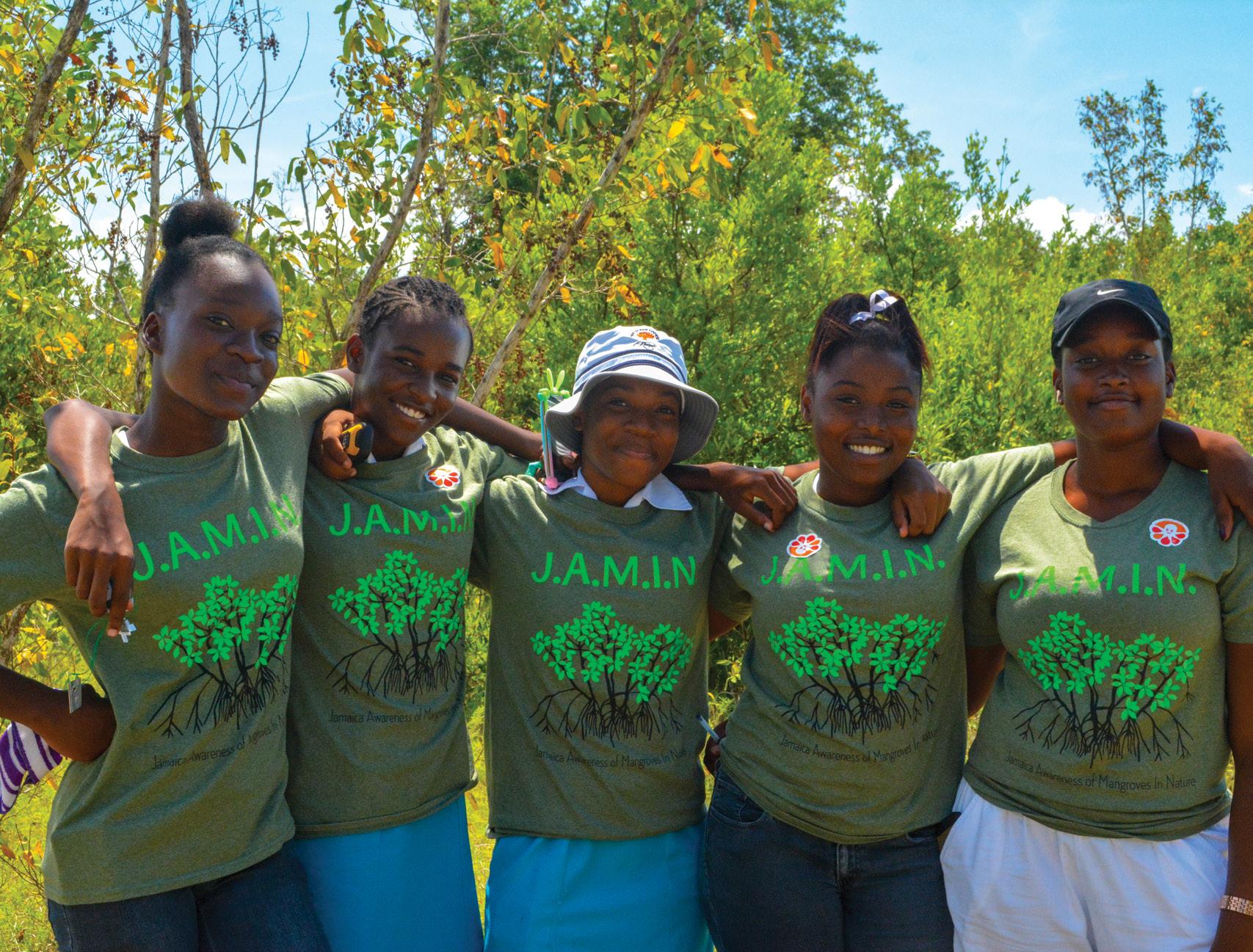

But even if the students don’t end up as biologists, they will have had an up-close and personal appreciation of the importance of their neighbouring mangrove forests and in the process, they are helping further reforestation of mangroves.
“[There] is a huge relationship with a healthy mangrove [forest that has] a great habitat complexity” and diverse and healthy marine life, Hendy said. He used Mexico’s tropical Quintana Roo in the Yucatán Peninsula as an example. “In 1970, Cancun in Quintana Roo was basically a whole mangrove. It was all mangrove. And there were coral reefs in the area.” Today, the peninsula is a textbook case for understanding the potential impacts of population expansion on an area’s biodiversity.
“About 80 percent of those reefs are now in decline,” said Hendy. Clear-cutting of the mangrove forest to make room for population expansion and poor wastewater management has led to increased runoff, higher potential for algae bloom and declining biodiversity. “So there is a big correlation with healthy mangroves, healthy coral reefs, impacted mangroves, impacted coral reefs.”
Hendy’s analysis comes with a caution. While the world urgently needs to address our impact on the environment, he says, we need what he calls “a whole system approach” for our environmental remedies to work.
“Look, I’m a tropical conservation ecologist. And I’m all for every single initiative that happens. But we need to be successful,” said Hendy. “So if you want to outplant corals, that’s great, but if you’re not looking at the source of the degradation in the first place, the coral restoration
won’t work.” That’s why a holistic approach is critical. “[Restore] the mangroves, restore the sea grasses and the coral reefs and probably implement a very good wastewater treatment process ... then you’ll make a very resilient ecosystem.”
And education is critical to that success as well. “I really think we have to start with our youth,” Heemsoth said. Teaching the importance of ecological conservation is critical, she urged, particularly in small developing countries where such topics may not be a regular part of the school curriculum.
“I think education is a means to conserving these ecosystems ...Without it, I don’t think that progress will be made. And I think it’s really crucial, especially for our youth, to understand this. The future of the environment really lays in the hands of our youth.”
The increasing loss of mangrove forests has led to one positive development: in the race to save these essential species scientists are gaining a better understanding of the interrelationship between species and the environment in which they live. As Hendy has noted, protecting the world’s many endangered species takes a comprehensive approach, one that may well start with safeguarding the earth’s unique mangrove forests.
Readers can find more information about mangrove forests and the efforts being taken to save them at the following links: www.livingoceansfoundation.org www.mangrovealliance.org www.globalmangrovewatch.org



Our team was formed approximately three years ago to offer compassion and supplies to those living on the streets in Vernon, BC. Our volunteers donate their time and resources to helping the less fortunate members of our community. We are out on the streets at night and deliver food, clothing, and basic living supplies for men and women. We have formed relationships with these people living rough. They trust us and are very grateful for our efforts.
100% of donations go directly to supplies for our outreach. Any donations over $25 will receive an income tax receipt.
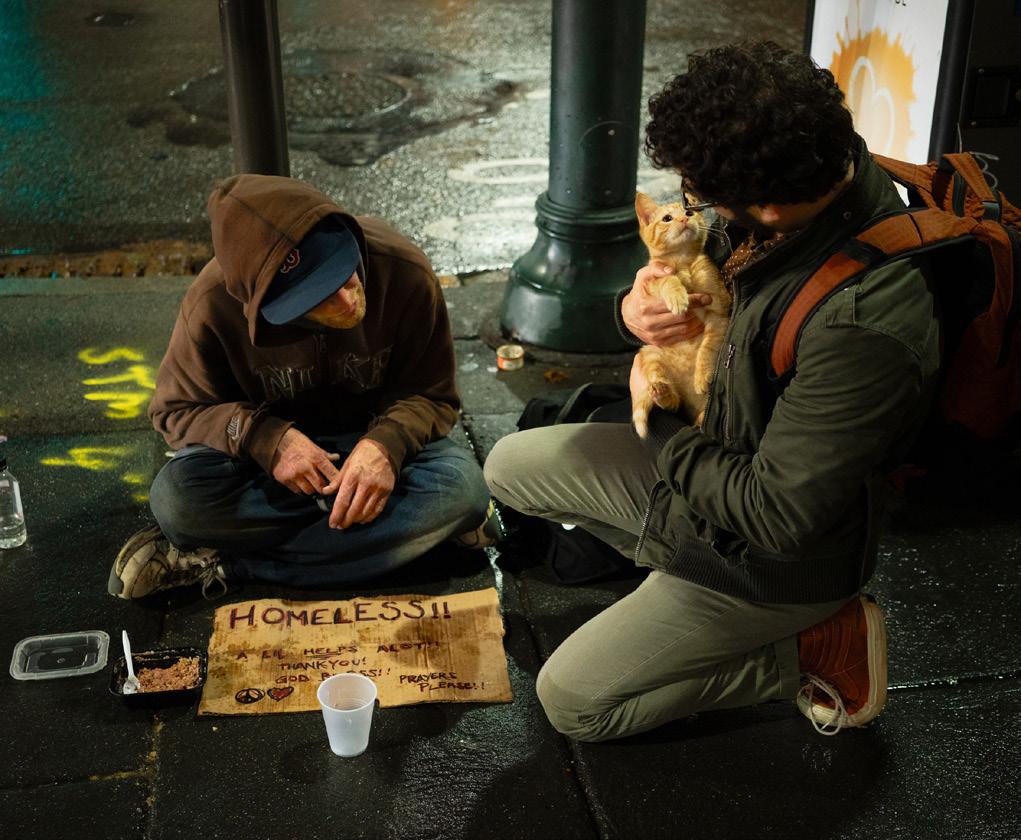
Donations are gratefully accepted by email transfer to:
vernonhomelessoutreach@gmail.com
Cheques can be mailed to:
Jeanne Hanson Arcand, President
Vernon Homeless Outreach Team
581 North Fork Road, Cherryville BC V0E 2G3
Registered Canadian Charity ##785764879 RR0001

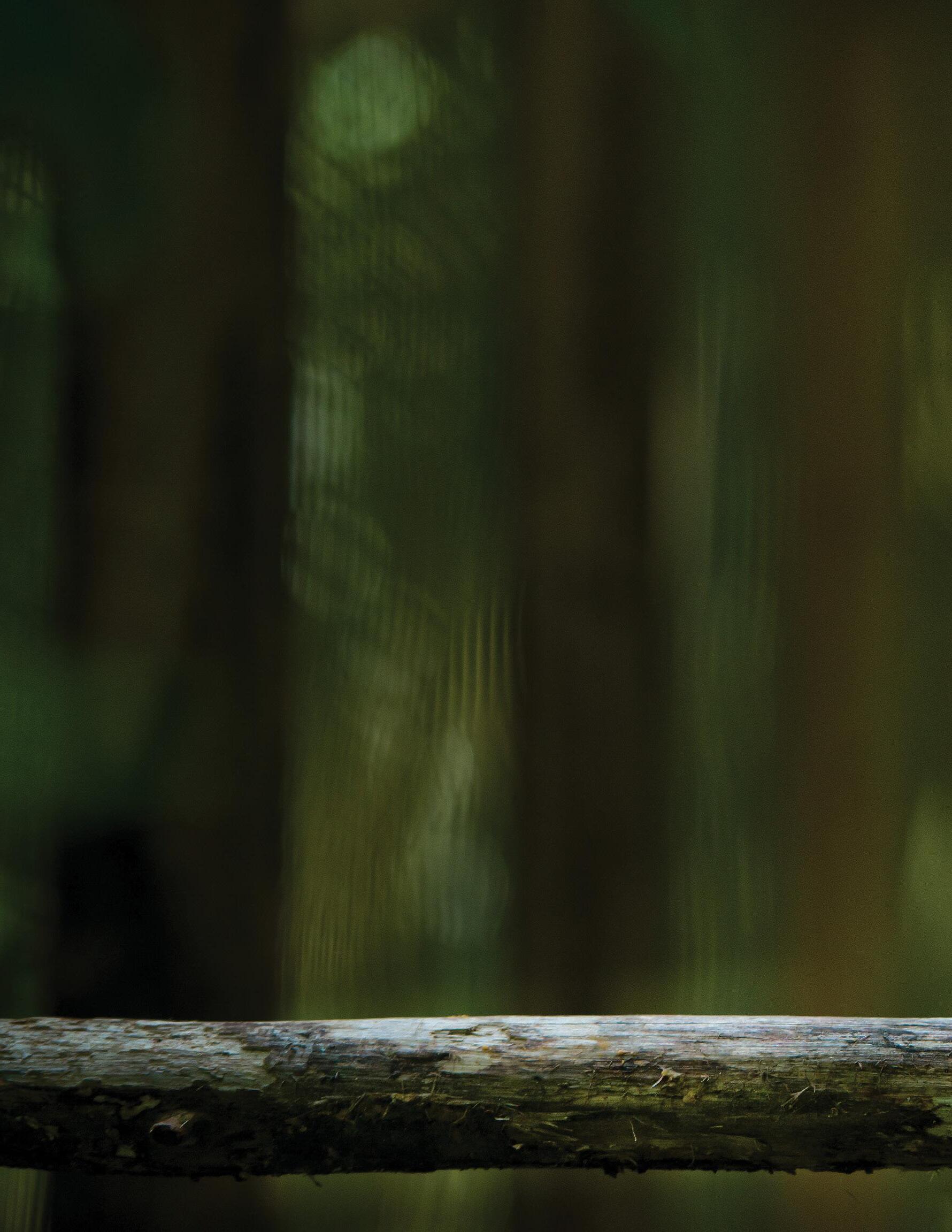 BY Colette kase
BY Colette kase

It can be rather unnerving waking to the sound of maniacal laughter, interspersed with loud arguments in Spanish and English, and the screams of a distressed baby at dawn. I had spent the night at Belize Bird Rescue (BBR), Belize’s only multi-species avian rescue and rehabilitation centre. It is situated on a fifty-acre, private riverfront forest reserve and bordered by over 100 acres of dense forest land. This lush, tropical location is where a dedicated team of conservationists has been trying to save the endangered yellow-head parrot (Amazona oratrix) from extinction. This species of parrot plays a crucial role in maintaining the health of trees by dispersing seeds both directly and through a method of seed dispersal called endozoochory, which depends on canopy feeders dropping fruits and seeds to the forest floor. Up to 90 percent of tree species in rainforests depend on this mutualistic relationship to transport viable seeds.
Belize is a tiny country, making huge efforts to preserve and protect its remarkable and complex biodiversity. According to the Belize Status of Protected Areas Report 2020, just under 60 percent of Belize is covered in natural and intact forest land, much of which is protected by the government in cooperation with NGOs. This includes rain forests, riparian forests, pine forests, and savanna. Historically, Belize’s forests have been its most valuable natural resource. The country, originally named British Honduras, was colonised by the British, who brought enslaved African people with them to cut and export mahogany as this was the only real interest they had in the country. Logging is such a central part of Belizean history that the country’s motto, featuring on its coat of arms is ‘Sub Umbra Floreo’ translated to ‘in the shade we flourish’, referencing the great canopy of the mahogany trees. It is in those canopies, where some of the most charismatic bird species in the world, parrots, are found and their survival is crucial to the worldwide effort in fighting climate change.
Belize Bird Rescue. young yellow-head parrot in chick extraction programme. Photography: Maya Papovic / Conch Creative Photography.Parrots are highly intelligent, flamboyantly coloured, and possess an uncanny ability to mimic sounds, especially human voices. They are also the most endangered group of birds in the world. According to a study undertaken by Birdlife International and the Australian National University in 2016, 28 percent of the 398 species of parrots are now classified as globally threatened on the IUCN Red List, with deforestation and poaching being two of the most important contributors to their population decline. The endemic yellow-head parrot of Belize has been impacted greatly by both. Unfortunately, data on the species is hard to come by. The last population survey across its entire species range, including Mexico, Guatemala and Belize, was in 1994 and showed a 90 percent loss of yellow-head parrots in only two decades with the overall population estimated at approximately 7,000, down from 70,000 in the 1970s. A 2016 Belize Bird Conservancy (BBC) survey estimated that there were only between 1,200 – 1,600 left in Belize.
The traits that make parrots so remarkable are exactly what make them highly desirable as pets. As I toured the BBR property under the careful watch of founder, Nikki Buxton, I learned that ex-pet parrots have a habit of sharing startlingly intimate details of life in their former homes and that is what I had woken to. The one that laughed loudly and continuously disturbed me most of all. I couldn’t help but wonder who he had lived with before. As Nikki showed me the various enclosures and aviaries used to do the painstaking work needed to prepare these birds for freedom, she explained, “People who are involved in the conservation of endangered species are in a race to save entire species from extinction. This means that all their efforts and funding go directly to protecting and caring for these animals, so it can be difficult to find up-to-date scientific data on how fast the populations are declining or even on the natural history of the animals. We have to choose. Do we study them or do we save them?”
According to a report from the American Pet Product Association, in 2017-2018 over 20 million captive parrots were being kept as pets in the US alone. Caged birds are one of the most popular pets in the world coming in fourth after dogs, cats, and fish. Unfortunately, the popularity of parrots has not only led to their endangerment in the wild but also to the need for hundreds of specialist rescues dealing with the fallout.
In the US, it is common to hear among parrot rescuers that there are tens of thousands of abandoned pet parrots warehoused across the country, waiting for new homes. Information collated by the National Parrot Relinquishment Project in 2003 from 779 respondents, noted 5,391 parrots that had been given up for rehoming in just that year. The primary reason given by those surrendering their birds was ‘not enough time’, and if there is anything a captive parrot requires, it is time. Aside from their considerable social and behavioural needs, some species of parrot live up to and over 75 years, often outliving their original owners.
The US banned the importation of wild-caught parrots in 1992. Before that, they were the largest importer of wildcaught birds in the world. Now, most birds sold in the US are captive bred, but that doesn’t mean there isn’t still a thriving market for poached birds. Next to human and drug trafficking, the trafficking of wildlife is the biggest smuggling operation in the world. According to Defenders of Wildlife, between 2005 and 2014, 55,000 live animals were confiscated at US ports of entry, the majority being reptiles and parrots. It seems that captive breeding may even be contributing to the problem through the normalisation of keeping
parrots as pets. The more people have them, the more people want them, and this fuels the trade not just in the US, but internationally. In most countries around the world, wildlife laws are not enforced strictly if at all, meaning that the primary source of pet parrots is trafficking. In Belize, the poaching of yellow-head parrots serves the local markets and those in neighbouring countries. Because of the high mortality rate of chicks during transportation combined with the short lives of parrots in homes where they do not receive an adequate diet, the demand for yellow-head parrots seems to be never ending.
While rescues in the US are seeking permanent homes for parrots, almost all of which were captive bred, Nikki’s work is different. She’s trying to save endangered parrots from extinction by rescuing birds from trafficking and setting them free. It’s not as simple as it sounds. While many of the birds she receives are chicks, extracted from nests to protect them from poachers in a collaborative effort between Belize Bird Conservancy (BBC) and Toledo Institute for Development and the Environment (TIDE), others have been seized by government forestry officers for being kept illegally as pets. These parrots come with an array of health and behavioural problems and it can take up to seven years to fully rehabilitate them if it can be done at all. Is it worth it?
The survival of the yellow-head parrot is crucial to the biodiversity of their rainforest homes. According to the UN FAO, 61 percent of Belize is forest land and of that, 43 percent is primary forest. Around 30 percent of the land in Belize is protected by the government, but along with protections, maintaining the health of the trees in the forest is vital to its survival and parrots are an integral part of that. I asked wildlife biologist, Charles Britt, one of the leading experts on the yellow-head parrot, why so much effort is being spent trying to save the species in Belize. As one of the Board of Directors of Belize Bird Conservancy and also Project Director for Yellow-Head Parrot Conservation Programme, he has committed much of his working life to this species. He explained, “Yellow-head parrots, like scarlet macaws, are charismatic birds that move around the emblematic landscapes. While there is no doubt that their contribution to biodiversity is essential, equally important is their role as ambassadors, which has cascading benefits by protecting less charismatic and well-known species necessary for the survival of broadleaf forests and pine savannas.”
According to older Belizeans, it wasn’t unusual to see hundreds of parrots flying overhead in the 1970s and earlier. They flocked in such great numbers that they were considered pests by citrus farmers, who would shoot them at will to protect their orchards and this certainly contributed to the decline in their numbers. Until recently, parrots and their place in the environment were not studied much at all as they were considered a kind of ‘enemy’ of trees due to their ability to quickly pick a tree clean of fruit. While there are a very small number of studies on parrots in the wild, they are a difficult species to study as they spend so much time in the forest canopy. Endangered parrots are even trickier to research in the wild as there are simply so few of them. So, I thought the best way to find out about yellow-head parrots would be to speak to people who were living and working around them in Belize.
Christian Bech is one of the leading birding guides in Belize. Working as an agriculture manager, he has spent over 30 years observing and studying the behaviour of yellow-head parrots in the wild. I asked him to tell me why the yellow-head parrot is so important to the trees of Belize. “We shouldn’t be looking at individual animals in the forest as they all have an important niche in keeping it healthy, but more as

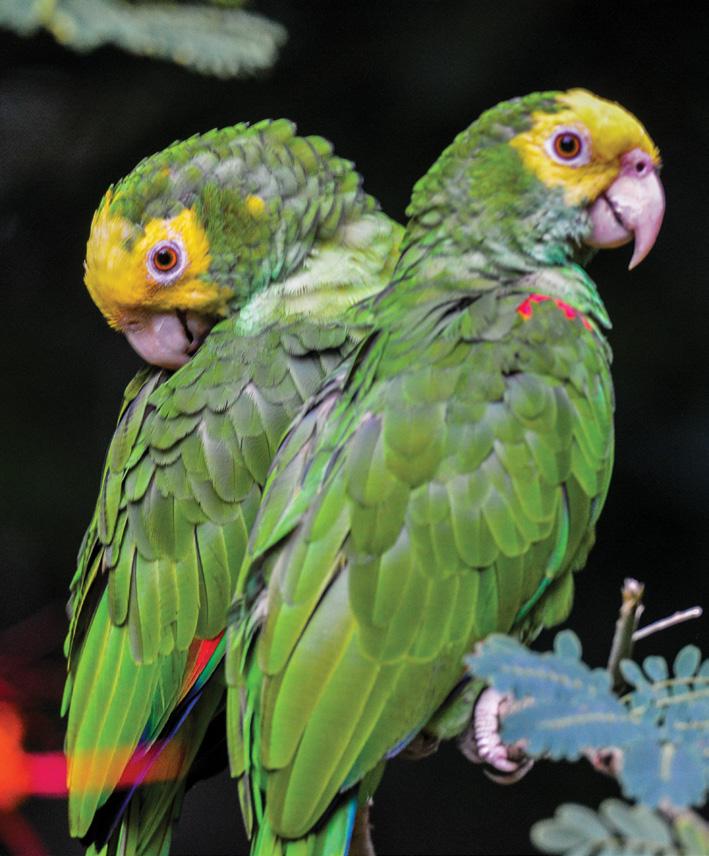
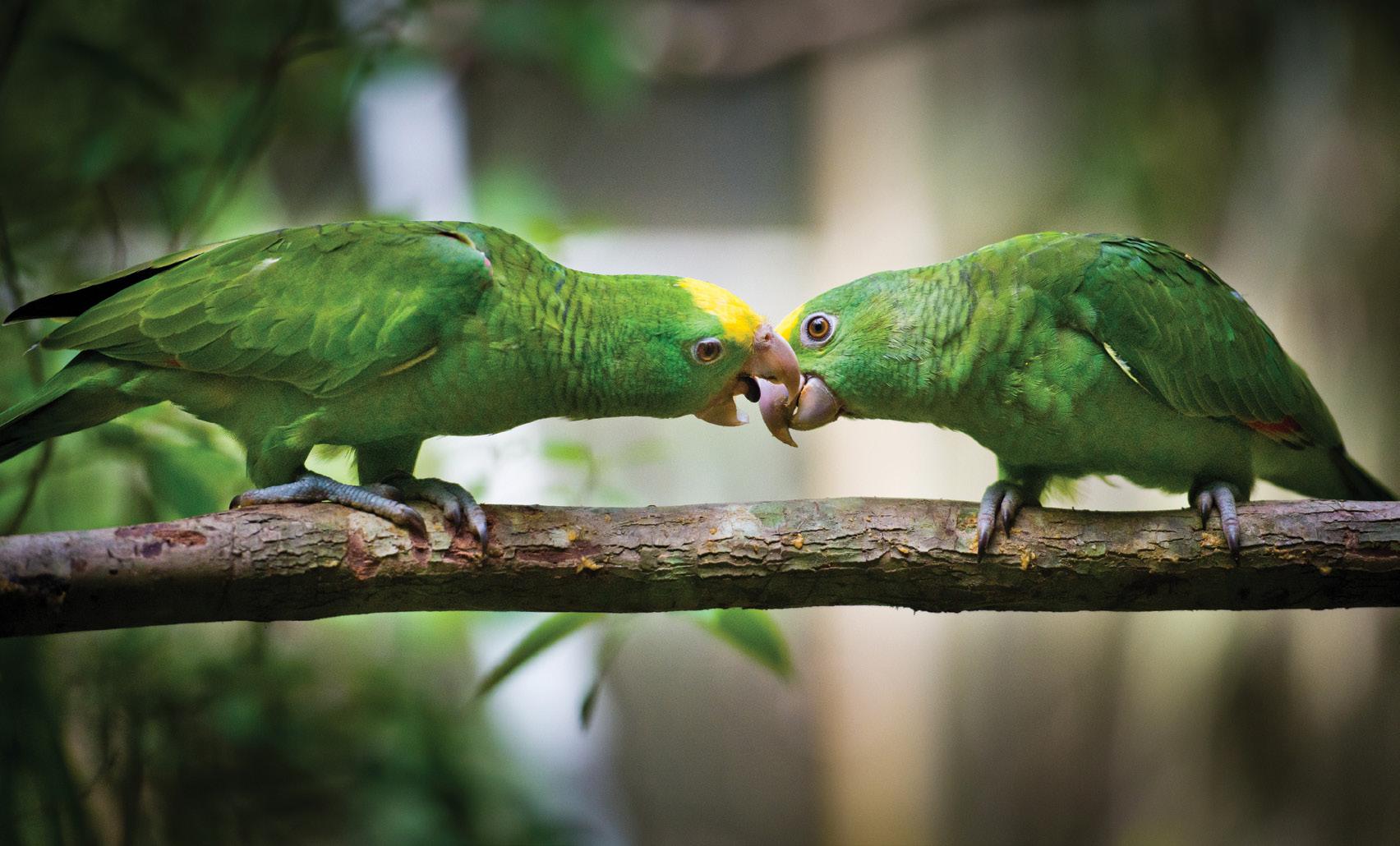
a part of multiple species doing their part of a wider process. Yellow-head parrots drop about two or three out of every five fruits and these, in turn, become food for grounddwelling animals. The ground-dwellers also play an important part in dispersing seeds. Yellow-head parrots may carry fruit to different locations and drop the seeds as well as participating in dispersal by wind. When they move around in trees and pick apart layers, such as those on pinecones, they free seeds up to be carried away by the breeze.”
Yellow-head parrots, like most other parrot species, eat fruits, nuts, and seeds. They are canopy feeders, which means that they can reach fruits and nuts that are out of reach of other forest dwellers and their strong beaks allow them to open seeds that many other birds cannot. Using their nimble claws, they manipulate food items and pick away at their favourite parts, leaving pieces to fall to the ground. Parrots also carry seeds for long distances and even partially consumed seeds that they disperse can produce seedlings. In the case of pine seeds, research conducted by conservationists on specific types of pine seed dispersal by parrots in 2019 showed that the partially eaten seeds were more likely to germinate than the undamaged seeds, indicating that the trees have evolved to attract predators such as parrots.
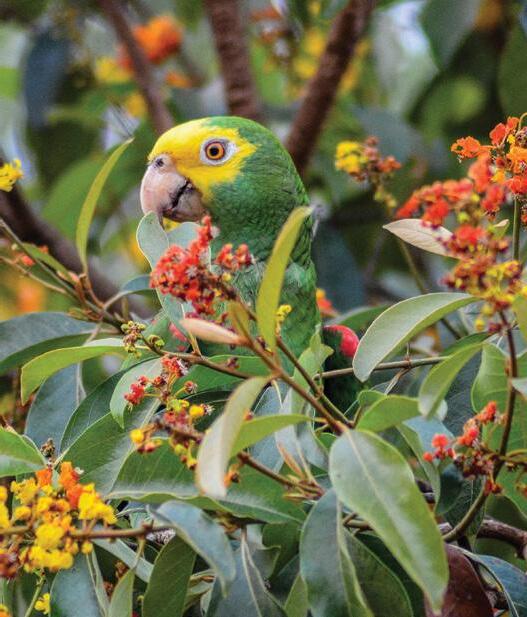
Cand sandpaper trees. He describes them as phenomenal seed dispersers because they travel back and forth between savannas and the edge of the broadleaf forest- helping with the dispersal of species occurring in both habitats.
Everyone loves to hear about jungles and rainforests, while they are sitting around their pine tables at home. It doesn’t occur to them how ancient and valuable pine forests are to maintaining a healthy ecosystem. The pine savannas of Belize are being exploited and destroyed by illegal and legal logging and no one seems to notice or care, because pine trees just aren’t that exciting, but what people don’t know is that some of these trees are over 600 years old.”
onservation biologist, David Hilmy, is the Chief Science Officer for Kutunza Environmental Education Programme (KEEP) and is based in southern Belize. He is responsible for overseeing the translocation and soft release of parrots from BBR. So far, he has released 49 yellow-head parrots and as part of his work, closely monitors them. These birds are all ex-pet birds. I had heard about their role as forest ambassadors and the ways that they participated in seed dispersal indirectly. Now I wanted some real insight into their actual participation in making sure that trees keep growing in the rainforest. So, I asked him if he could provide me with specifics and he most certainly did.
“Yellow-head parrots are extremely important in the dispersal of a number of seeds that they consume naturally in the wild. While many people believe that their primary role is through dropping seeds and fruit, which, in turn, is dispersed by ground-dwelling animals, this is based on observations of parrots in captive or rehab environments. In the wild, they consume, digest, and defecate seeds across the forest and these include craboo, polewood, white Maya, citrus, and figs. There are upwards of 100 species of fig in Belize. Healthy riparian forests, and the fresh watershed that supports them, are essential for figs; in turn, the dispersal of fig seeds throughout these forests ensures this important seasonal fruit is available for a myriad of other tropical species.”
Nikki had even more observations on the importance of yellowhead parrots to the trees and forests of Belize. “If you want to understand what really makes yellow-head parrots important and special, it’s that they connect two types of habitat with two very distinct types of trees. They are the only parrot in Belize that uses one type of forest as their nest home and one as their feeding ground. I asked one of the rangers about this and he told me that he has seen them actively consume, and disperse seeds from, pinecones, craboo, palmetto,
Nikki also pointed out something that is of more immediate concern. “TIDE and BBC do a heroic job in protecting yellow-head parrots nesting in these pine savannas. To keep the parrots safe, they must keep the trees safe. Unfortunately, the COVID pandemic has placed economic and practical pressures on the work that they do and that, along with an increase in poaching, has forced them to make difficult choices. The poachers have learned that by setting fires, they can draw the team away to fight the fires and then raid the nest boxes that have been placed in the trees to provide safe nesting sites for the birds. The rangers have no choice but to fight those fires and that’s how I received 17 yellow-heads this year. They just didn’t have the resources left to protect the birds, so they pulled the chicks and brought them to me to be raised as part of our programme.”
Those 17 chicks will eventually join the 80 others that have been successfully reared and released by BBR since 2014. Their trained staff will do the painstaking and difficult work of feeding, providing medical care, and helping these babies form healthy social relationships, which includes forming flocks and finding a mate for life. Once that is achieved, it’s up to them. They are released when they are one year old but are not sexually mature until they are five. While they can lay anywhere from one to four eggs in each clutch annually, normally a maximum of two survive from each nest. With such a small population of these birds left in the wild in Belize, this little bird rescue in a country that very few know about is on the frontline of those pushing back against mass extinctions.
That evening, Nikki and I sat on the veranda of the guesthouse at the bird rescue and watched the sun set over the forest in front. All around us parrots were flying in to help themselves from the feeders she provides for those that live on the property and still like to visit for some free food, and I watched as squirrels and agouti, short-eared, rabbit-like jungle rodents, gathered underneath to catch the leftovers. I considered how lucky I was to see this example of an interdependent ecosystem, functioning in front of my eyes and wondered why we, as humans are finding it so hard to understand its importance. Suddenly, the forest filled with a cacophony of sounds as the animals and birds living their wildest lives in and underneath the trees, prepared for sundown. With no less enthusiasm, I could hear the ex-pets, contributing their own bizarre, and unnatural sounding clamour to the din. The contrast was a harsh reminder that we, as a species, may have stopped seeing the forest for the trees.
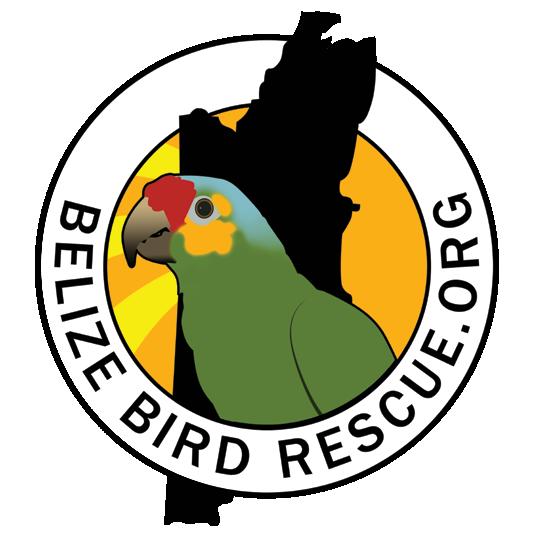

 BY NICHOLAS HELLMUTH
BY NICHOLAS HELLMUTH
When one thinks of trees, thoughts don’t necessarily turn to trunks and the quantity of plants and comparable organisms that use them as their space to grow and prosper. At FLAAR, we specialize in the educational research of flora and fauna in Mesoamerica. We work together with Q’eqchi’, Kaqchiquel, Pokomchi’ and other Mayan groups in several Guatemalan communities to bring about a comprehensive understanding of the importance of our wild areas. This includes educational material for local schools and provides high-quality information on rare plants and endangered animals. Part of this study includes the photography of these species.
In this article we look at the tree bark of the Neotropical rainforests of Guatemala, specifically the fissures and indentations in the bark, which capture leaf litter and provide a literal garden of material for ferns and other interesting plants.
LICHENS
The multiple species of life that depend on the tree trunk for their home include lichens and mushrooms, which, while not classified as plants, grow on tree trunks. The typical lichen is whitish; in fact if you were to hike the rainforests of Guatemala you would think that many of the species of trees are all white. But after you spend more time you begin to notice that the white you see is not the actual colour of the trunk, but is a thin film of pervasive lichen, that can often completely cover the tree trunk, frequently occurring in patches as well.
Greenish lichen, pink lichen, rose-colored lichen all also pervade the forest here yet many tree species have no lichen at all: their thin, almost slippery bark has evolved to deliberately peel off, so that lichen, vines, and lianas (woody vines) can’t grab hold of the trunk.
During 2018-2019, we spent one week each month hiking through the biodiverse ecosystems of the hills, swamps, marshes, savannas of Parque Nacional Yaxha Nakum Naranjo (near the border of Guatemala and Belize). We began to also notice that multidimensional lichens often exist, but that these tend to encircle thin branches and twigs, though if you have radar-vision and patience you can sometimes find 3D lichen on a tree trunk. Approximately 99 percent of the lichen you see as you hike through the rainforests is flat or edge-curling lichen on tree trunks. It is likely that there are hundreds of lichen species that are, as yet, undiscovered, but, no doubt, in time, will be recorded, photographed, and published. Of these, more than half will likely be found on tree bark. Tree trunks are a crucial part of the world to protect.
Since the rainfall is different each month in Guatemala, you find different mushrooms bursting out at the height of the rainy season. Yet if the living tree trunk is aging and has broken areas that are decaying, you occasionally get small mushrooms up to two meters off the ground (and a lot on the first 70 centimeters from the moist rainforest floor) showing that this life form is incredibly diverse.
Liverworts love tree trunks in humid environments. Liverworts tend to grow horizontally so are not found with “branches” or tall stems. They do not produce flowers or fruits either, so they can be hard to spot. They multiply by spores. The most apparent are the leafy liverworts.
Liverworts cover many tree trunks but unless you study them, they are a challenge to distinguish from all the mosses and miniature ferns clustering on the same trunks.
Moss grows on rocks all around the world. But it’s in the trees where moss is apparent through the rainforests of Guatemala. Sometimes the moss covers so much of the tree it's impossible to see the bark. Moss comes in many species, sizes, and shapes and serves to remind us that we are in a humid ecosystem such as Chocon Machacas nature reserve, El Golfete area of Rio Dulce, Municipio of Livingston, Guatemala.
Tree ferns, in the quetzal bird inhabited cloud forests of Guatemala, literally rise to the height of a tree. The trunks are greatly prized as solid, non-rotting lumber for house construction, especially among the local Pokomchi’ Mayan people.
There are numerous large ferns in the swamps of Peten and Izabal, en masse (up to thousands in one area). Like most plants ferns need dirt or comparable organic material for their roots. Fissured tree bark is perfect, since rainwater flows down the tree trunks bringing debris from the upper part of the tree that catches in the cavities of the tree bark. The roots of ferns, mosses, and vines love to grow down into these soil-filled furrows.
The crevices of tree trunks catch falling leaves, twigs, and fertilizer from ants and birds. These available open areas of the bark are called leaf litter traps. All this material provides a miniature ecosystem for ferns, and lots of other plants to grow.
The ants often seen hiking up and down tree trunks loaded with cargo, are the leaf cutting (and flower cutting) ants; their nests are on the ground, but the leaves and flowers they require are up in the tree canopy. As a result, hidden under ferns and bromeliads on the tree trunks, are “ant gardens”, where some species of ants provide “fertilizer” and other useful materials which they then bring to the tree. The ferns and bromeliads provide hollow spaces for the ants to nest. The ants, in turn, bring seeds of epiphytes into their paper-like nests and the seeds grow into selected species of plants whose leaves then protect the ant nests from potential damage of direct rainfall. The plants cling onto the tree-trunk, which helps the nest hold on also.
A better known, and easier to see form of mutualism (a form of symbiosis), would be the guarumo tree trunks (Cecropia peltata trees), which are everywhere in Mesoamerica. Their hollow trunks provide space for the Azteca ants to live, protected, inside the trunk.
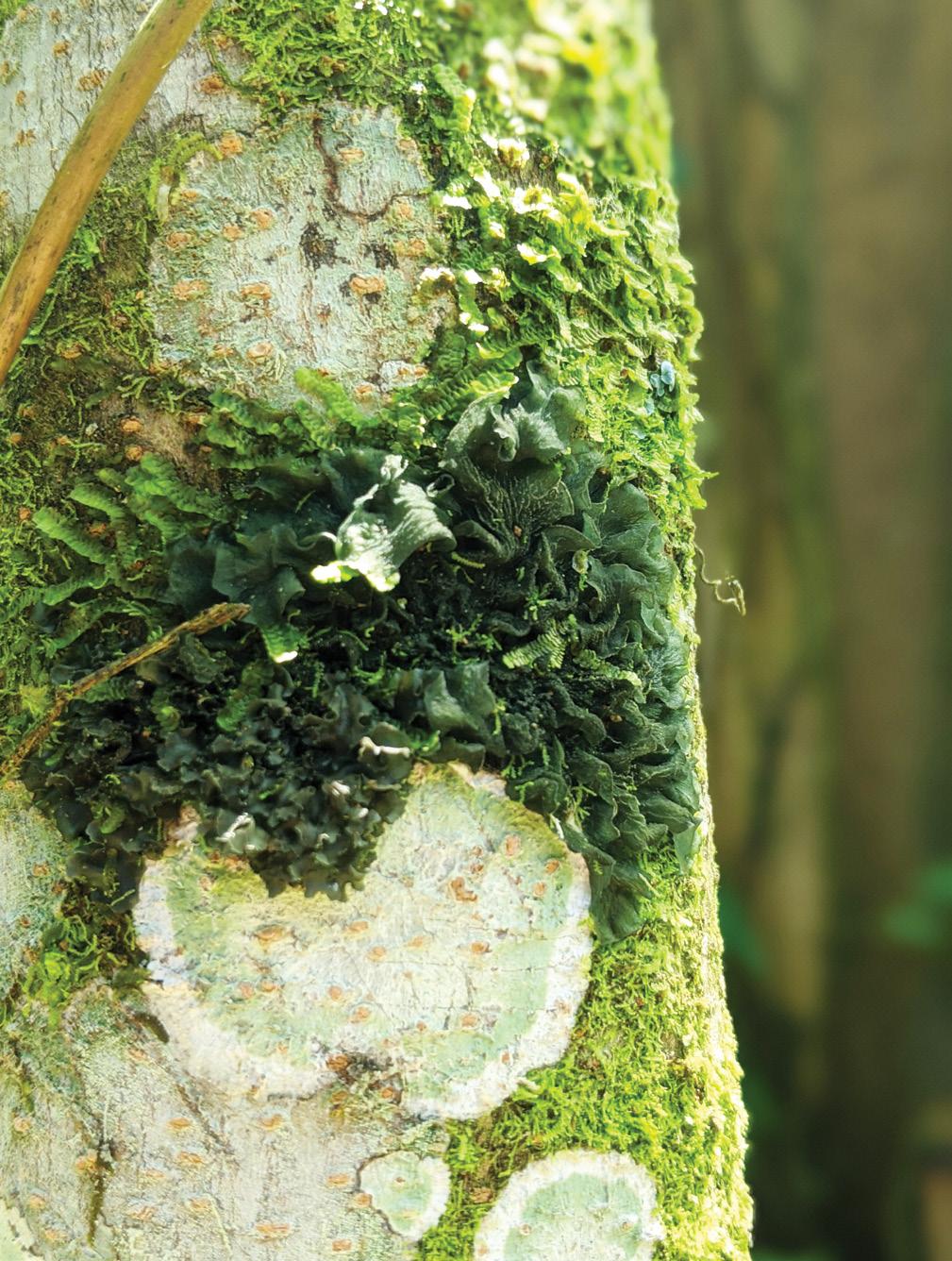
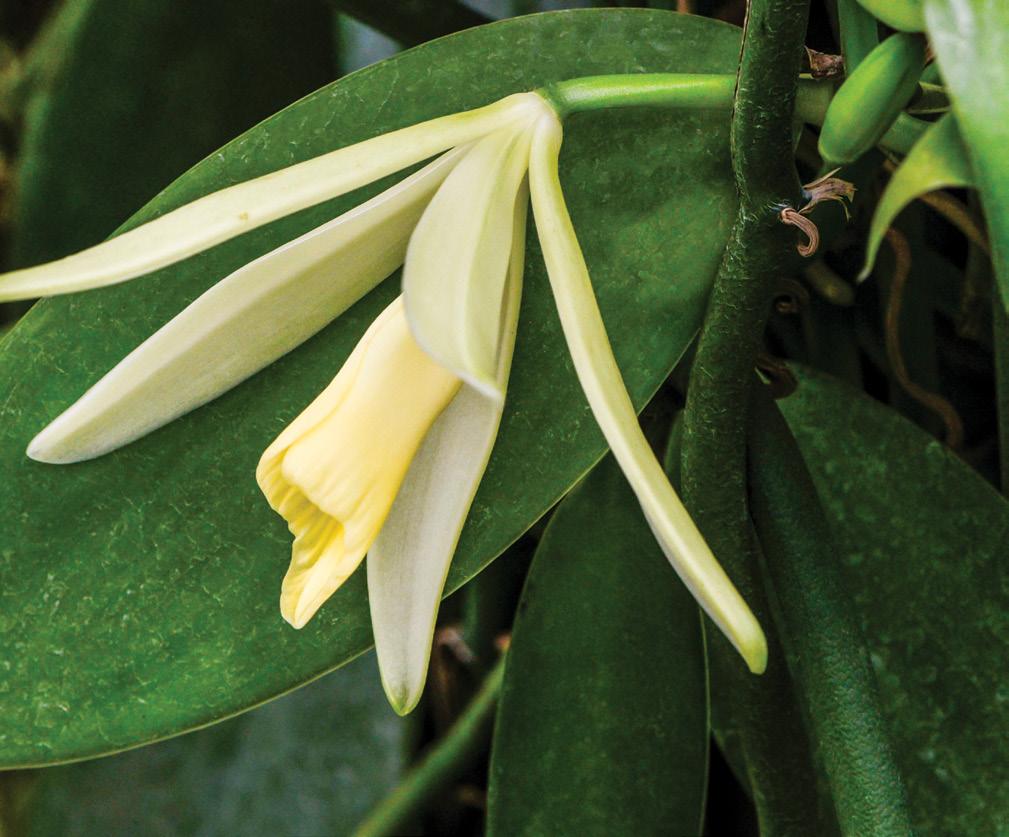
The Cecropia also exudes a chemical that the ants love to eat. In return the ants fiercely protect the tree by attacking anyone careless enough to bump into the tree.
Simply tap your finger on the tree trunk and the ants pour out to confront their potential attacker. It is fascinating to realize how ants and plants have evolved together to each help the other and each benefit from their mutual presence.
Some animals, like kinkajous and howler monkeys, prefer to stay near the tree tops. But spider monkeys climb down the trunks to find water, or to walk to other prospective trees that they can’t reach by swinging through the branches.
Jaguars and margays use the tree trunks to climb up to capture and eat fresh meat.
Anteaters of several species need the tree trunks to climb to find termite nests and ant nests. Leafcutter ants, as previously mentioned, climb up and down the tree trunks to harvest leaves (and flowers) and take these down to the ground and then to their nests to raise fungi on these leaves and flower petals to eat (so yes, these ants raise “crops” in underground gardens to feed themselves).
Termites have paths up and down the tree trunks; termites are blind and they build tunnels, which are plainly evident on many trunks.
The fruits of the many vine species that make the rainforest their home, go to seed far above, up in the treetops. Birds or animals eat these fruits and defecate the seeds out packaged in ready-made fresh fertilizer. The seeds are then equipped for a safe landing and have the nutrients required to sprout on the floor of the rainforest. The tender young vines crawl along the forest floor until they find a tree trunk, and then they begin their struggle to utilize the tree trunk to grow up to the treetops to obtain sunlight for their leaves.
Year by year, decade by decade, some tree trunks get covered by vines. Falling leaves get caught, debris from the canopy gets caught, and so a mini-ecosystem develops on the trunk that enables ferns, orchids, bromeliads, and liverworts to grow on the trunks.
Most vines are admired because they are beautiful. But many vines produce edible fruits such as Passiflora vines. Monstera deliciosa vine has its name because part of it is good to eat. Most other aroids, other Monstera species and lots of Philodendron, species climb up and down tree trunks. These stay pegged to the trees (not like the woody vines, the lianas, that often form their own masses separated from tree trunks).
Today we pollute the rivers, lakes and oceans with tons of plastic. The Maya, for hundreds of years, made fibre, cordage, rope, and comparable materials from diverse plants. They continue to do so to this day. Mimbre is the most popular vine that grows up tree trunks that produces great rope. Plus there is a palm that is not a “palm tree” it’s a palm vine. This vine grows up trees and then wanders around up above. The vine is used for constructing wattle-and-daub walls for houses and for weaving hats and baskets. So trees are essential for the vines that produced household products before plastic factories polluted our planet. Vines are a renewable resource that can be used to produce biodegradable materials.
When you hike through Isla Topoxte, or any of the hilly areas of the Lake Yaxha park, you see cacti of various sizes and shapes growing up the tree trunks. This is a rainforest, so there are no desert-loving candelabra cacti, no Opuntia cacti, no ground cacti whatsoever. All the cactus plants in southern Peten, Izabal and Alta Verapaz are on tree trunks. The fruits of many are edible (commercial species are served around the world as dragon fruit). The spectacular flowers of Selenicereus testudo and most other cacti on the tree trunks are larger than 90 percent of orchid flowers on the same tree trunks. We are so used to cacti in dry areas of Texas, northern Mexico, Oaxaca, and the dry corridors of Guatemala (parallel to Rio Motagua and Rio Sacapulas) that it’s a wow factor to learn that all the cacti of the rainforests grow on tree trunks.
We understandably consider parasites as nasty creatures or plants that cause damage and injury to their host tree. Cuscuta parasitic vines (dodder vines) and its equally parasitic mimic (Cassytha filiformis) are so photogenic, I keep specimens in my ethnobotanical research garden, itself located at at 1500 meters elevation, overlooking Guatemala City. It is not necessary to plant a parasitic vine: even vine segments, broken from above are able to latch onto the leaves and trunks as the Cuscuta grabs hold. At the Yaxha park arboreal parasitic vine flowers are among the most beautiful botanical displays of the park. Parasiticlike Ficus trees, strangler figs, are more lethal to tree trunks but they are also impressive.
Orchids in our study area grow while floating on reed root masses, kept just off-shore. Other orchids grow directly on the shore and remain submerged during wet months when the swamp retains more rain water. A few orchids grow in the ground far from lakes or rivers, but usually in areas where fog and rain are common. Most orchids grow on the forks of trees and along the top of limbs and branches. But there are plenty of orchids that find enough leaf litter caught in
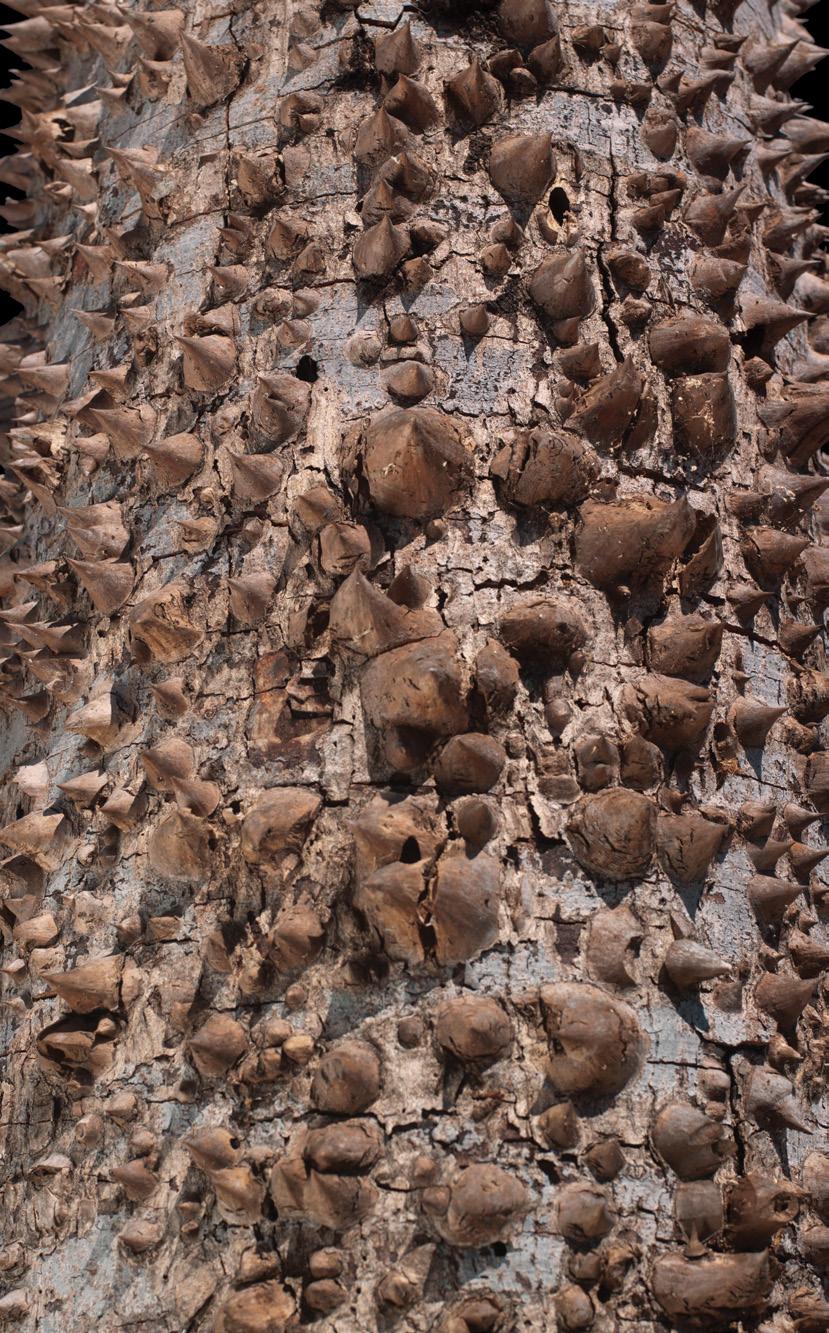
 Top Left: Tree trunk in Guatemala with circular off-white flat lichen, and a mass of rarely so easy to see 3-dimensional lichen (like dark green tongues sticking out at you) surrounded by moss-like growths and other amazing Neotropical species, plus a vine diagonal across the top. Every tree trunk in these rain forests is a different "botanical garden." Bottom Left: Vanilla orchid. Top right: Ceiba Petandra. Bottom right: Reddish lichen. Photography: Nicholas Hellmuth.
Top Left: Tree trunk in Guatemala with circular off-white flat lichen, and a mass of rarely so easy to see 3-dimensional lichen (like dark green tongues sticking out at you) surrounded by moss-like growths and other amazing Neotropical species, plus a vine diagonal across the top. Every tree trunk in these rain forests is a different "botanical garden." Bottom Left: Vanilla orchid. Top right: Ceiba Petandra. Bottom right: Reddish lichen. Photography: Nicholas Hellmuth.
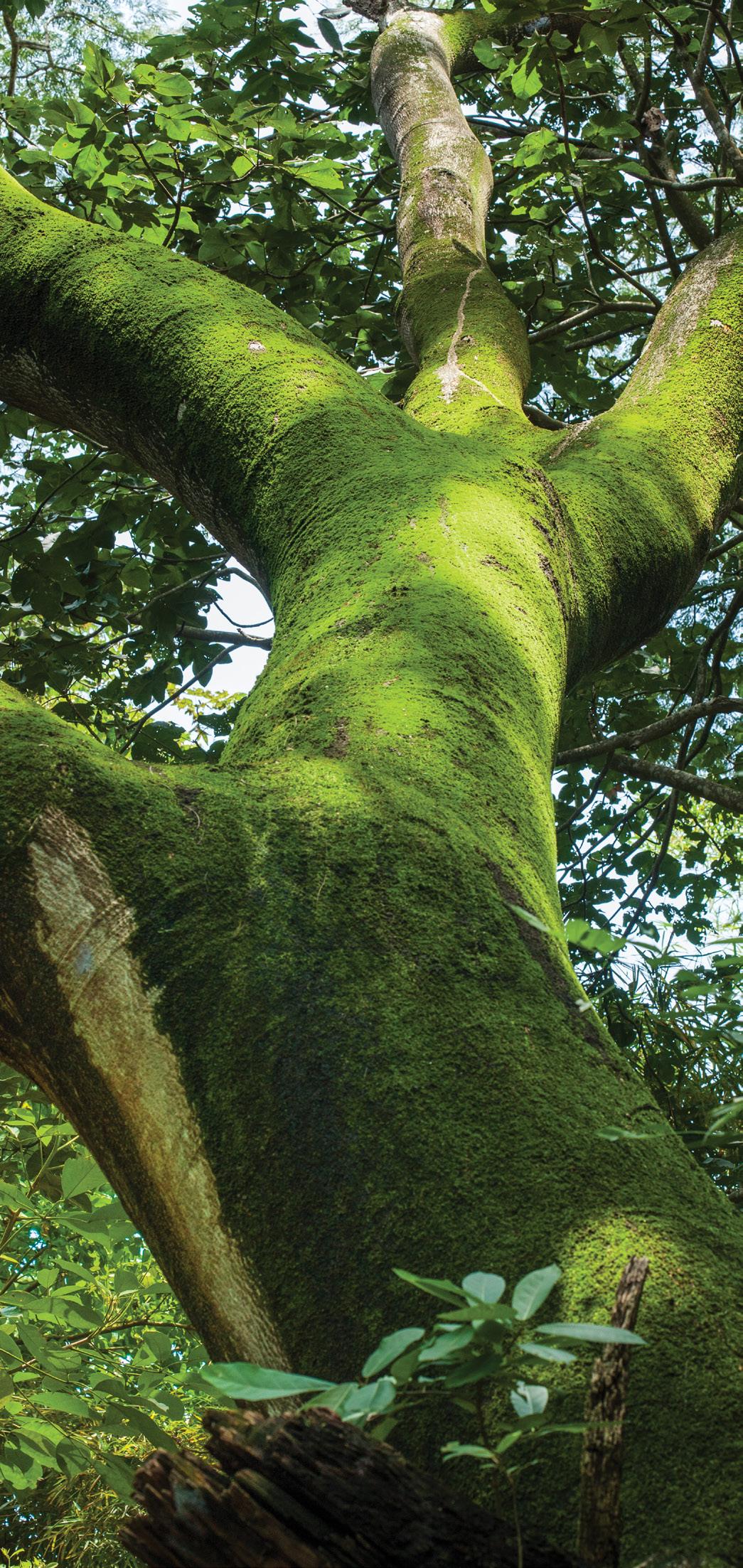
the rough surface and furrows of tree bark that they can grow on the tree trunks. Arboreal orchids require binoculars, digiscope, or a 800mm prime telephoto lens to photograph when in flower.
Terrestrial bromeliads form dense clusters of hundreds around waterholes throughout the Peten rainforests. Arboreal bromeliads form such dense clusters along branches and limbs that these branches come crashing down from the weight (especially when it rains and the centres of the bromeliads fill up with water). But there are also bromeliads that anchor themselves individually on tree trunks.
Tree bark was a source of dye colourants in the Mayan and Aztec era before chemical factories produced artificial colorants. Three-dimensional lichen and several mushroom species of Guatemala are also sources of dye colorants. Tree bark was a source of “bark paper” for the Maya, Aztec and their neighbours. Several different species of native fig trees are best known for the bark paper they are used to make. The Maya made clothing and books from bark paper. Tree trunks have always been essential to humankind. Let’s make more effort to protect tree trunks.
Tree trunks provide latex for the rubber that was used to make the rubber balls for the Mayan ballgame and for their sandals. The latex was coagulated (to make it bounce) with chemicals from an Ipomoea alba vine that grows on tree trunks throughout Peten and Alta Verapaz. Resins from tree trunks provide incense, such as copal, used both for native Mayan incense and for modern church incense. We have found four trees whose latex is edible or potable. Tree trunks provided crucial material for the Mayan people for thousands of years: they had no cows to milk but they had trees instead.
Environmentalists understandably seek to protect “the forests”. I wish also to protect individual trees, tree by tree; yes, the entire area and complete ecosystem. Let’s also protect the fragile rainforests from the bottom up.
For more information on FLAAR visit www.flaar-mesoamerica.org/
Left: moss covered Ceiba. Photography: Nicholas Hellmuth.

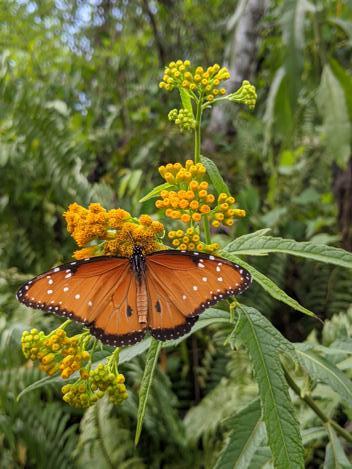


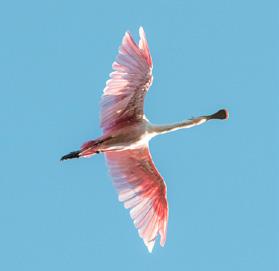
Birds appreciate when their wetlands are not filled with chemical runoff from commercial plantations. We are currently doing field work and field photography of waterbirds in protected wetlands in Parque Nacional Yaxha Nakum Naranjo (Peten, Guatemala), and in Parque Nacional Rio Dulce and other areas of Municipio of Livingston, Izabal, Guatemala.
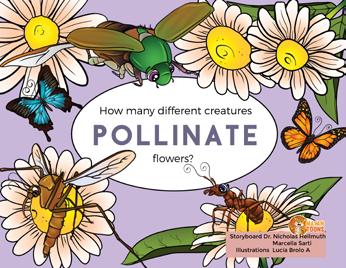
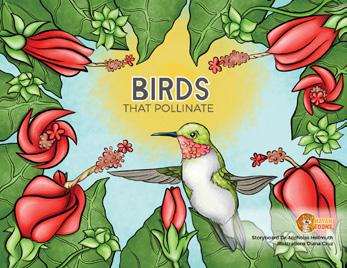
Definitely helps to have family-friendly educational books and animated videos to explain to families and the new generation (t how many pollinators there are: bees we know, but let’s not forget butterflies, bats, and lots of birds besides just hummingbirds.
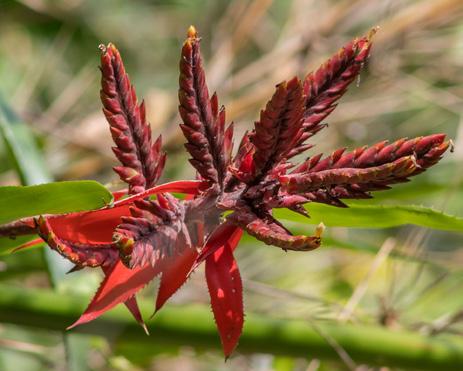
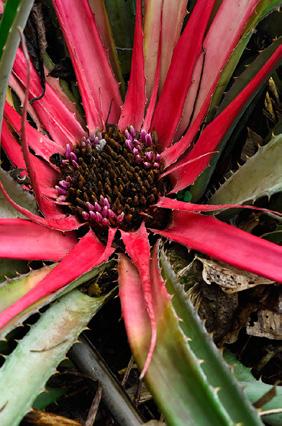
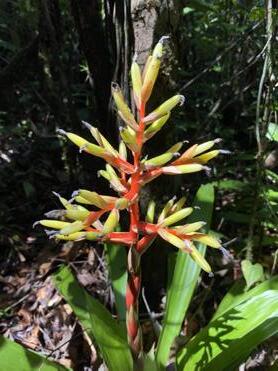
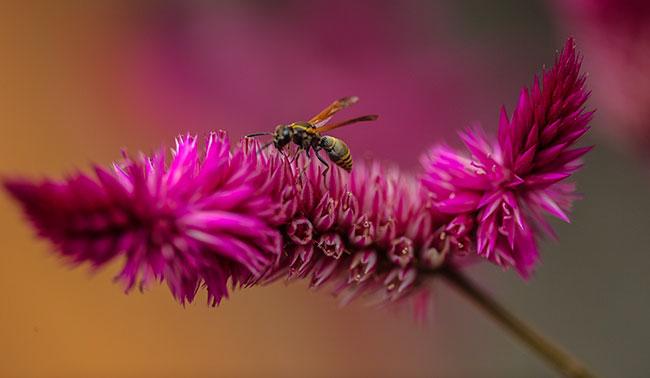
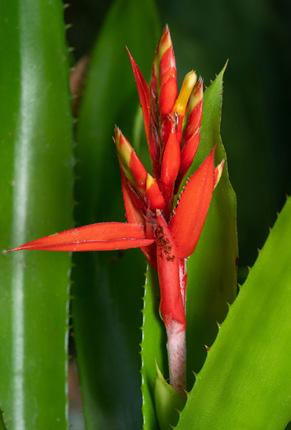
We all love orchids, but let’s not forget to protect the fragile ecosystems of terrestrial and arboreal bromeliads of the Neotropical rainforests.


We all love garden flowers, but the giant rainforest trees also have amazing flowers. Let’s work together to protect the hillside forests, savannas, and wetlands tree areas so that life on our planet can recoup itself.
www.maya-ethnobotany.org
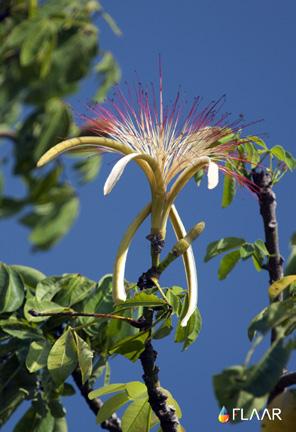
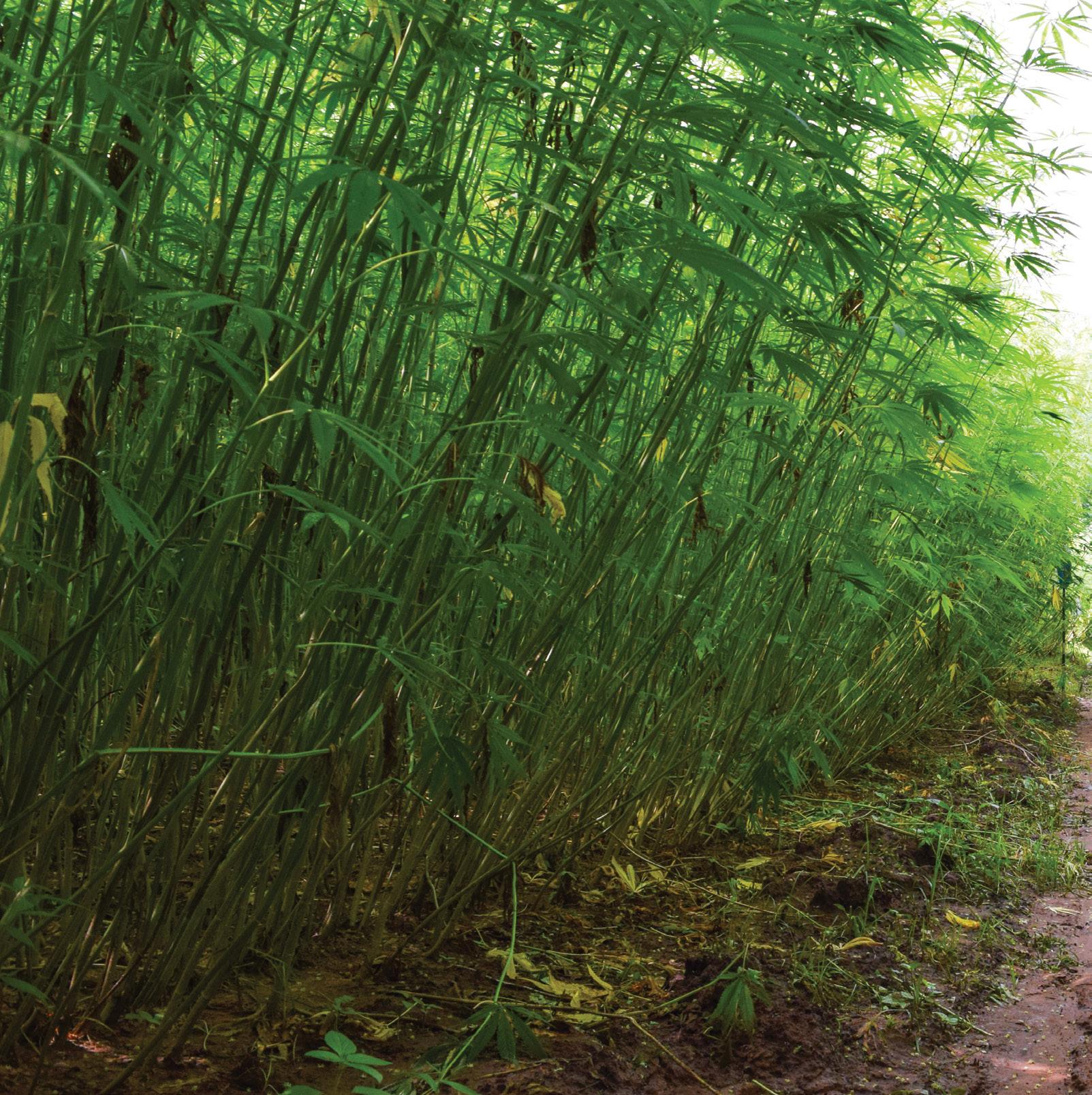 By Alex Fullerton, Hemp Save The World
By Alex Fullerton, Hemp Save The World

When you think about forests, what comes to mind? Are they simply a large group of trees, or something far more complex? From an anthropocentric (people-oriented) point of view, forests are perceived as a resource that provides people with material and non-material benefits. In contrast, from an ecocentric point of view, forests are perceived for what they are and how they contribute to the environment, independent of how people benefit from them. In my humble opinion, the true value of forests is a combination of all past, present, and future environmental, social, and economic benefits.
There is a colossal list of environmental benefits from forests, which collectively play a major role in maintaining life on Earth. The biodiverse ecosystems we see today are a product of forests' ability to: sequester carbon dioxide and absorb environmental pollutants, provide habitats and protection from the elements, rotate nutrients in soil and mitigate erosion, retain and filter water, and regulate regional temperatures and influence regional weather patterns.
Often taken for granted, there is also an extensive list of societal benefits from forests that play an important role in the long-term sustainability of cultures and societies. The act of pausing to reflect and appreciate forests rejuvenates us, as they provide us with: socio-cultural benefits (culture expression, generational sharing, knowledge and wisdom, and heritage), ethical benefits (intrinsic worth, stewardship, intergenerational equity, compassion, and social justice), spiritual benefits (sacredness, sanctuary, harmony, insight, purity, and peace), and aesthetic benefits (beauty, magic, majesty, natural state, and senses).
Perhaps the most obvious benefits from forests are those to our economy, as a vast array of goods we use and consume every day are derived from forests. However, a relatively new source of revenue has emerged from forests in the form of forest carbon credits – types of forestry projects eligible for generating ‘carbon offsets’ which may be bought and sold through voluntary and compliance carbon markets. Eligible forestry projects include afforestation, reforestation, avoided conversion, and improved forest management. These projects help preserve forests for carbon dioxide sequestration, and the exchange of their carbon credits serve to incentivize polluters to reduce greenhouse gas emissions.
By seeing nature through the lens of interconnectedness, our knowledge about the true value of forests will increase and so too will our perceived value of them. However, the continued exploitation of forests for short-term economic benefits has led to catastrophic levels of deforestation around the world, contributing to long-term negative consequences.
While not entirely due to humankind, the World Bank estimates approximately 10 million square km of forest has been lost since the beginning of the 20th century. According to the Intergovernmental Panel on Climate Change (IPCC), the most recent estimate of net loss of forest worldwide is 7.3 million ha/yr.
When we cut down and process our forests for the short-term benefits of our economy, we do so at the detriment of long-term environmental and societal benefits they provide - ultimately resulting in negative impacts on our economy in the future.
The most obvious consequence of deforestation is the risk of desertification of forest land if ecosystems aren’t able to fully recover. Desertification cripples Earth’s carbon, water, and soil cycles and the ability of
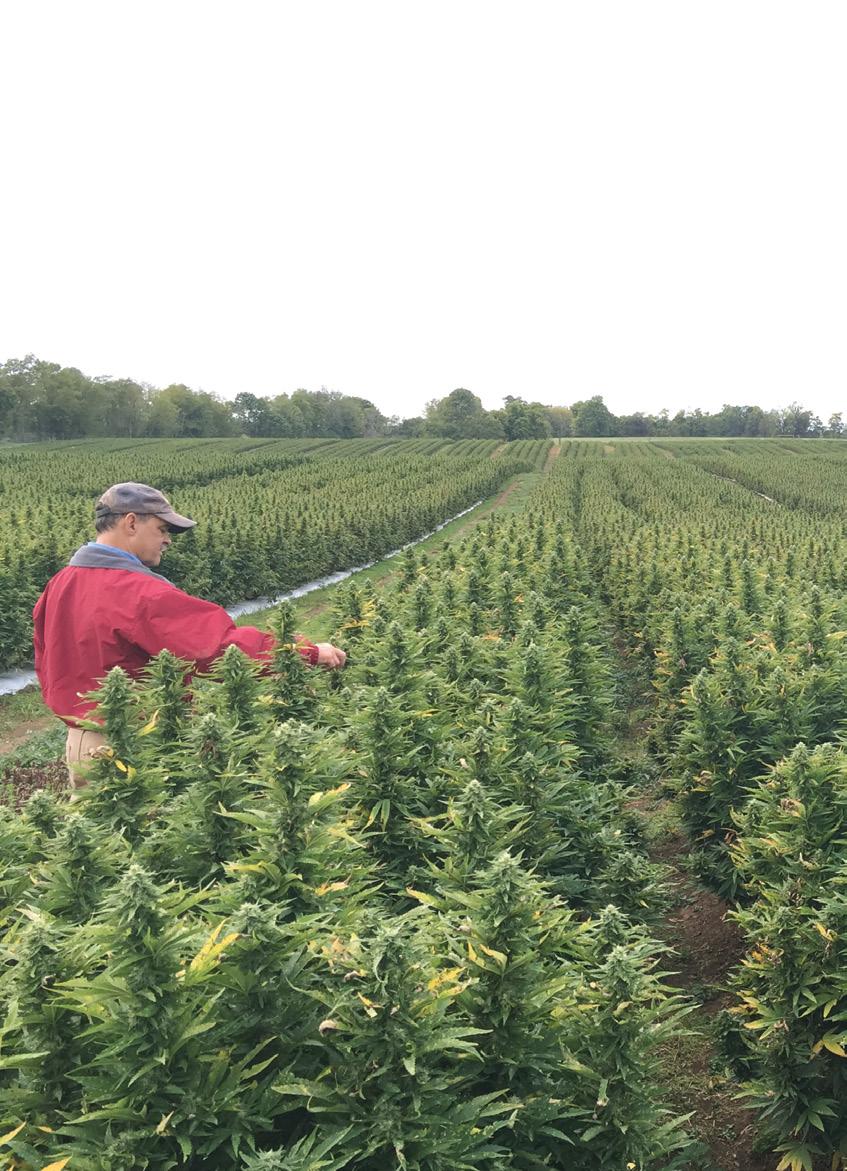
ecosystems to rejuvenate - accelerating global warming and changes in climates around the world. However, an equally, if not more, serious consequence of deforestation is the loss of millions of species due to the destruction of their habitats and food webs, as complex ecosystems, biodiversity, and symbiotic relationships maintain the delicate balance of life on Earth as we know it.
According to the Center for Biological Diversity, scientists estimate species are going extinct up to 1,000 times the natural rate and they predict more than one million species could face extinction in the coming decade. We are losing about one species every hour, never to be seen again. This is most concerning as the loss of any one species has a cascading ripple effect on nature, and losing key species will lead to catastrophic irreversible consequences to the environment, our societies, and our economies.
Considering the far-reaching benefits of forests and the severe consequences of not protecting them, there is an inherent necessity to reduce our impact on forests through conservation, education, and sourcing sustainable alternatives for the many products derived from trees.
Hemp fibre has very similar properties to that of wood, many products made using wood can actually be made using hemp since they both contain cellulose. Trees require 20-80 years to mature for harvest depending on the species, and average 32 (thinning) to 87 (clear-cutting) tons per acre. In comparison, hemp is an annual crop that takes an aver-
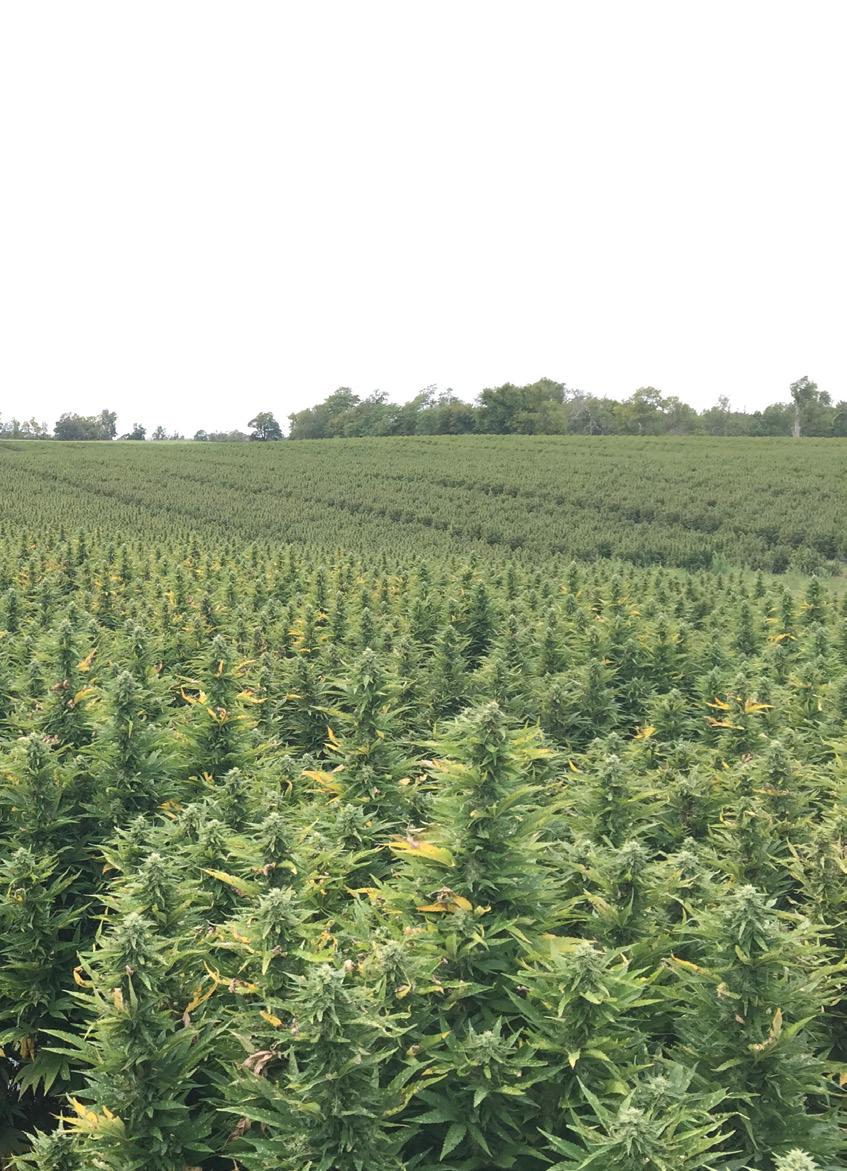
age of four months to mature for harvest, yielding on average ten tons per acre. Hemp’s rapid growth cycle allows for a more flexible supply of resources when faced with fluctuations in demand.
Wood fibres have a typical composition of cellulose (~45%), hemicellulose (~25%), and lignin (~25%). In comparison, industrial hemp stems are a source of two natural fibres: bast fibres (~30%) and woody core fibres known as hurds (~70%). Its bast fibres contain cellulose (~67%), hemicellulose (~12%), and lignin (~7%), whereas its hurds consist of cellulose (~44%), hemicellulose (~21%), and lignin (~22%). The U.S. Department of Agriculture derived that one acre of hemp produces four times the amount of paper than one acre of trees.
Lignin is an organic polymer that plays a crucial part in conducting water and providing structural rigidity in plant cells. It is also what makes paper yellow and brittle, both undesirable traits in paper products. Lignin is removed from pulp through the use of harsh chemicals (sodium sulfide, caustic soda, or acid bisulfite), which generates air pollutants such as particulates, nitrogen oxides, volatile organic compounds (VOCs), sulfur oxides, and total reduced sulfur compounds (TRS). After extracting lignin, wood pulp is then often bleached with chlorine to make it white.
Due to lower lignin content, hemp fibres naturally resist yellowing or browning with age, meaning hemp pulp does not require as intensive bleaching or chemical treatment as wood pulp. By switching to hempbased paper products, we could significantly decrease the number of toxins and chemicals used in the paper manufacturing industry and its

negative impact on our environment while preserving valuable forest ecosystems.
Did you know the average person uses roughly 130 rolls of toilet paper per year? That’s roughly one roll every three days, equating to about 384 trees within one’s lifetime! Since toilet paper is such a highly-demanded, commonly-used product, and because hemp yields more cellulose, switching to hemp toilet paper would have a monumental reduction in the impact we have on forests - not to mention the health benefits.
Conventional toilet paper has been known to cause allergic reactions, yeast infections, and swelling due to chemicals in the manufacturing process. Hemp on the other hand contains natural compounds that provide antibacterial and antifungal properties but also grant air permeability, high absorbency, and naturally soft fibres. These features make hemp great for sanitation and biomedical applications to prevent infection of broken skin.
Another example of how hemp can be used in the place of wood is fuel pellets. People around the world use wood to heat their homes. The majority of fuel pellets for pellet stoves and boilers are derived from wood due to its combustion qualities. The quality of fuel pellets are classified according to their quantity of ash residues: premium (<1%), standard (1-2%), and industrial (>3%). Both premium and standard grades may be used in commercial and residential applications.
Hemp fuel pellets have very similar combustion qualities to that of wood fuel pellets: only produce two percent ash content, do not pro-
duce clinker formations, and have similar ash melting temperatures and corrosive behaviours. These similar qualities, along with being a more sustainable raw material, make hemp fuel pellets a favourable alternative to wood fuel pellets.
While hemp-based paper products and fuel pellets are just some direct alternatives, hemp doesn’t stop there. Hemp can be used in the production of over 25,000 products. There is an awesome array of sustainable products in categories ranging from clothing and accessories, food and nutrition, health and beauty, home and office, construction, bioplastics, and biofuels. As the popularity of hemp continues to grow, so does the list of products that it can be made into.
Aside from sustainable, biodegradable products, it offers other solutions for combating climate change as well. It is one of the best crops for carbon sequestration in the fight against global warming, approximately 1.62 tons of carbon dioxide per ton of hemp. Its fast growth rate naturally makes hemp very competitive with weeds, resulting in little to no harsh herbicide requirements. While not aimed at preventing deforestation, there exists potential for hemp to remediate lands that have been devastated by wildfire and other catastrophes. When planted as a cover crop, hemp helps rejuvenate these lands by retaining water and nutrients, thus reducing soil erosion and nutrient depletion. It can also be used for environmental cleanup, as it proved successful when used to absorb heavy metals and radioactive strontium-90 at the Chernobyl nuclear power plant site - a process referred to as phytoremediation. So, why don’t we use hemp?
It is very important to provide the distinction between marijuana and hemp, as the two terms are often confused. The term ‘marijuana’ is vernacular slang for strains of cannabis that contain high levels of the cannabinoid THC, and provide a psychoactive effect when heated and consumed for recreational or medicinal purposes. The term ‘hemp’, also known as industrial hemp, refers to a uniquely bred subspecies of cannabis (Cannabis sativa L. ssp. sativa), which contains less than 0.3 percent THC, and cannot produce a psychoactive effect when consumed as it has a high level of another cannabinoid called CBD, which counteracts the effects of THC.
Hemp has been cultivated throughout history for many purposes. In fact, hemp is one of the first known human agricultural crops, dating back to pre-Neolithic times on the Oki Islands near Japan (8,000+ BCE). From ancient China’s Stone Age (~4,000 BCE) through the Qin and Hah dynasties (221 BCE to 220 CE), sowing, cultivation, and processing of hemp developed and became fairly advanced, producing various materials ranging from clothing, rope, food, medicine, and an early form of paper.
Various products have been made using hemp worldwide, including much of the world’s paper prior to the 19th century. However, the 1937 Marijuana Tax Act in the United States and the global War on Drugs prohibited the cultivation, processing, and distribution of industrial hemp due to its nearly indistinguishable characteristics from cannabis plants grown for marijuana. Hemp never fully recovered from the prohibition despite being touted as being on the verge of becoming a “billion-dollar crop” by Popular Mechanics in 1938 due to the recent improvements of the decorticator (a machine designed to mechanically separate the bast and hurd, significantly reducing labour). Many believe the prohibition was a political move driven by industry lobbyists intended to cripple the hemp industry, eliminating competition against
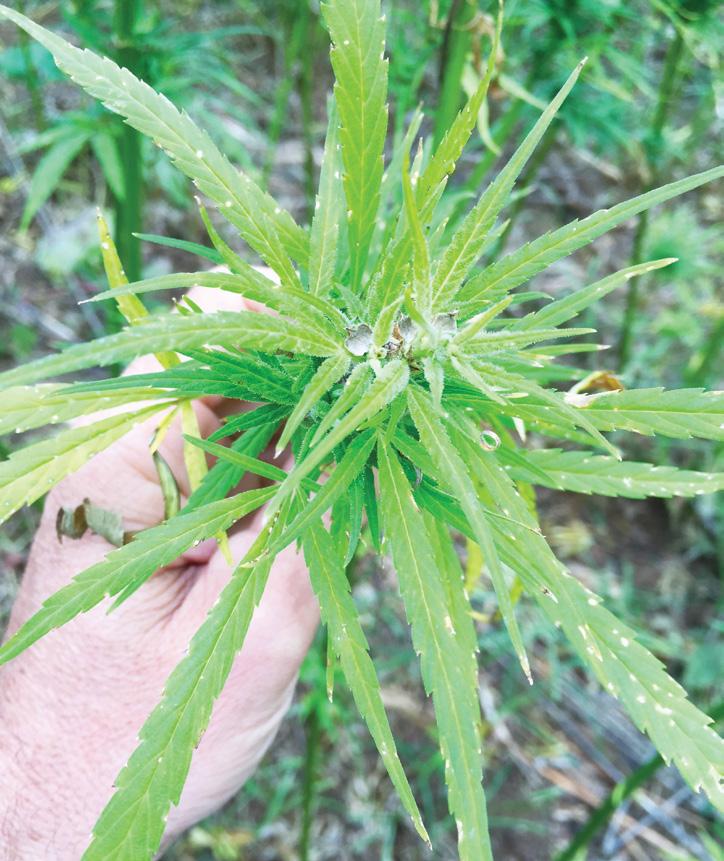
wood-pulp, synthetic fibres, and oil.
During the Second World War, through its “Hemp for Victory” campaign, the U.S. Department of Agriculture and the U.S. Army turned around and encouraged farmers to once again cultivate hemp due to the many products it could produce deemed essential for the war effort. It was a glimpse of hope for the hemp industry, however, after the war ended the government scrubbed the campaign’s existence from its records. Despite this, tremendous efforts have uncovered the campaign which can be found and watched on the internet today.
Hemp remained prohibited in Canada and the U.S. until 1998 and 2018 respectively. There is hope for the hemp industry today as fewer restrictions on hemp and a growing demand for hemp products have led to forecasts of the hemp market increasing from $4.6 billion in 2019 to $26.6 billion in 2025. However, hemp’s comeback won’t be easy, as many hurdles and barriers remain today and it is competing with industries that have been granted a 60-80 year head start.
We can all help combat the climate crisis by decreasing the impact we have on forests and the biodiversity they provide, and by preserving forests’ ability to absorb carbon dioxide. An opportunity presents itself to alleviate demand for wood products by transitioning to hempbased alternatives. Leveraging this opportunity requires revitalizing the hemp industry and local processing capabilities, overhauling the pulp and paper industry, and educating consumers about the many benefits of hemp - ultimately increasing both the demand for and supply of hemp products.
I encourage you to try substituting hemp-based alternatives for treebased products as a simple way to contribute towards a more environmentally, socially, and economically sustainable future.


Reduce your impact on forests by switching to sustainable alternatives. By alleviating demand for wood products, we can all help preserve forests’ ability to absorb carbon dioxide and help combat the climate crisis. Hemp can be used to make over 25,000 sustainable products ranging from clothing and accessories, food and nutrition, health and beauty, home and o ce, construction, bioplastics, and biofuels.


Oh the Holidays. A time for cheer, family, friends, and giving. Though the holiday season brings joy and wonder, it’s also a critical culprit in the creation of unnecessary waste.
Did you know, Americans throw away 25 percent more trash during the Thanksgiving to New Year's holiday period than any other time of year? The extra waste adds up to 25 million tons of garbage, or about 1 million extra tons per week!
When you take into account gifts, wrapping, food and leftovers, decorations, and more, your festive footprint can be shocking. Thankfully you can celebrate the holiday season in a way that is just as sweet as it is sustainable, by greening your holiday routine.
A wonderful way to minimize waste during the holidays is by reframing your mindset on gifting. There are many alternatives to gifting material objects, such as gifts of experience or donations. Shopping locally and making your own gifts are also creative ways to show you care.
Gifts of experience offer a tailored, customized gift, and can create memories that will last a lifetime. Skip the landfill and plan a fun outing or a cozy day in. Here are a few ideas for inspiration, although maybe some of these are better suited to a non-COVID-19 world:
• Tickets to a concert, show, or ballet
• Cooking class
• Hot cocoa and skating
• Mini golf or bowling
• Indoor archery or axe throwing
• Baking and movie night
• Yoga and brunch
This holiday season consider making a donation to a charitable or non-profit organization in honour of an important person or group of people in your life. Choose a cause that is close to your heart or theirs. There are many ways to give and support important charitable work; every gift is meaningful, and every dollar helps. Keep it green by opting out of receiving material goods for your donation. Your generous support can have a big impact!
Support small businesses, local makers, and artists by looking to them for gifting inspiration. Your friendly neighbourhood business can offer you a personalized shopping experience, one-of-a-kind products, and items that are either made or sourced ethically. Shopping locally with your dollar also means the money is being circulated through your local economy. This can help better the health of your community, and keep investment for the future. Not to mention, shopping local or heading to a crafters market decreases shipping waste and allows you to shop package-free. Don’t forget to take your own bag!
If you’re the crafting type, a creative option for gifting is making your own. Whether you have a skill such as knitting, crochet, painting, or otherwise, your loved ones would be happy to get a gift that showcases your talent. Other do-it-yourself or “DIY” gifts could include baked treats, upcycled items, or simple care products like soap, lip balm, and scrubs.
Sourcing a gift second-hand helps to prevent items from being sent to the landfill and offers them a new life. Visit your local thrift shop to browse gently used items that could easily be cleaned and rehomed.
Now that you’ve explored some inspiration for your gifting, it’s time to consider some of the finishing touches. Often, wrapping paper is used only once and thrown away. This single-use item as well as ribbon, bows, and other gifting accessories contribute to the more than 540,000 tonnes of waste created by Canadians during the holiday season. To avoid this unnecessary waste, consider gifts that don’t require wrapping at all, or explore some of our green suggestions.
Paper is a simple and effective option for wrapping gifts in a way that is environmentally mindful. Upcycle paper such as magazines, the newspaper, or comics you likely have in your home already. Personalize the packaging using homemade stamps or messaging.
• Newspaper
• Brown kraft paper
• Comics or magazine pages
• To secure paper in place, use washi tape, a plastic-free alternative typically derived from bamboo or hemp.
Give your friends and family the gift of reusing! Boxes have many great uses, like storing items in your home or they can be reused and gifted to someone else in the future. Tote and cloth bags also make for a fun and uniquely-wrapped gift that can be reused for shopping, groceries and produce, bulk buys or snacks on-the-go.
Looking for forest-free options? Wrap without paper using the Furoshiki technique, using cloth to bundle gifts. Preloved material, an old bandana or other fabric cloth will do the trick.
If secrecy for the gift isn't a concern, consider upcycling a container or jar to enclose your present. The simplicity of a jar offers a minimalist approach to wrapping, while giving the gift of reuse.
To finish off your wrapping, you can spruce up the look by adding a few accessories. Some ideas to consider include:
• Twine and string
• Burlap
• Greenery
• Pinecones
• Cinnamon sticks
• Dried orange slices
• Lace
• Wooden buttons
This holiday season, we encourage you to indulge in giving the gift of green. Use these sustainable alternatives to minimize your gifting and wrapping waste while inspiring others to do the same.
If you’ve ever wondered whether real or fake Christmas trees and greenery are more eco-friendly, you may be surprised by the answer.
Although fake trees and greenery can be reused for multiple years, the manufacturing process for these artificial decorations is highly energy-intensive. The majority of fake trees and decor are made from polyvinyl chloride, better known as PVC. The process to create and manufacture PVC includes using energy and resources such as water, salt, and oil. When fakes trees and greenery come to the end of their life, these items are hard to recycle and end up in landfills. These items are also likely created and shipped from overseas locations, meaning additional energy, resources, and materials were used to ship and transport the item to you.
If you already have a fake tree, take care of it and use it for years down the road. By storing it properly and getting creative to decorate worn areas, you can prolong its life, keeping it out of the landfill.
Needless to say, opting for a real tree and real greenery is the most eco-friendly option for the holiday season if you are able to source them locally in your area. Not only will your home smell fresh and crisp, but it also offers an opportunity to create a new fun family tradition spending the day searching for the perfect tree, in nature or at a farm. Some of the benefits of using a real tree include:
• While the tree is living, it absorbs carbon dioxide helping to curb climate change.
• Rather than cutting down a tree, consider purchasing a local potted Christmas tree that can be replanted after the holidays.
• When the holidays are over, real trees can be returned back to the earth either as mulch, compost, or a temporary home for birds.
If real trees aren’t an option in your area, consider sourcing an artisanal tree made locally that can be used for years to come.
This season, you can green your holiday routine by considering these tips for gifting, wrapping, and trees or greenery. To reduce your waste further, you can:
• Remove yourself from mailing lists - it’s likely you will receive a large number of catalogs, flyers, and mailings, especially during the holiday season. Create a simple “No Junk Mail” sign for your mailbox or remove yourself from mailing lists to avoid this waste.
• Opt for sustainable holiday cards - avoid glossy, foil, shiny, or glitter-filled holiday cards. These cards are difficult or unable to be recycled, meaning they are destined for the landfill. Instead, look for recycled cards, make your own, or send electronic cards as an alternative. Another option is to let your friends and family know that you are going card-free altogether. Instead of spending money on cards, consider donating the spare funds to a charity or nonprofit you support.
The holiday season may look a little different this year, but it is no reason not to celebrate! Green your holiday routine by reframing your mindset on gifting, exploring options for waste-free wrapping, and considering areas you can reduce your waste.





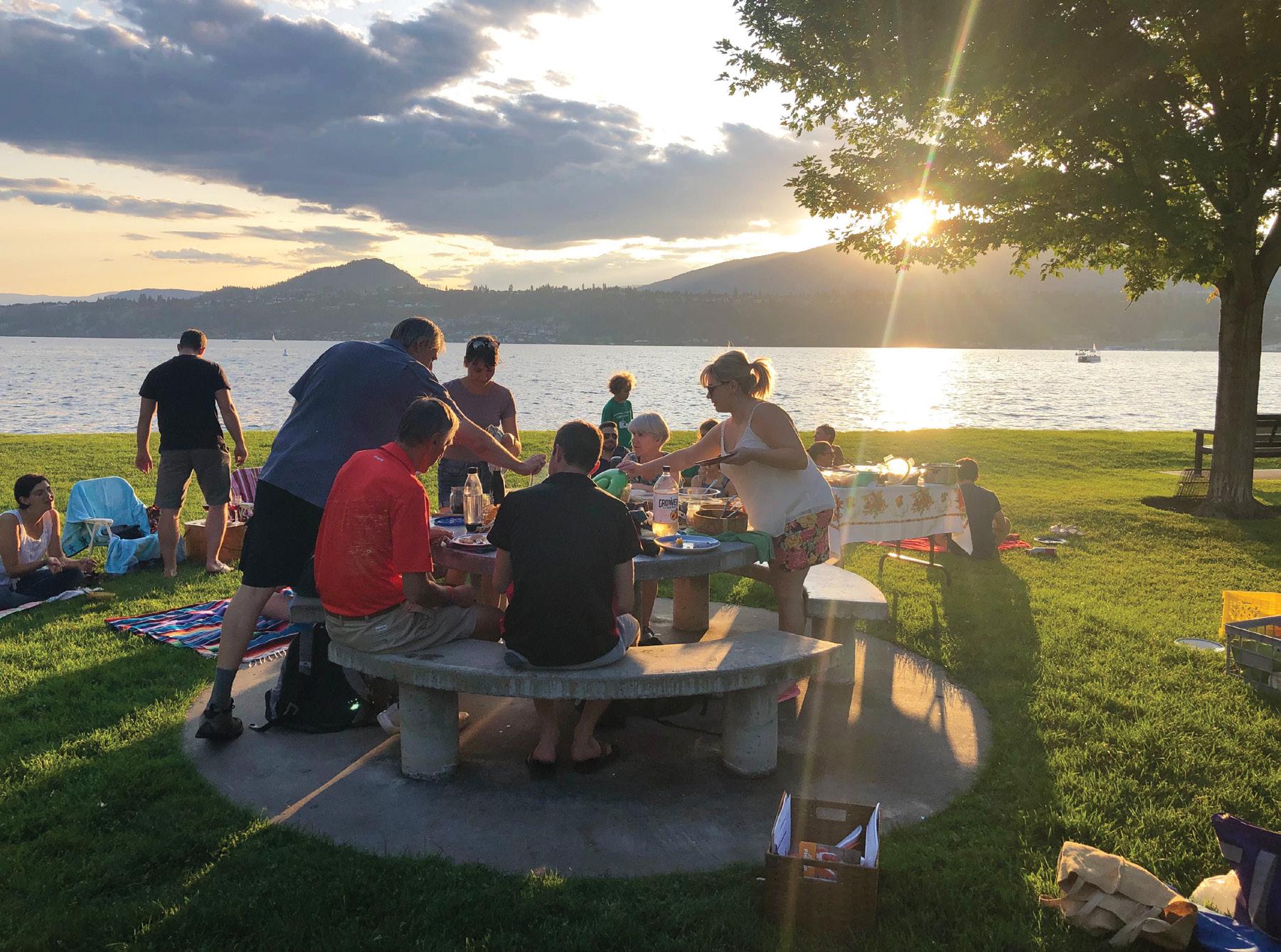



















We break it down in an approachable way, with simple and affordable solutions anyone can implement. Join our online community for free resources that’ll help you simplify your life and improve your sustainability.


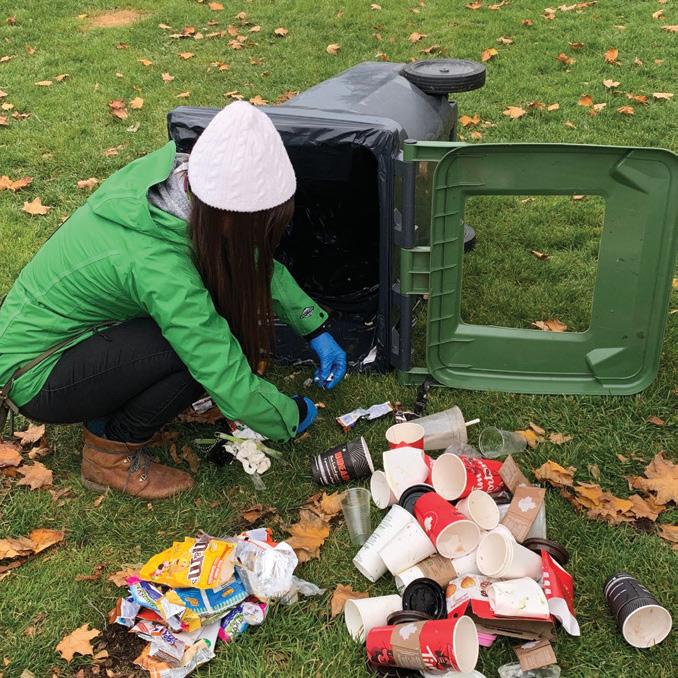

Local to the Okanagan?
GREEN OKANAGAN, or GO for short, is a volunteer-led registered non-profit organization based in the beautiful Okanagan, in Canada. Our mandate is to progress sustainability from an individual level. By sharing our own experiences and easy to implement tips and tricks, we hope to empower you to make smart consumer choices and adapt your lifestyle to improve your overall sustainability. @GreenOkanagan






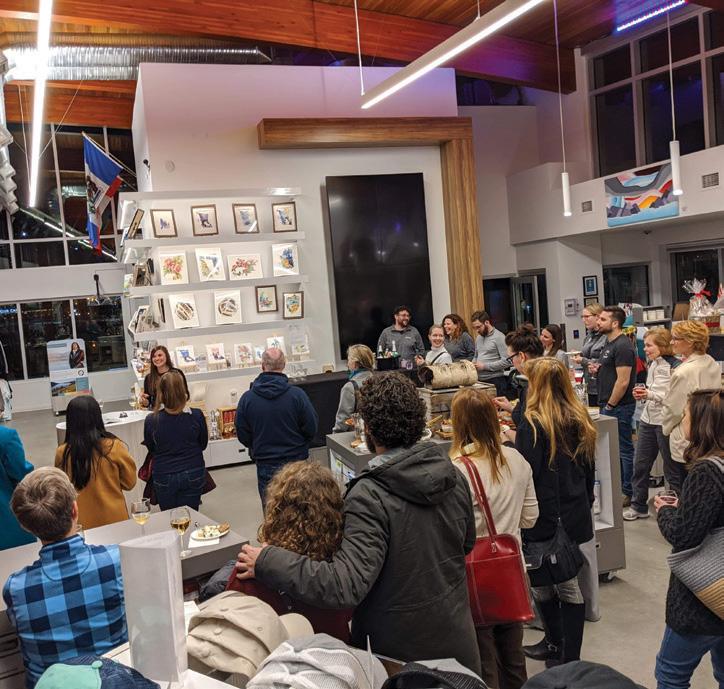





Join us at our next event or workshopall are welcome in the GO community!


VISIT: WWW.GREENOKANAGAN.ORG FOR ALL THE DETAILS!























 BY INGRITH LEÓN
BY INGRITH LEÓN
There is a direct link between our lives and the lives of trees. We give trees carbon dioxide to fuel their growth, and they give us the oxygen we need to survive. We are so connected, that the air we breathed out a few years ago may be part of a branch, a leaf or the bark of a tree right now. Trees are important because they are among the biggest types of plants, and as plants, they purify and clean the air by reducing air pollution as they absorb and break down most of the major air pollutants such as ground-level ozone, sulfur dioxide, nitrogen dioxide and carbon dioxide.
Trees and plants are extremely sophisticated. They have brilliantly adapted to almost every planetary condition in order to make the most of their surroundings, because unlike us, they grow and stay in the same place.
These adaptation processes turn out to be a remarkable piece of technology that has been evolving since multicellular organisms first appear on earth over 2.4 billion years ago, when cyanobacteria, a photosynthetic bacteria, gradually started producing oxygen. A mass extinction of anaerobic bacteria occurred due to these rising levels of oxygen in an event known as the Great Oxidation Event (GOE), and this helped set up the next stage of life: more complex organisms like the animals and plants we are familiar with today.
Made out of only a few minerals and three basic ingredients: water, sunlight and carbon dioxide, trees, like other plants, have the ability to turn these ingredients into food for their own growth, and their waste product is something we find very useful. This unique chemical process, called photosynthesis, is used not only by trees and other plants, but also algae, protists and some bacteria. It is a biological marvel.
For us, the production of oxygen is a beneficial result, however, it is not the main purpose of this process of photosynthesis for the trees or plants. Oxygen is a simple byproduct of absorption of carbon dioxide and sunlight, and the production of the carbohydrates that trees and plants need to feed themselves in order to grow. Who would have thought that tree and plant waste would be what makes human and animal life possible? This question surely makes us rethink our place on our planet.
Not only do we understand how trees and plants grow, but with the latest technology, we can actually see how they do this and other processes, cell by cell. Scientists have studied photosynthesis for years and there are many innovations that have resulted from these studies. In the field of fuel production, for example, by learning how plants and trees use sunlight’s energy, we could create a fuel liquid in a short period of time, meaning that conventional methods to produce fuel, can be replaced by greener ones.
The interest in science to unravel how trees and plants go through this process started back in the late eighteenth century, when a series of experiments were embarked upon to investigate gases, observing how by keeping plants inside bottles filled with water and exposing them to sunlight, bubbles started to emerge and gather on the surface of the water. That gas was able to ignite fire, indicating it was oxygen.
Then, in the mid nineteenth century, when a new generation of microscopes were more widely available, scientists discovered by looking in the inside of the leaves there were small solid structures within each cell, and that starch was being produced there.
Today, with better microscopes, we can observe the main functions happening in a plant at a different level, and we can also under-
stand what happens at each of the steps of photosynthesis and the relationship of this process with the production of oxygen.
Let's imagine we are looking at a leaf under a microscope. Under the epidermis, we find the key to the harnessing of the sun's energy: chloroplasts. These organelles found in most plant cells, act as collection centres, which move to control light exposure in a process called photorelocation. The never-ending dance of the molecules helps the plant take in just the right amount of light. Chloroplasts get their green colour from pigment molecules called chlorophyll.
At a molecular level, when photons from sunlight hit a chlorophyll molecule, the electrons inside the chloroplasts get excited and move towards a reaction centre to become a charge; in other words, energy that can be stored until it can be used. The principal molecule for storing and transferring energy in plant cells, as well as in animals, is called Adenosine 5-triphosphate, or ATP. This stored energy by chloroplasts not only helps the plant grow, but also fuels the production of leaves, flowers, seeds, fruit, and the following generation of plants and trees.
By observing the epidermis of the underside of a leaf, we find tiny openings or pores called stomata. These pores are bordered by a pair of parenchyma; a specialized type of cell, known as guard cells, which open and close constantly to regulate the amount of carbon dioxide that enters the tree or plant from the air around them, and also to release oxygen.
Roots also play an important role in photosynthesis, as they are in charge of pumping water - and the oxygen in it - as well as minerals, to the leaves of the tree and plant, where this process takes place.
Understanding these key players of the plant function is essential to understand the process of photosynthesis.
At the first stage, the energy from the sun that is stored in the tree or plant’s ATP molecules acts upon the water absorbed by the roots by splitting the hydrogen from the oxygen.
At the same time, carbon dioxide is absorbed by the leaves through stomata, and by pairing it with the hydrogen and minerals absorbed by the roots, carbohydrates, fats, proteins and starches that are crucial to sustain plant life are created.
In the end, the extra oxygen created during this process is released into the atmosphere; a crucial event for all the other living organisms that depend on it to breathe. The cycle continues when these other organisms release CO₂ through their own respiration process, providing this gas to trees and plants again.
While it may appear that a tree’s leaves are static, actually, they’re working at one of the most efficient production systems in nature, continuously sustaining life on our planet.
The respiration process of trees is the opposite of photosynthesis and it happens both day and night. During this respiration process, oxygen is taken in and carbon dioxide is released, just as animals do. Plants use their stems and roots for this process rather than their leaves.

On our planet, there are around 3.1 trillion trees. Counting all the leaves of those trees and knowing what they are capable of doing collectively to the air in the atmosphere, we can see that the effect is stunning.
Annually, trees around the world take carbon dioxide and clean the air. The rate of cleaning the air is greater during the warmer months when trillions upon trillions of leaves open, grow and begin to breathe deep.
From all the carbon emissions brought by the use of fossil fuels worldwide, trees and other plants take up about 25 percent, reducing greenhouse gas emissions into the atmosphere. However, as global temperatures rise, the contribution from plants and trees may decline given that they will need to breathe more as the world warms, and their ability to absorb carbon dioxide through photosynthesis could also be compromised.
Human activity directly affects how oxygen is produced. As we expand our urban sprawl, the land where once trees used to grow and purify the air, is now occupied by concrete and cars, diminishing the quality of the air we breathe and increasing global temperatures.
CO₂ is good for plants up to a point but research shows that the rising levels we are seeing have a negative impact on many of our food crops, reducing the concentration of protein and minerals and therefore, the quality of what we eat.
Our planet has its own system where everything needed to ensure life is produced. Protecting this delicate balance is crucial, and by understanding the processes and components of our global ecosystem, not only do we develop a better understanding of our own place within it, we will hopefully become more involved with ensuring the preservation of it.
Remembering how all organisms are connected and how vulnerable or powerful they can be leaves us with an urgent need to take action. Trees are already doing their part.
Ingrith León is the Coordinator of English at a primary school in Mérida, Mexico. She is also part of Cero Basura Yucatán, an organization that educates people about sustainable living. Ingrith has brought her passion and knowledge for sustainable living to her school’s English curriculum and was busily transforming her school and the lives of her students until coronavirus closed schools and learning went online. Here she tells us how even during a pandemic, English classes for these Mexican children continued to focus on environmental education.
Citrus Aurantium tree. photograpy:Ingrith León BY TARA PILLING, you are not alone. Many of us have been brought up to look outside of ourselves for solutions but perhaps the answers to our problems lie within. It is possible that the cultural, parental, or societal ‘norms’ that we were taught are what are holding us back from achieving our true potential. The beliefs that many of us hold about who we are, what we can do, and the purpose of our lives may be in opposition of who we really are.

I want to introduce to you the ‘Acorn Principle’. My mentor, Bob Proctor, taught me about this principle many years ago. Through this I discovered that there was so much more to me than I was taught. The Acorn Principle, formerly known as The Acorn Theory, was conceived by James Hillman, a noted psychologist at the C.G. Jung Institute in Zurich. In Hillman’s bestselling book, The Soul’s Code: In Search of Character and Calling (1996), he proposes, on the question of character and destiny, that our calling is in fact inborn, and that its mission in life is to realize life’s imperatives. The imprint can be seen to exist as a particular image, which itself is informed from a sea of subconscious information and archetypes – the building blocks of the psyche, “just as the oak’s destiny is contained in the tiny acorn”.
In 1998, author Jim Cathcart would go on to pen The Acorn Principle: Know Yourself – Grow Yourself, a self-help book that focuses on self-exploration. It asks, what is the seed of your being? In other words, what are your natural talents and skills? In finding these, under the right conditions and circumstances, one can find happiness, success, and peace.
Sounds simple enough, however, self-exploration is often hindered by what others may perceive us to be, creating belief systems within us that prevent us from following our true path.
How many times were you told that you had to become something? Whether it was in a career, marriage, or working the nine-to-five treadmill, we often follow the path that was suggested to us from those that we love or the society we live in. The Acorn Principle suggests that “the acorn” already has everything within it to become what it needs to be. This signifies that when we are true to our deepest selves, rather than a limited self-concept, we have the ability to activate our inner-potential, to create the greatest life possible, to become anything we choose. In a sense, follow your heart.
The Law of Emergence, coined by supercoach Derek Rydal, like the Acorn Principle, suggests that every condition is experienced internally. And like the acorn, the self has everything it needs to fulfill its higher purpose or destiny. In essence, your true desires are who you are meant to be, and anything other than that will lead to some sort of misery.
For me, actively engaging in the wilderness and the natural world has brought me an inner confidence and sense of purpose on this planet. Working with people, and helping them improve their lives and reach their goals is fulfilling to me, and part of who I am. If I listened to the opinions and beliefs of other people, I would not be where I am today – living my best life. What are your dreams? Are you fulfilling your destiny? Who is the acorn in you?
Tara Pilling Certified Consultant with Proctor and Gallagher Certified Infinite Possibilities Trainer Holistic Results Coach - Yoga - Ayurveda
TARA@TARAPILLING.COM

